Talking Agronomy
‘Spring crops have been drilled into the best conditions’































SOIL HEALTH

Getting to the root of healthy soils

Pages 21-23
FARM ROBOTICS
Robots take to the field at FIRA


Pages 55-59



BREAK CROPS
Grain maize finds favour as a spring break

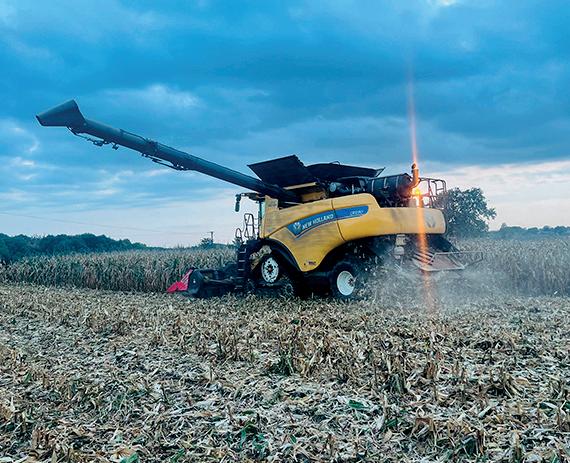
Pages 60-61



Use plant protection products safely. Always read the label and product information before use. For further product information including warning phrases and symbols refer to www.agricentre.basf.co.uk. Revystar ® XE contains mefentri uconazole (Revysol®) and uxapyroxad (Xemium ® ). Revystar ® XE, Revysol® , and Xemium® are registered Trademarks of BASF. ©BASF 2023. All rights reserved.
drink more tea from a ask than a mug, spring will feel busier every year, and Revystar ® XE will protect my wheat at T1. Innovation in action for progressive arable farmers
I’ll
Page 14
April 2023
46 Issue 4
Volume
NEW
WRITER
YieldON switches “ON” crop profitability. This revolutionary biostimulant contains a unique blend of natural plant extracts – which stimulate the flow of nutrients into seeds for higher yields. In UK trials over 3 years, YieldON increased wheat* yields by 0.47 t/ha on average Oilseed rape** and barley* trials showed yield increases of 0.33 and 0.37 t/ha respectively

YieldON is available from Hutchinsons (www hlhltd co.uk) and Agrii (www.agrii.co.uk)
For further information, email technical.uk@valagro.com www.valagro.com
*single application of 2 litres/ha at flag leaf growth stage; **single application of 2 litres/ha between early to mid-flowering.
Comment
10 Talking Arable
Using the ‘R’ word has become more triggering than a football pundit’s tweet
14 Talking Agronomy Inclement weather has put an end to the early start made by many
20 Talking Roots
We must take IPM on board across all areas of cropping
64 Talking Policy
Oilseed rape prices may now be below the cost of production
Technical
30 How monitoring soil carbon can help boost productivity on farm
Soil carbon content is more than just a number for Cheshire mixed farming business Grosvenor Farms
32 Are fungicides still working? Ongoing monitoring is keeping track of resistance developments in disease pathogens

34 Crop management platform delivering efficiencies in the potato supply chain Three potato growers explain how Crop4Sight is helping support agronomic decisions on farm

36 How the 2022 YEN OSR winners achieved their success Rotation, variety choice and livestock were included in the winning recipes
44 The drive for gene editing in sugar beet
British Sugar is working to exploit the potential for GE sugar beet in the UK, NFU Conference heard

Research and development
46 Long-term monitoring highlights safety of UK grain
UK grain is safe and AHDB-funded Fera monitoring is providing the data to prove it
Machinery
48 New vision for root crops
How root crop growers could benefit from the latest technology for harvest and post-harvest operations
55 Robots take to the fields at FIRA
Some of the latest developments in agricultural robotics were showcased in working demos in France recently
62 Established manufacturers cultivate new ground
New acquisitions see Kverneland and Vaderstad move into mechanical weed control solutions
Podcast
65 What is the future for agricultural water use?
The Arable Farming team finds out how we can make UK agriculture more water-secure
BASIS news
66 Spotlight on farm safety
A new training module from BASIS is focused on farm safety
REGULARS 3 APRIL 2023
CONTENTS:
APRIL 2023 VOLUME 46
48 34
In this issue of 32
40
21 Regenerative farming
Soil health
Why international soil guru Joel Williams believes living roots are important

24 Technical
Agronomy
His approach divides opinion, but Lincs grower Tim Lamyman knows how to grow big crops

40 Arable people
Farming systems
Why musician-turned-farmer Andy Cato wants to change the way we farm
52 Machinery
On test
We put the Horsch Focus 3TD strip-till drill through its paces

60 Machinery
Break crops
An opportunistic venture into grain maize is paying dividends on one Midlands farm
CONTENTS: FEATURES 4 APRIL 2023 21
52
a word from the editor
Contacts
Group Editor – Arable
Teresa Rush 01787 282 822 teresa.rush@arablefarming.com
Senior Arable Technical Specialist
Alice Dyer 07966 445 458 alice.dyer@arablefarming.com
Arable Technical Specialist
Ash Burbidge, 07786 190 188 ashleigh.burbidge@agriconnect.com
Machinery Editor
Toby Whatley 07583 054 831 toby.whatley@arablefarming.com
Head of Creative Services
Gillian Green, 01772 799 417 gillian.green@agriconnect.com

Picture Editor
Marcello Garbagnoli 01772 799 445 marcelllo.garbagnoli@arablefarming.com
Key Accounts Manager
Jane Newton 01948 780 783 jane.newton@arablefarming.com
Key Accounts Manager
Mark Jackson 01322 449 624 mark.jackson@arablefarming.com
Account Manager
Chris Knowles 01772 799 550 chris.knowles@agriconnect.com

Sales Director
Mike Hartley 01772 799 532 mike.hartley@arablefarming.com
Advertising Production
Justine Sumner 01772 799 437 justine.sumner@arablefarming.com
For circulation queries, to request a copy or subscribe, please contact Emma Williamson 01772 799 452 emma.williamson@arablefarming.com
Subscriptions
Contact: 03303 330 056 help@subscribe.farmers-guardian.com
© Agriconnect 2023
All rights reserved. No part of this publication may be reproduced or transmitted in any form or by any means, electronic or mechanical including photocopying, recording, or any information storage or retrieval system without the express prior written consent of the publisher.
The contents of Arable Farming are subject to reproduction in information storage and retrieval systems. ISSN 0269-6797

As this issue goes to press, news is just through of the Bank of England’s decision to raise interest rates for an 11th consecutive time in a bid to curb inflation. This follows a surprise jump in inflation in February.
An 18.2% increase in food and non-alcoholic drink prices, the highest in 45 years, according to the Office for National Statistics, was among the main drivers of that jump. But the question facing us all is this - are our higher food prices still too cheap?
Consumers may be facing empty shelves, but back on-farm, as costs of production overtake returns and agflation bites hard, growers are taking the difficult decision not to plant crops — for most a decision of last resort.
Few of us could have predicted that an advanced economy such as the UK’s would, in the first quarter of the 21st century, be faced with food security challenges.
Disconnected
Evidently as a society we have become complacent, disconnected from where our food comes from and too willing to rely on imports.
It is time for a reset, call it a revolution if you are so inclined, but however it is framed, farmers and growers must be front and centre.
UK Agriculture plc is among the best in the world, not just in terms of its ability to produce (p24-27, p36-38, p46-47) but also in its willingness to question, experiment, innovate and adapt (p21-23 and p40-43)
What we are seeing as a society is a massive wake-up call that food and farming matter. We ignore it at our peril.
Innovation and technology underpin the success of UK agriculture and, as always, Arable Farming has
sought out on-farm evidence of this to share with readers. Unheard of a few short years ago, soil carbon monitoring is now helping to inform wider farm business management decisions (p30-31).
Farm robots are taking to the fields in ever-increasing numbers (p55-59), while developments in optical sorting technology are driving efficiency improvements in the root crop sector (p48-51).

It is always a pleasure and a privilege to report on developments in British farming, but as a business we like to recognise and celebrate its achievements too, with our annual British Farming Awards (p28-29).
Entries for the 2023 awards are now open at britishfarmingawards.co.uk. We hope you will join in the celebrations.
9NZ 55 www.croptecshow.com November 29-30, 2023 5 APRIL 2023 Origination by
Published by Agriconnect. Printed by Precision Colour Printing, Halesfield 1, Stirchley, Telford TF7 4QQ. No responsibility can be accepted by Arable Farming for opinions expressed by contributors.
Arable
Farming, Unit 4, Fulwood Business Park, Caxton Road, Preston, Lancashire PR2
Farmers Guardian, Unit 4, Fulwood Business Park, Caxton Road, Preston, Lancashire, PR2 9NZ.
Radical change was on the agenda at the Leaf Conference, the first since the pandemic and the death of founding chief executive Caroline Drummond last year. Cedric Porter reports.
A rallying call for change
This year’s Leaf Conference included the inaugural Leaf Lecture, which aimed to provoke thinking,

explore the future and challenge conventional wisdom.
It was given by Prof Mike Berners-Lee, brother of Tim Berners-Lee, the developer of the worldwide web, who himself
is a world-leading expert on carbon management with a consultancy company called Small World, spun out from his work at Lancaster University.
He began by highlighting the carbon emissions challenge.
“As a world, we are still emitting four times as much greenhouse gas as we did 60 years ago. The rate of increase may have slowed, and emissions even fell during the pandemic, but there are no signs of a significant drop,” he told the conference.
The Intergovernmental Panel on Climate Change (IPCC) has estimated that between 21% and 37% of greenhouse gas emissions are from the food system, with agricultural production and the change in land use –including deforestation – for food responsible for the majority of emissions.

There is no issue with lack of food, said Prof Berners-Lee, with the equivalent of an
average of 9,747 kilocalories per person per day being produced, when the average need is 2,500kcal/person/day. That ranges from almost 20,000kcal in North America, to 10,000kcal in Europe, to little more than 3,000kcal in Sub-Saharan Africa.
Of the near 10,000kcal/ person/day produced, more than half is grown as edible crops, with 3,800kcal eaten by farm animals as grass or other pastureland. However, farm animals eat 1,738kcal of these edible crops, while only converting 594 or 11% of the 5,550kcal they eat in total into calories for human consumption. Reducing meat and dairy consumption is important, he said, including using less edible crops to feed animals..
“We have all the tools to ensure the survival of mankind and to further reduce carbon emissions over the next few decades, but we need as much new thinking as we can. Shifting
6 BUSINESS APRIL 2023
Production and consumption of food in calories/person/day Edible crops grown Grass and pasture eaten by animals Edible crops fed to animals Losses and over onsumption Non-food uses Seed Net consumption by animals Human consumption of crops Contribution from meat, dairy and fish Calories 7,000 6,000 5,000 4,000 3,000 2,000 1,000 0
5,935 3,812 1,738 1,256 808 126 594 4,956 1,937
SOURCE: Prof Mike Berners-Lee
The Leaf Conference heard how the Ken Hill Estate in Norfolk is aiming to boost its soil fertility.
Lasting legacy
JLeaf used the conference to showcase its achievements over the last year. These include the addition of Rothamsted Research as a Leaf Innovation Centre and new demonstration farms in Aberdeenshire, Hampshire and Berkshire. Lidl has joined Tesco and Waitrose in adopting Leaf Marque standards as a requirement for its fresh produce suppler. Meanwhile, Leaf Education worked with
to more climate-positive farming solutions presents a huge intellectual challenge – deciding what to grow and what is the right thing to do on any given piece of land.”
Making that change will require significant government support and guidance, said Prof Berners-Lee.
Long-term regeneration
A radical change is already being made on the 1,630-hectare Ken Hill estate in Norfolk. Its director Nick Padwick told the conference how the business is now split into three parts – a nature reserve, rewilding, and a regenerative farming enterprise. He told the conference there is a long-term aim to increase soil fertility using composting.
nearly 38,000 young people and Open Farm Sunday saw 250 farms welcome 175,000 visitors, with 60 of the farms taking part in the event for the first time.
Launched
Two initiatives have been launched to remember and continue the work of Caroline Drummond MBE. The Caroline Drummond Award, which celebrates and communicates
Although he admitted the wheat yields remained below the seven tonnes a hectare the farm was achieving previously, he said the previous, conventional approach to production was not making money.
“We are looking for long-term resilience on the farm so that it is economically and environmentally sustainable when direct supports are fully removed,” he said.

“That approach is already allowing us to access new sources of funding.”
He described the changes already being seen in the soil.
“That is having a significant impact on soil health. In the middle of January, we measured some normal untreated soil [using] a range of health
Caroline Drummond
farm excellence - is looking for someone who has not only improved the way they or others farm and enhance the environment but has communicated that to others. The award is supported by the
indicators. The fungi count was 97 per square metre, when the range should be 135 to 1,350/ sq.m. The bacteria count was better than the recommended amount at 2,126/sq.m. Protozoa content was a little over the recommended 50,000 mark.
“But while soil treated with compost extract had a similar bacteria content, the fungi rate was almost three times higher and there were five times the number of protozoa. Meanwhile, soil treated with compost and compost extract delivered 710 fungi/sq.m, a third more bacteria and almost 10 times as much protozoa.”
Ken Hill has introduced extensively reared pig and cattle onto the estate. Pigs prefer rooting in fallow, marginal land
British Guild of Agricultural Journalists and the Institute of Agricultural Management, and the deadline for entries is July 31, 2023.
In addition, the Caroline Drummond Memorial Trust Fund will provide a Sustainability Innovation Award annually to further research into climate resilience, more robust food production, and initiatives that deliver educational or societal benefits.

that had been in countryside stewardship to land that was previously conventionally farmed, said Mr Padwick.
Horticulture
Moving from agriculture to horticulture, Ed Ikin, director of Kew’s Wakehurst centre in East Sussex, told the conference that biodiversity had been a focal point for Kew for hundreds of years. The organisation is home to an internationally recognised seed bank containing 2.2 billion seeds from 40,000 species; 18,000 species in cultivation and 50,000 DNA samples.
“The bank is mainly made up of non-food plant species but is very much geared up to using those species to improve food production,” said Mr Ikin.
He explained that grass species are being used to breed with cereals to improve resilience to droughts and salty conditions. He also said that gene-editing technology could allow for the faster and more successful breeding of robust varieties.
“As well as the work of the seed bank, Wakehurst consists of more than 200ha of land. We have been focusing on the biodiversity of this land and the impact it has on our visitors. Surveys with children and other visitors show that the most positive impact on well-being is a wild meadow.”
7 BUSINESS APRIL 2023
We are looking for longterm resilience on the farm so it is sustainable when direct supports are fully removed NICK PADWICK
Simple changes to save lives
Taking simple steps to keep safe around farm vehicles is the focus of a new campaign from the Health and Safety Executive (HSE), as it looks to reduce accidents on farm.
Incidents involving vehicles are the number one cause of deaths on British farms, killing 48 people in the past five years.

The campaign focuses on three areas: operating a safe farm
Openfield’s profits defy rising costs
JDespite an increase in operating costs of 27%, grain cooperative Openfield has reported a rise in profits from £0.1 million to £3.1m in the year ending June 2022.
Total revenue for the group rose by 30% to £670m.
Chairman Philip Moddy said: “The challenging market conditions played to Openfield’s strengths as our consumer customers sought to gain supply assurance.”
He added that grain pools performed particularly well.

The results cover the post-Russian invasion of Ukraine peaks in price in May. Since then values have fallen. The demand for exported grain increased after the invasion, which contributed to the rise in sales and profits. During the 12 months, Openfield exported 554,000 tonnes of grain. Its net assets remained similar to 2021, at £27.8m.
by keeping people and vehicles apart, being a safe driver and maintaining a safe vehicle.
Sue Thompson, HSE’s head of agriculture policy, said: “We want to make 2023 a safer year on our farms by working together to prevent injuries and deaths.
“Agriculture consistently has the highest number of fatal and serious injuries of all industry sectors in Great Britain.
“Over the past five years, the average fatal incident rate is
twenty-one times higher in agriculture than the average across all other industries.
“That is a shocking statistic.
Actions
“It is time for us to make a change together to make our farms safer, and that is why we’re asking farmers in England, Scotland and Wales to consider three areas of their daily farming activities and take the right actions to prevent
another farming tragedy.” Ms Thompson added that HSE wanted to support the farming community to show that safety on the farm did not need to be difficult or expensive.
Simple steps could be taken to help everyone on farm be safe.
“When people on farms start their daily routine, they should follow our safe farm, safe driver, safe vehicle advice to help plan the job and complete it safely.”
Farmers’ role in stemming nature crisis risks being undermined
JPolitical thinking around trade deals and agricultural policy could undermine farmers’ roles in stemming the nature crisis, the head of the RSPB has warned.
The charity’s chief executive, Beccy Speight, said while the Government’s overall trajectory of paying farmers for public goods was the right one, it did not go far enough, and called for the £2.4 billion budget to be increased.
“We are very wed to income forgone, but if we are going to be serious about tackling the nature and climate crisis, then were going to have to be prepared to put more money into motivating farmers,” she told the Over the Farm Gate podcast, hosted by Arable Farming’s sister publication Farmers Guardian.

“Without farmers, we do not stand a chance,” she said.
Ms Speight, formerly head of the
Woodland Trust, disagreed with the decision to pay all applicants £20/hectare for the first 50ha to engage with the Sustainable Farming Incentive (SFI).
Easiest
“This, combined with the pick and mix of the SFI, to get bums on seats, means there is a risk that you end up with a host of not very
useful things going on, with people picking the stuff that is easiest to do so they will get their management payment, but that will not move us in the right direction,” she said.
“These [nature] declines are at such a steep level and we know the huge urgency around trying to mitigate and adapt to the climate crisis, so we have to move at a fast pace and in the right direction to get this stuff done.”
She pointed to an RSPB paper published in the Journal of Applied Ecology, earlier this year, which found farms which gave 10% or more over to nature in ‘higher tier’ style arrangements, saw farmland bird species thrive. Insects and other wildlife would thrive as a result, it suggested.
But, with many farmers under serious financial pressures, Government support would be key, said Ms Speight.
8 NEWS REVIEW APRIL 2023
HSE has launched a new campaign encouraging farmers to take simple steps to reduce the risk of accidents on farm.
RSPB’s Beccy Speight.
Oat plant targets demand


JMinimising food miles and tapping into increasing demand for oat ingredients in the food and drink industry are key targets for the new Navara Oat Milling plant, which will process its first oats this summer.

The oat processing facility is based in a key arable region between Corby and Kettering in Northamptonshire, alongside Camgrain’s Advanced Processing Centre. It will be one of the largest in Europe, and completion is expected by September 2023.
Navara is jointly owned by Camgrain, Anglia Maltings Holdings and Frontier Agriculture, which will supply all oats processed at the plant via growers

in the surrounding region.
James Skidmore, managing director of Navara Oat Milling, said: “We are pleased with the build progress and are excited to start commissioning and to process our first oats this summer.
“We know there is increasing demand for oat ingredients in food products and non-dairy drinks.
“Through this investment, Navara, with the support of our parent companies, will build and grow a dedicated and sustainable
oat supply chain, bringing farmers and food manufacturers closer together, and delivering improvements that benefit each sector as well as our environmental impact.

“Collaboration with farmers supplying the new mill will see value added in all areas such as agronomy advice, seed variety choice and the development of sustainable crop production.”
Construction of the plant has created 150 jobs, with 90 of these during construction and 60 to operate the plant.
Farming sector in mixed Budget response
J The Budget garnered a mixed response from the farming sector, with some raising concerns that energy support for business and rural levelling up had been sidelined in favour of more general economic gains, while others welcomed clarity on property relief, pensions and machinery expenditure.
Support
Describing the annual statement as ‘frustrating’, NFU president Minette Batters said: “Ahead of the Budget, the NFU was clear that greater support was needed for the thousands of farming and growing businesses which are trying, but struggling, to keep our nation fed
amidst soaring production costs.

“It is therefore extremely frustrating that the Energy and Trade Intensive Industries (ETII) scheme was not extended to include hard hit, energy-intensive sectors such as horticulture and poultry.
“It begs the question – where does boosting Britain’s food security fit into the Treasury’s growth plans?”
In Scotland, NFUS president Martin Kennedy said the union was ‘deeply disappointed’ that despite the strongest representation from across the UK, the budget was not used as a platform to extend the highest level of energy relief available under the Energy and Trade Intensive Energy Scheme to key agricultural sectors after March 31.
He said: “NFU Scotland has been lobbying for horticulture, poultry and pig production to be included in the ETII Scheme.
Higher



“The four UK farming unions –NFU Scotland, NFU, UFU and NFU Cymru – also wrote jointly to the Department for Energy Security and Net Zero (DESNEZ), highlighting that unless the scheme is amended to provide a higher level of relief, there could be a reduction in domestic food production.
“That risks longer-running food price inflation for consumers and could also negatively impact the thousands of supply chain companies that are

sustained by the farming sector.”
However, Jason Beedell, director of Rural Research at Strutt & Parker, said the launch of a new consultation exploring the taxation of land used for the provision of ecosystem services was to be welcomed.


He said: “This is long overdue and the potential expansion of Agricultural Property Relief for certain types of environmental land management would give farmers greater confidence that changes in land use will not put their tax status at risk.
“We have long argued that landowners should not be penalised for taking steps to address the challenge of climate change and biodiversity loss.”
9 NEWS REVIEW APRIL 2023 01353 862 044 info@techneat.co.uk www.techneatengineering.co.uk AVACAST TWIN AIR
Grass Control 24m – 36m Avadex application Fits most sprayers Half width shut off Hi capacity Hydraulic Fan Dual metering units Also applies Cover crops & Slug Pellets Multiple outlets to give highly accurate coverage 450l Hopper NSTS compliant
- Black
ROB Beaumont
Rob farms on the Worcestershire/Herefordshire border with his parents and young family, growing combinable and forage crops on a mix of owned, tenanted and contracted land. An agronomist for Edaphos, Rob also hosts AHDB Monitor Farm events.
Winter strikes back. In true form, after what was an exceptional February, crops are hidden under a (modest) blanket of snow. It had to happen. It will certainly do more good than harm. Soils are still incredibly dry for the time of year and any spring moisture could prove vital if we have another hot, dry summer.
Any of you whose coffee lasted long enough to read last month’s article will be pleased to know that I cracked and drilled all my beans, and put fertiliser on the oilseed rape (OSR), barley and later-sown wheats. The conditions were just too delicious to resist. Fortunately, most of the OSR I look after has avoided the damage of cabbage stem flea beetle and its partner in crime, winter stem weevil.
Crops are now starting to take off and once this bit of cold is out of the way, they look poised to rocket away.
It could be an interesting season for OSR. Prices are on the slide and any crops that are marginal will require a careful spending programme. Not easy when most of the herbicides are front loaded and the fertiliser is in the shed.
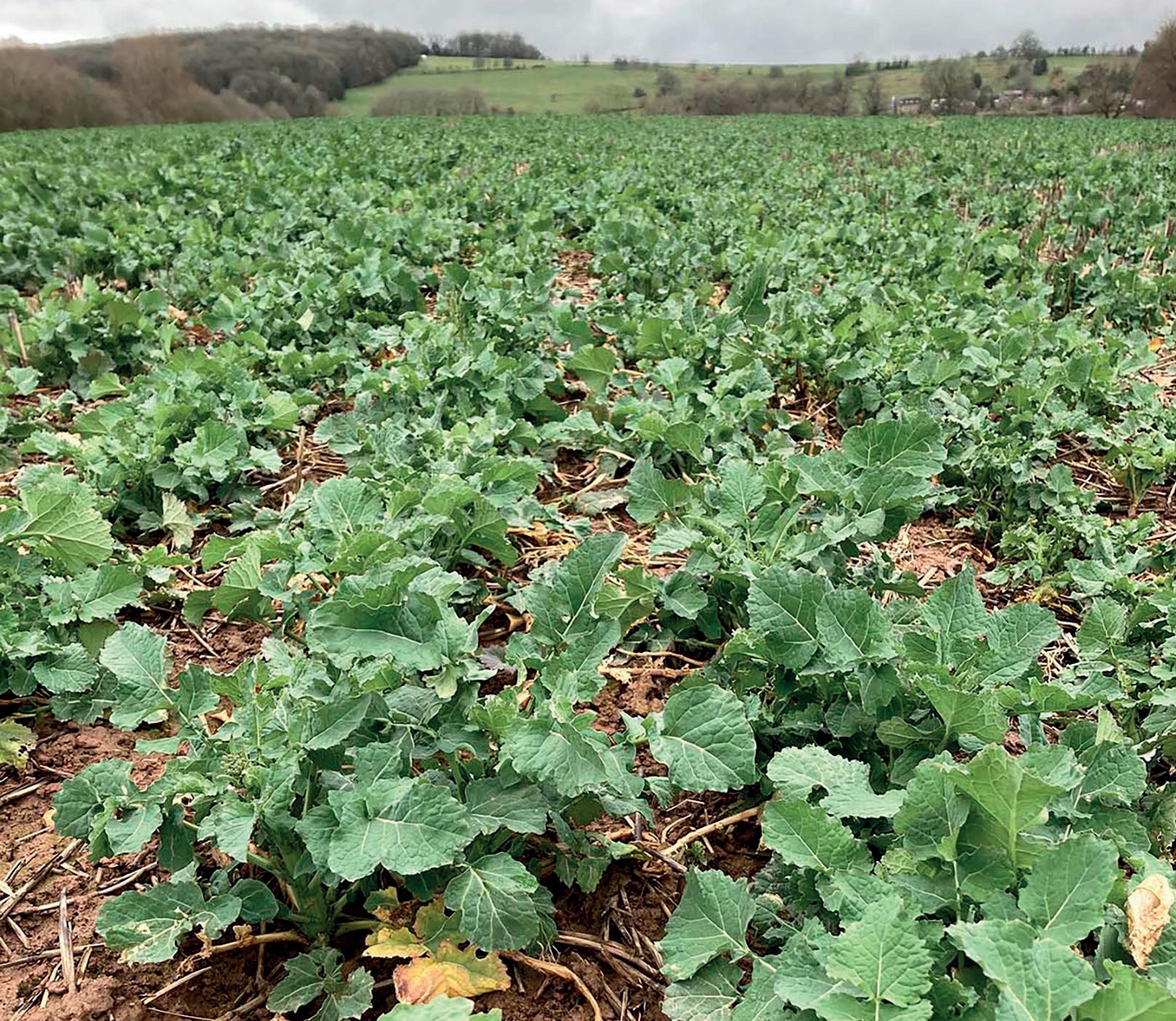
During our AHDB benchmarking discussion last month, we had a play with the online risk matrix tool available on the AHDB website. We agreed an N spend, plant protection product spend and a rough fixed cost spend based on group average (with a rent equivalent). At current prices, anything less than 3.5 tonnes per hectare resulted in a net loss. Not pretty. OSR is starting to feel like it’s been taking gaslighting lessons from the Government. Its place in the
Farm facts
rFamily farm covering 200 hectares of mainly silty/clay loams, growing combinable and forage crops
rRob is BASIS and FACTS qualified, having also received a postgraduate diploma in sustainable agriculture from Harper Adams
rCurrently in the third year of strip till establishment

rFarming operation is focused on reducing inputs and maintaining profitability
rRob is using cover crops and organic manures to build fertility
rUsing integrated pest management practices to reduce pesticide usage
10 APRIL 2023
Using the ‘R’ word in farming has now become more triggering than a football pundit’s tweet
ROB BEAUMONT
Most of the OSR has avoided damage from flea beetle and stem weevil.
rotation only secured by the “yeah, but what else are you going to grow?” argument.
We’ve also had our chemical pricing updates for this coming season in the last couple of weeks. No surprises, everything is going up. Fungicides must be one of the few products that become more expensive as they become less effective. Work that one out. We’re already hearing warnings of shortages of products and actives. The cynic in me thinks there is nothing like talking up a shortage to create a shortage.
On the upside, the more ridiculous the price of chemical inputs becomes, the more farmers will try to work out ways to produce without them. We have certainly had some interesting results over the last couple of seasons by reducing some of these inputs and spending on getting the nutrition right instead. Growing stuff, not killing stuff is more satisfying and has brought us results.

There are no silver bullets though, and building a resilient system takes time and careful management, and sometimes you still need to reach for the chemical
Grow the Future
can. However, direction is more important than velocity and 70 years of artificial input farming isn’t going to change overnight.

Holistic
I had the pleasure of visiting a local farmer recently who was really pushing forward in reducing inputs, using holistic grazing practices and making compost to grow decent crops and livestock. And perhaps most importantly, improving business profits and resilience too.
Using the ‘R’ word in farming has now become more triggering than a football pundit’s tweet, but if anyone was doing it right, it was this farmer. There are a lot of people out there who claim that regenerative agriculture is not scientific, but I completely disagree. Our understanding of how plants and soils interact is developing all the time. A lot of the information is out there in scientific literature, you just have to look for it.


As someone far more intelligent than me said: “When what the book says and what you see in the field differ, ignore the book.”
Strength
• Confidence across the bout width
• Shatter resistant
Uniformity
• Zero segregation
• Even spread for even growth
Accuracy
• Unrivalled accuracy up to 54m

• Increased wind resistance
Environment
• Half the ammonia emissions of urea + inhibitor*
*DEFRA, NT2605
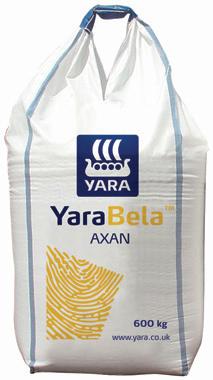
11 TALKING ARABLE APRIL 2023
YaraBela™ AXAN™
www.yara.co.uk Yara UK agronomy.uk@yara.com
@Yara_UK
OLLIEMartin
Ollie Martin is responsible for the arable and grain business enterprise across Bedfordia Farms’ 2,450-hectare operation, with 27,000 tonnes of grain storage, near Bedford. He studied agribusiness management at Writtle University College and has held previous farm management roles in Norfolk, Hertfordshire and Fife.
Well I hope everyone’s turnip crops are looking bountiful in order to keep the nation fed.
Our Secretary of State’s disdainful attitude towards, not just the UK farming industry’s challenges but also the very real and present issue of the nation’s food security, should have come as a surprise. But alas, I was not at all surprised and I dare say neither were you.
It is a sad indictment of what we have come to expect from career politicians who appear to fail upwards, landing in a position of responsibility for a sector of which they have no knowledge, understanding or even interest, it seems.
On a much more positive note, I was privileged to attend the inaugural meeting of the Writtle Farmers Club at Writtle University College. The aim is to gather figures from the food and farming industry to have the discussion about where our industry is heading and what we need to do to balance profitable farming with a restorative ecosystem, while not losing sight of the importance of food security and nutritious food. Not too much to discuss then.
Farm facts
rBedfordia Farms has more than 2,400 hectares of combinable crops including wheat, barley and beans

rThe business also provides grain testing in its on-site lab and has 27,000 tonnes of grain storage and processing capacity
rThere are 27 soil types across the farms, but most of the land consists of Hanslope clay, Faulkbourne and Stretham, which are classified as chalky clay, becoming waterlogged in winter
rThe farm utilises a number of precision technologies and has two pig units totalling 1,100 breeding sows
Some thought-provoking conversations were had and I very much look forward to the next meeting.
All too often conversations on farming policy are nullified due to their one-dimensional nature. Farmers want to run a profitable business; ecologists and environmentalists want to restore our ecosystems; and environment; and the Government of the day wants to win votes at the next election. But the food security
OSR has gone from being full of potential in December (below) to almost nothing in March (right) following frosts and CSFB larvae infestation.

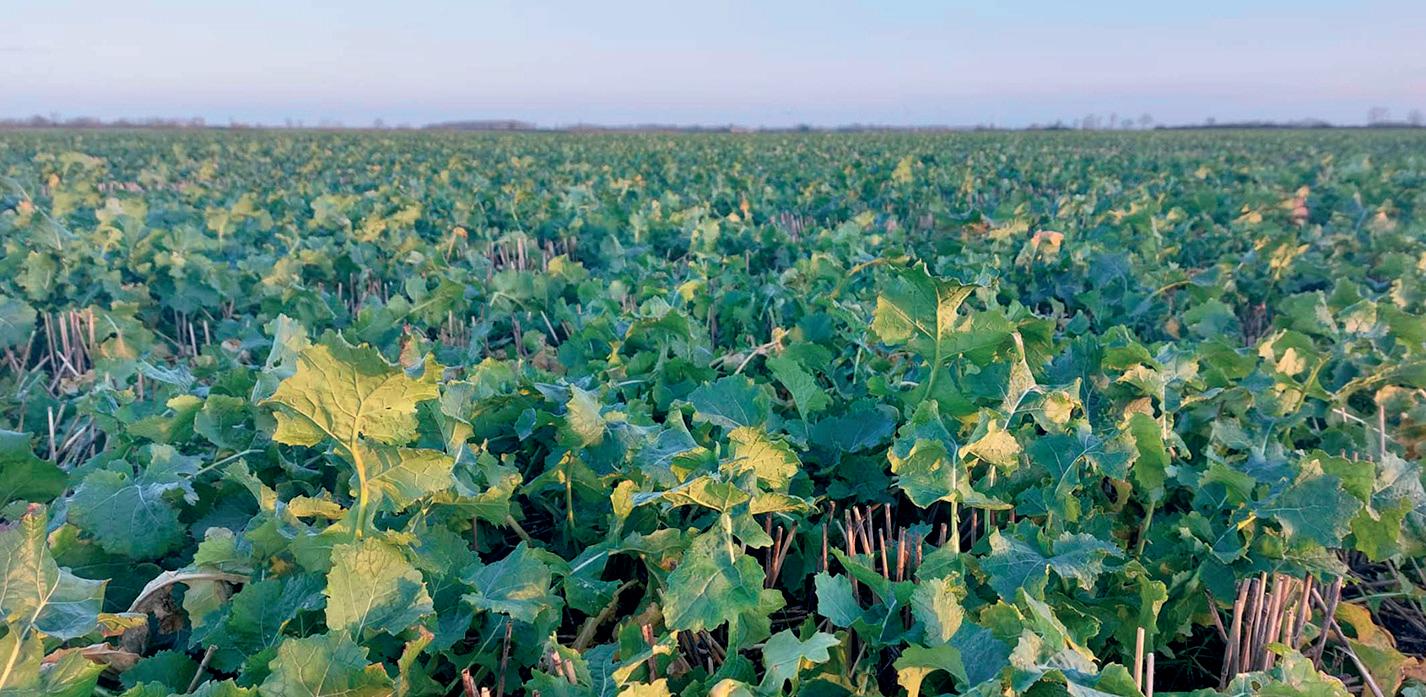
conversation appears to be the elephant in the room.
It is well established that the UK’s self-sufficiency is declining. Figures vary depending on which study you read, but it would be reasonably accurate to estimate that UK self-sufficiency has reduced from circa 80% (by value) in the late 1980s to less than 60% by 2020.
Now I am not expecting a re-emergence of the North Atlantic U-boat threat, but it would be equally fair to say that the world is certainly no more stable geopolitically now than it was in the past, and that’s not to mention the increasingly unpredictable climate affecting many food producing areas of the world.
Imports
So, relying ever more heavily on imports does seem a somewhat foolhardy trajectory that the powers that be seem to have accepted, or even driven.
Dare I suggest that successive governments have simply taken the easy option since, when the next election is only ever five years away, there is little need to get one’s head around the complexities of the situation. Perhaps we will cross the food security bridge when the shelves are empty.
Of course, from a farmer’s perspective the most frustrating, even infuriating aspect, is that as our output is hampered by the ever-increasing list of things we must not do and must not use in an effort to try and balance the farming/ecosystem equation, our country’s reliance on imports from parts of the world where there is very little in the way of assurance or compliance only increases, putting our own UK industry at a competitive
12 APRIL 2023
The combination of tissue damage from larval munching and a week of hard frosts in January resulted in leaves just dropping off
OLLIE MARTIN
disadvantage. Of course, subsidies are a mechanism that could be used to level the playing field, however, they are also on the ‘banned’ list.
On more domestic matters, we will not be the only ones to have watched much of our oilseed rape crop go from knee-high fields of potential to rows of stubby larvae-infested failure in a matter of weeks. The combination of tissue damage from larval munching and a week of hard frosts in January resulted in leaves just dropping off.
It raises the question once again of the crop’s place in the rotation. Despite a good year last year, this year even the most optimistic calculator will struggle to see much viability.

So, if not OSR then what? I know we are not alone in looking seriously at continuous wheat, since the crop is the only reliable contributor to the bottom line.

Longer-term, of course, I have concerns over the agronomic viability of this approach, and it’s not exactly a winner for biodiversity or the ecosystem is it?

Presumably the shortfall in oilseed rape production would be made up by imports from far flung places of the world.
The











Future proofing your Cereal Disease Control





Effective against septoria in wheat and rhynchosporium and ramularia in barley






























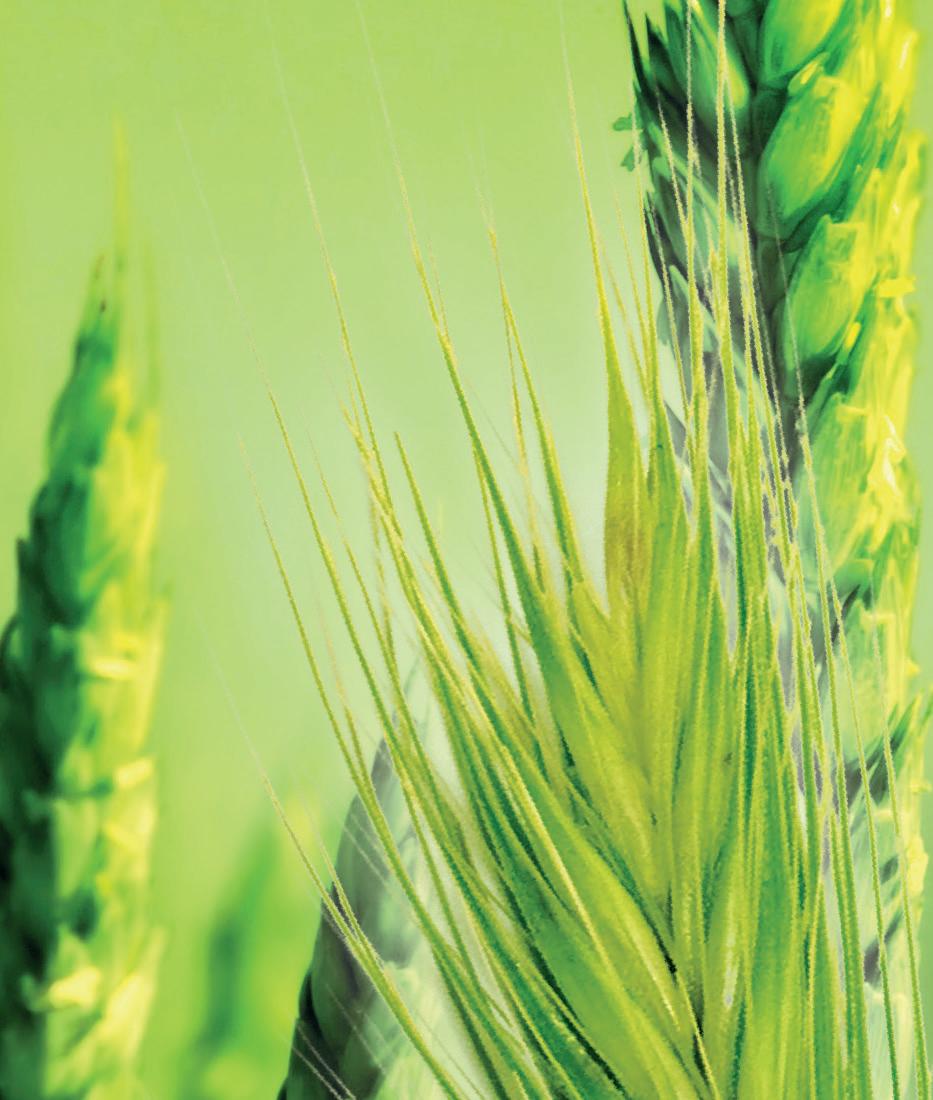








13 TALKING ARABLE APRIL 2023
ARIZONA
essential
ARIZONA POWERED BY MSI Protech Visit www.adama.com/uk for more information ADAMA Agricultural Solutions UK Ltd. Third Floor East, 1410 Arlington Business Park, Theale, Reading RG7 4SA Telephone 01635 860 555 UKenquiries@adama.com ARIZONA® is a registered trademarks of the ADAMA group. ARIZONA® contains 500g/L (39.5% w/w) folpet. Always read the label and product information before use. For further product information, including warning phrases and symbols, refer to www.adama.com/uk or call The Technical Helpline on 01635 876 622. CONTROLLING CEREAL DISEASES FOR LONGER PROTECTING SINGLE-SITE CHEMISTRY MAINTAINING YIELD AND PROFITABILITY 1 2 3 PARTNER (500g/L folpet) ARIZONA THINK multi-site first... or 0542_ADAMA_Arable Farming_Arizona Disease Control Ad_121x170.indd 1 17/02/2023 11:21
multi-site fungicide
Despite a good year last year, OSR may struggle to stack up this season.
TALKING AGRONOMY
PHIL Warham
After the unseasonably dry February when we were inspecting crops in walking boots, the weather had to even up.
February might have been a fool’s spring, but I am glad for all my growers that we took the opportunities while they were there.
Spring crops have been drilled into the best conditions imaginable, the only concern is the lack of black-grass in the crop.
All winter growth was dealt with, but I believe the spring flush was not. However, spring barley is emerging and pre-emergence herbicides appear to be doing their job.
Winter crops generally look well set up. Hopefully, by the time this article goes to print, crop management will be back on track after March’s inclement weather put an end to the early start many growers had made.

On some oilseed rape crops where growth
Agronomist facts
JPhil Warham has been an agronomist with Agrovista for six years. He gained a degree in land and farm management at Harper Adams University and managed farms for several years afterwards. He now advises on combinable crops, cereals, maize and vining peas in Lincolnshire, Nottinghamshire and into Leicestershire. Key interests include direct drilling and soil health, as well as making farms profitable. In his spare time he is a keen runner and horseman.
was checked, pigeon damage increased through to mid-March. Fortunately, in my area at least, cabbage stem flea beetle larvae had not increased dramatically; larvae could be found in some side shoots but not in the stem, although some plants have succumbed to frost damage.
OSR’s powers of recovery never cease to amaze, so we must ensure all crops can push on through flowering to create the optimum canopy structure.
Margins
Oilseed rape prices may have fallen back to around £420/tonne at the time of writing, but there is plenty of headroom to make good margins, notwithstanding the high price that many growers paid for this season’s fertiliser.
Oilseed rape is due its mid-flower spray, which will be based on fluopyram + prothioconazole to control sclerotinia, maintaining water volumes at 200 litres/hectare or more in dense crops or where disease risk is high.
I will also add Klorofill to help maximise green leaf area and plant biomass. It contains pentanoate that reverses the chlorophyll suppression that can occur during rapid growth, helping ensure the plant’s solar panels work as effectively as possible.
Forward winter wheat crops were really motoring early in March, with some late September-drilled fields after potatoes already at GS30, and some Skyscraper, sown mid-October, on heavy land at a similar stage.
These were pencilled in for a robust PGR to keep them standing.
Mainstream T0 plans on wheat included PGRs,
trace elements and a fungicide if necessary.
Most have now been applied - disease levels were low prior to this, with a very small amount of yellow rust in places cleared up by a half-rate tebuconazole to keep crops on track.
Wheat T1 applications are now imminent in some cases. My recommendations will be judged on variety and disease presence/risk.
Where yellow rust is present, I’ll use benzovindiflupyr together with prothioconazole + tebuconazole and folpet.
If septoria pressure is high, I’ll switch to mefentrifluconazole and boscalid. Or, if the grower is happy using fenpicoxamid, we will use that together with fluxapyroxad + pyraclostrobin.
More resistant varieties such as Extase will get prothioconazole, SDHI and folpet. All the above applications will also include PGRs and nutrition.
Winter barley T1 fungicide recommendations have been made, with some net blotch and brown rust showing. This is the most important timing in winter barley, accounting for about 60% of the plant’s yield response to fungicides, so I’ll use fluoxastrobin + prothioconazole + trifloxystrobin along with folpet to boost protection against rhynchosporium and as an anti-resistance strategy.
All winter cereals will receive Wholly K PGA. This fully tank-mixable product delivers potassium through the leaf, ensuring enough of this essential nutrient is available to drive growth and nitrogen uptake. It also contains L-PGA (pidolic acid) to enhance nitrogen assimilation, helping to ensure crops head towards T2 and beyond in optimum condition.
14 APRIL 2023
Spring crops have been drilled into the best conditions imaginablethe only concern is the lack of black-grass
The dogs will clock as many miles as me, we’ll all be ready for a rest after harvest, and Revystar XE will protect my barley.







































The dogs will clock as many miles as me, we’ll all be ready for a rest after harvest, and Revystar ® XE will protect my barley.



































Use plant protection products safely. Always read the label and product information before use. For further product information including warning phrases and symbols refer to www.agricentre.basf.co.uk. Revystar ® XE contains mefentri uconazole (Revysol®) and uxapyroxad (Xemium ® ). Revystar ® XE, Revysol® , and Xemium® are registered Trademarks of BASF. ©BASF 2023. All rights reserved.
Use plant protection products safely. Always read the label and product information before use. For further product information including warning phrases and symbols refer to www.agricentre.basf.co.uk. Revystar ® XE contains mefentri uconazole (Revysol®) and uxapyroxad (Xemium ® ). Revystar ® XE, Revysol® , and Xemium® are registered Trademarks of BASF. ©BASF 2023. All rights reserved.
GREG Taylor
Damage to OSR hasn’t been enough to make us consider writing any crops off
The arrival of unsettled weather after our brief spell of early March snow has been most welcome after the driest January and February most of us have ever known.
Providing we are not in for a prolonged period of rain, this will be just what we need to direct drill our spring crops into some decently warming and sufficiently moist soils for the best possible start. It will also be perfect in making our first splits of nitrogen available to winter crops when they really need it to kick away strongly.
The weather has been more variable than ever this season but it has been a real boon for managing our heavy ground so far.
Agronomist facts
JGreg Taylor has been an Agrii agronomist for more than a decade, servicing around 6,000 hectares of mainly combinable cropping across a broad range of soil types in Oxfordshire, Warwickshire and Buckinghamshire.
As a Harper Adams graduate, he has worked on farms in New Zealand and the USA, and is now responsible for the trials and demonstration work on the Brackley i-Farm.

He is particularly engaged with direct drilling, soil improvement and regenerative agriculture and is an ardent rugby fan and marathon runner in his spare time.
All too often we go into April with either too much wetness, too much wind or both, giving a backlog of fieldwork just when we need the time to drill. And everything tends to be touch and go to get the seedbeds we want.
But this year, we have been able to get all our early nitrogen on and weed tidy-ups done, as well as making a good early start to barley drilling. What’s more, the glyphosate has worked a treat on covers opened up by earlier cold snaps, giving our soils the breather they need to be in the best condition for direct drilling.
Well rooted
Our winter cereals have come through the winter in fine fettle too, with little, if any, disease concerns. And though most of our oilseed rape is smaller than previous years, it is well rooted with good plant populations. Even where we saw stem damage in the hard December frosts, making it easier for cabbage stem flea beetle larvae to get straight into the main stems, this hasn’t been enough to make us consider writing off any crops.
Encouragingly, too, in terms of fertiliser economy, testing has shown good levels of soil mineral nitrogen coming out of the winter, presumably due to a carry-over of unused N from the dry summer, and our ‘regenerative’ efforts to build better-structured, healthier soils.
As I sign off from my two-year Talking Agronomy stint, I must emphasise that these efforts continue to be long-term and very much a work in progress.
I quite often hear people say cover crops or
direct drilling ‘don’t work’. Or that growing beans or linseed ‘doesn’t stack up’. Rather than looking for simple quick fixes, what we really need these days are far longer-term, more integrated approaches.
Cover crops often won’t give an obvious boost in following crop performance. Nor, in most cases, will switching to direct drilling. Equally, spring or other break crops may not deliver higher margins than a second cereal. But that’s not the point. The key thing is the individual elements of a regenerative approach only really work to improve soils and ultimately farm sustainably when they are employed together, as part of a determined effort over time, involving sufficient attention to drainage and soil pH.
In our experience, you need to have the flexibility to move into the system gradually, adapting your approach to your soils and conditions without being too rigid, even if this means low disturbance metal at depth, cover crop establishment on a light cultivator, or removing straw ahead of a second cereal on occasion.
Just like my fourth London Marathon on St George’s Day, it is a matter of doing the hard yards before you tackle the whole 26 miles. And you can only nail the time you want by combining the right training and nutrition with solid determination.
Speaking of which, do lend me your support in person if you’re in London, in spirit if you aren’t, or even with a donation to the thoroughly worthwhile RFU Injured Players Foundation I’m running for. All my best for a successful harvest and many more thereafter.
TALKING AGRONOMY 16 APRIL 2023

































CLAAS CMATIC – Geared for Growth. claas.co.uk Watch the video Andrew Harris, ARION 660 CMATIC, May 2022 Contact your local CLAAS dealer today for a demonstration of a CMATIC tractor. Seamless acceleration and deceleration between 0-50kph. Uninterrupted power for maximum productivity and minimising fuel usage. 3 simple drive modes. Auto stretch brake. Tractor implement control. Engine droop adjustment. The real beauty
is that with CMATIC
it’s
such a relaxed drive and so simple to operate.
TALKING AGRONOMY
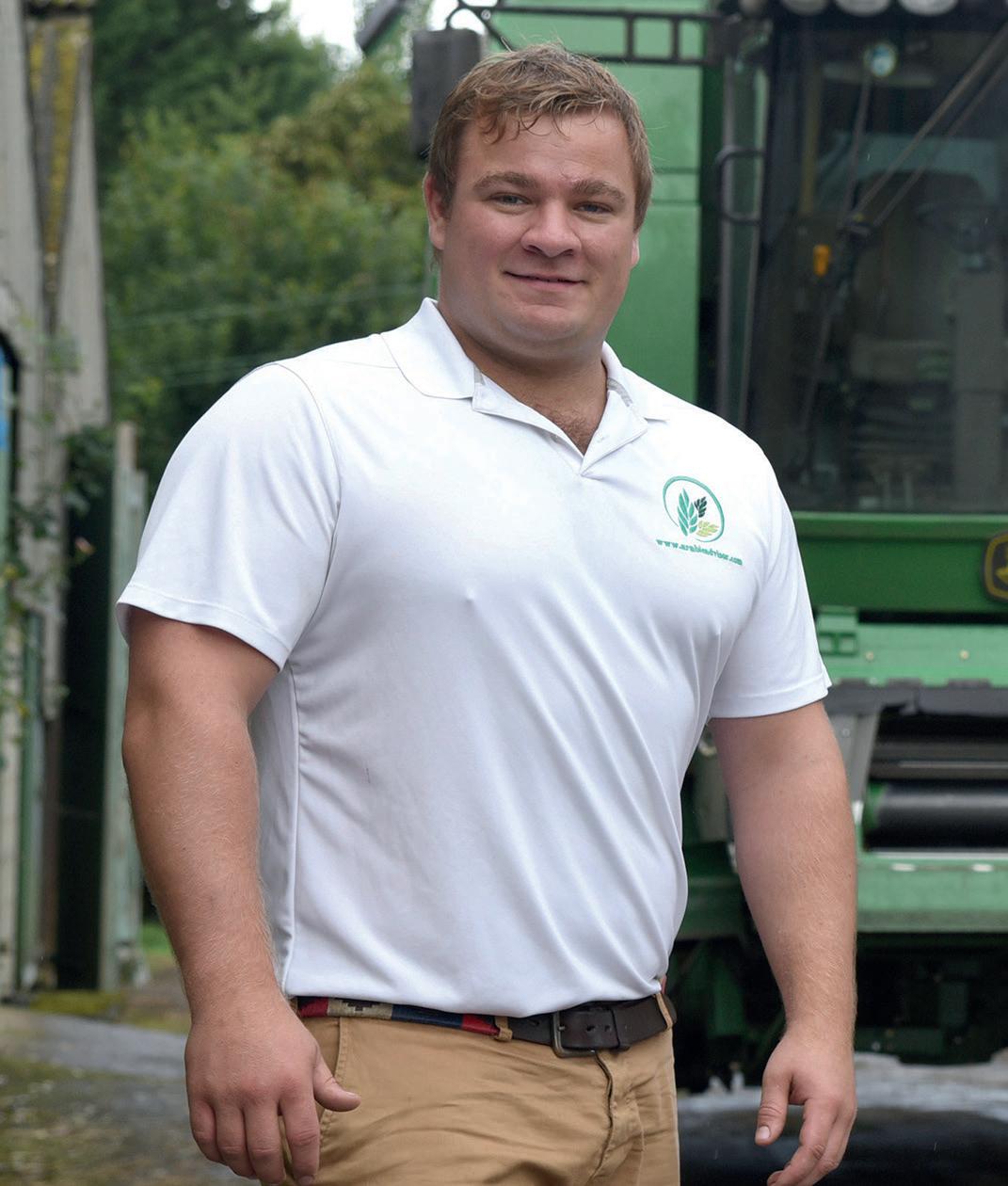
BEN Boothman
The season has got off to a gentle stroll rather than an Olympian sprint. In my last article, I mentioned the door of winter was still left slightly ajar – well, it soon blew open and delivered us with several inches of snow and frosty weather in the second week of March.
In North Yorkshire, we were lucky to have only a gentle reminder of winter, whereas further in the south of the county a foot of snow was not uncommon. Since then, the weather has been rather unsteady, with mild days accompanied by flurries of rain, with some of these being heavy. Fields will need several days before the army of tractors can re-enter and start working their way through the ever-growing list of jobs that are starting to accumulate.
Winter wheats are enjoying their first doses of nitrogen and have started to pick
Agronomist facts
themselves up off the ground. Disease levels are bubbling away in the base of crops with the dirtier varieties showing us nothing new. Yellow rust can be found in the usual culprits, however last week’s (w/e March 17) cold snap has helped keep it in check, for now. These varieties will need a well-timed T0 containing a triazole or azoxystrobin, or a mix of both, dependent on disease severity, take-all risk and whether the T0 fungicide will be accompanied by an SU graminicide.
Sprays
Spring grass-weed sprays are all at the top of the job list sheets, which will hopefully all get done in the next week or so (w/c March 20) when temperatures start moving in the right direction. I would like to point out that, in general, autumn residual herbicide programmes have worked well, and many crops are at present unnervingly clean.
Winter barley crops have started to return to their pre-winter lush green following early nitrogen dressings. Lush, forward crops have all been prescribed an early PGR, and in hybrid varieties where brown rust is present, a small rate of prothioconazole has been included to help keep on top of pre-T1 fungicides sprays, which are looking hopeful for application around the first week of April. This early spray also allows me to target any wild oat or ryegrass populations
which may be littering crops, helping ease the tank mix at T1. As I plan towards the first main fungicide, mildew levels are still bubbling away, while rhynchosporium can be visible on older leaves, so these two diseases will be the main target for the T1 mix.
Winter oilseed rape crops inch closer to the sun day by day, and as all early spring light leaf spot sprays should now be on, the focus switches to sclerotinia control. However, it will still be a couple of weeks before we see the first buds burst open –hopefully.
Early-sown spring barley crops are starting to poke out and enter into 2023. Conditions at present are not too favourable for these crops, but as long as the temperature keeps going in the right direction and the rain eases, I am confident they will persevere.
Winter linseed is slowly starting to move away from the damage left in the wake of fat bellied pigeons, so spring broad-leaved herbicide applications can now commence, partnered with a dash of zinc to help ease the blow.
Crops in general look extremely well and full of potential, even those later-sown crops following roots. As long as fertiliser prices continue a steady decline and commodity values stay in our favour, there is reason to be hopeful for the harvest ahead.
18 APRIL 2023
Autumn herbicides have worked well and many crops are at present unnervingly clean
JBen Boothman is an independent agronomist and member of the Arable Advisor Group and the Association of Independent Crop Consultants (AICC), covering Yorkshire and the North East. He is BASIS, FACTS and BETA qualified and studied for a degree in agriculture and crop management at Harper Adams University.







USE PLANT PROTECTION PRODUCTS SAFELY. Always read the label and product information before use. For further information including warning phrases and symbols refer to label. Corteva Agriscience UK Limited, CPC2 Capital Park, Fulbourn, Cambridge CB21 5XE. Tel: 01462 457272. ®, ™ Trademarks of Corteva Agriscience and its affiliated companies. © 2023 Corteva. Univoq™ contains fenpicoxamid (Inatreq™ active) and prothioconazole. Discover more at www.corteva.co.uk Technical Hotline: 0800 689 8899 E-mail: ukhotline@corteva.com Protect now. Profit later. Univoq offers persistent, curative and protective control against all Septoria strains. Its broad spectrum disease control ensures you can secure your yield and the future of your farm. Discover more about the benefits of Univoq and our latest application advice at www.corteva.co.uk/univoq STEWARDSHIP MATTERS Unique chemistry proven to deliver robust performance and higher yields.
DARRYLShailes
The weather has been very variable in the Waveney Valley over the last few weeks. One minute everything’s freezing cold, then it is 14degC. The crocuses look great one minute, the next they have dropped their heads as it is -5degC.
What’s not changed is that it is still pretty dry despite the recent rains. In the winter of 2020, we had seven fairly big floods in the garden with the highest levels recorded in the valley for over 50 years on Christmas Day.
The valley generally floods when heavy rain coincides with a spring tide, and despite the spring tides that have caused the issues at Hemsby on the Norfolk coast, the River Waveney is still only just full. We had a pond cleared in October and the level in that is only just a bit higher now than back then.
The first full moon that occurs on or after the spring equinox determines Easter Sunday, and will also mark the next potential for a flood but if we don’t get heavy rain, it won’t happen.
When we consider that potatoes and sugar beet need to process a large volume of water through the growing season, not having good groundwater reserves or river flows to fill
reservoirs mean we will be relying on spring and summer rains. Winter groundwater fill has been limited so abstraction licenses may come under pressure, - we must make sure we use water wisely.
We can mitigate water availability a little by ensuring there is no compromise on root growth in either potatoes or sugar beet. Ensuring there is no compaction at planting and drilling can have a huge effect, especially if water is limiting.
Even though we have had quite a lot of frost over the winter the emergency EAMU for Cruiser SB (thiamethoxam) fell within the Rothamsted model and we have got the seed treatment for the coming season.
The model utilises the temperature in January and February so the frosts that came in December are not included as they don’t affect aphid migration very much, as was explained at the recent BBRO updates.
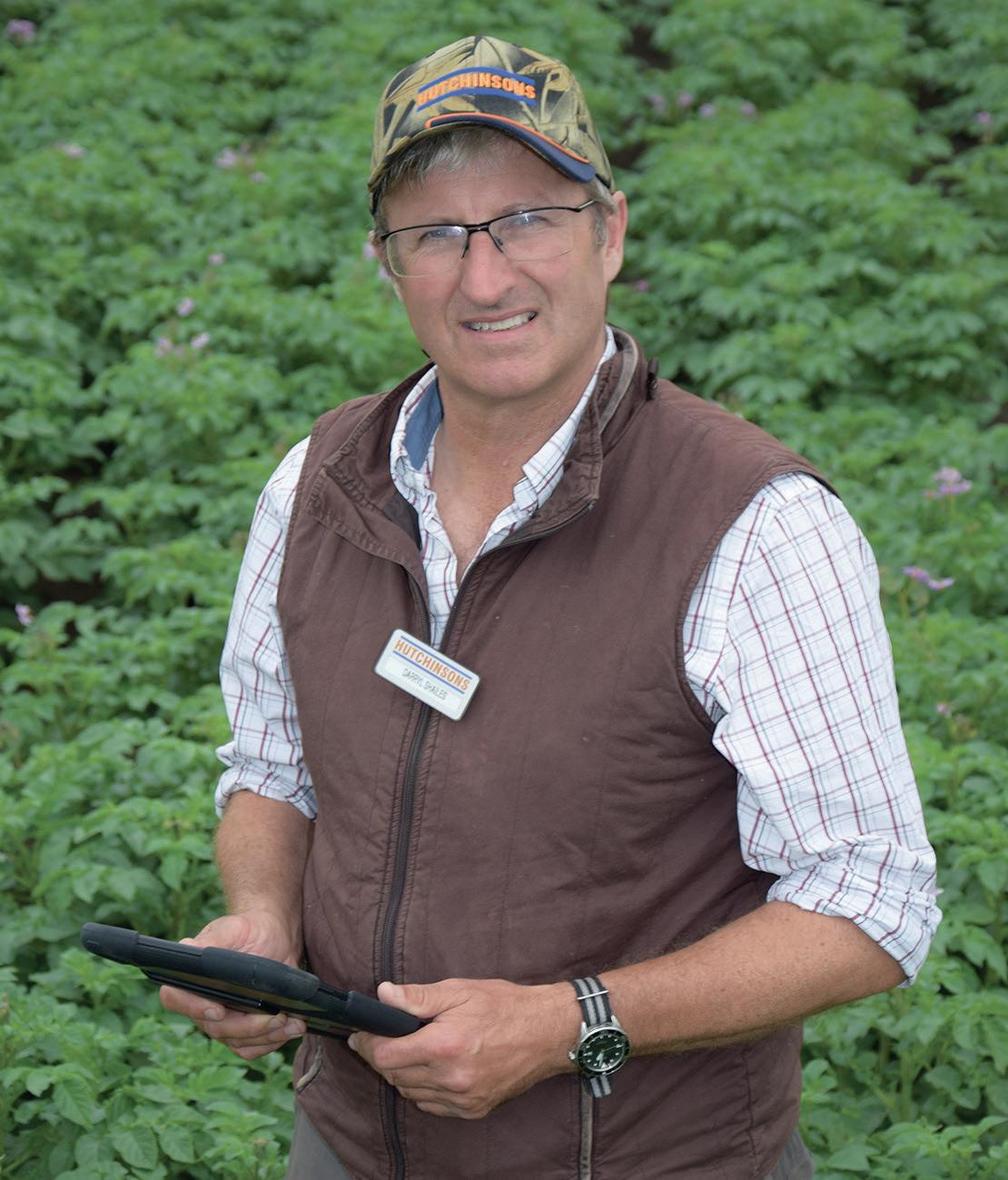
The first migration of myzus persicae (peach potato aphid), the aphid vector of virus yellows, is predicted for April 20. The more recent frosts in March may delay migration but we should be vigilant from mid-April onwards and read the updates from BBRO, especially where Cruiser SB is not used.
Aphid migration will also have an effect on virus transmission in potatoes, especially seed crops.
The viruses spread by aphids in beet are of a persistent type and even though the time for infection to take place is different between the three different viruses that make up virus
aphicides either as a seed dressing or foliar sprays. However, the virus with the major economic impact on potatoes, virus Y, is non-persistent.
A non-persistent virus is carried in the mouthparts of the aphid vector, mainly myzus persicae and cavariella aegopodii (carrot willow aphid) and is transmitted as aphids probe the potato leaves to feed.
This makes controlling virus Y transmission with aphicides very challenging ,as the aphicide needs to be ingested by the aphids before it takes effect, by which time the aphids have already transmitted the virus.
The consequence is that although myzus persicae is the main vector in both sugar beet and potatoes and we can control the aphid, there will be very little effect on PVY transmission.
Recent work has shown that mineral oils and barrier crops to clean the aphids’ mouth parts before they can infect the crop have shown good effect on control of PVY.
This integrated pest management (IPM) approach in virus transmission has had to be adopted due to the method of transmission of PVY, and shows how we can adopt control strategies without over-reliance on pesticides.
IPM is definitely the way forward in crop protection and with the Government now recognising this in the new Environmental Land Management scheme and Sustainable Farming Incentive strategies, we must take it on board across all cropping areas where we can.
20 APRIL 2023 TALKING AGRONOMY ROOTS
We must take IPM on board across all cropping where we can
JDarryl Shailes is root crop technical manager for Hutchinsons, with a nationwide remit. He has been working in potato agronomy for more than 20 years.
Agronomist facts
The importance of diversity in crop production systems is widely and increasingly discussed, but perhaps not often as convincingly as by Joel Williams. Alice Dyer reports.
The five principles of regenerative agriculture are all pieces of the complex puzzle that tie together a healthy soil ecosystem, but there is one principle in particular that should not be overlooked in its vital role in improving soil health.
Roots are the main driver of improving soil health, from promoting nutrient cycling, releasing chemistry, improving structure and porosity, and feeding biology.

Although international soil scientist Joel Williams would not claim any one of the five principles is more important than another, this piece – living roots and keeping soil covered – is exceptionally important, he says.

“Of course, we need aboveground biomass to feed below ground, but in terms of those benefits and direct action on soil, it really is the roots, below-ground carbon and root
Getting to the root of healthy soils

exudates that drive so many of these positive changes. So, wherever you can, produce more roots, be that in a cash crop or from a cover crop.”
However, many questions remain about how cover crops and bi-crops can be integrated into the wide variety of farming systems seen across the UK, from what each species can deliver, to how many species should even be in the mix.
Monocultures are ‘bad’ we are told, but if you have one goal, and one plant species is best for targeting that, then anything else is going to water down its effect, explains Mr Williams.
“A monoculture isn’t bad if you’re chasing one goal. Perhaps not repeated monocultures again and again, but sometimes if you have a very specific goal, there’s nothing wrong with growing one species either.”
However, most farmers will be chasing many goals, so it all
depends on what you are trying to achieve by growing the crop.
“You might have a 16-species mix, with some species doing better in some years than others, and vice versa. There’s no magic number,” says Mr Williams.
Cost
However, the downside to a higher number of species is the added cost. “That increase in diversity is adding functionality, which can be very good, but even under a monoculture, a plant releases an incredible cocktail of root exudates,” says Mr Williams.
“I’m very partial to a classic oat
and pea combination – it can act as a companion or intercrop, a wholecrop or just a cover crop. It’s a combination that just works. Among the cost debate, I think there’s nothing wrong with these two classics that do a great job together – you can use home-saved seed, it doesn’t have to be an expensive mix.
“If you want to go beyond two species and have more diversity, that’s fine – you can buy some phacelia or radish and spice things up. Covers don’t have to be expensive and there are plenty of ways to do it more economically.”
The species being grown will
21 FARMING SYSTEMS TECHNICAL APRIL 2023 24 How to grow a world record-breaking crop 30 Soil carbon monitoring helping boost productivity on-farm 32 Are fungicides still working? 34 Crop platform delivering supply chain efficiencies 36 How the 2022 OSR YEN winners achieved their success 40 Finding sustainability in complexity 44 The drive for gene editing in UK sugar beet 46 Long-term monitoring highlights safety of UK grain Also in this section
Wherever you can, produce more roots, be that in a cash crop or from a cover crop
JOEL WILLIAMS
Roots are the main driver of improving soil health.
TECHNICAL FARMING SYSTEMS
also very much depend on the goal of the farmer. While one plant species has a very diverse array of exudates, it only has a certain cocktail it can release.
“That’s different if it’s a cereal, a legume or a brassica,” says Mr Williams. “So, when we bring those together, we have the legume exudates activating all those exudates the cereal cannot communicate or work with. Both species will benefit from that. It opens up this opportunity for synergy – one plus one can equal three, but this synergy is something we still have a lot to learn about.”
Functional diversity
Considering the end goal will also help when selecting which species to grow in a mix.
“It’s not the diversity bringing the effect, it’s the specific function of the plant we use. For example, black oats are specifically for soil structure. It’s functional diversity that’s the important thing. If I have a three-way mix of cereal, legume and a brassica versus an eight-way mix of eight different legumes, I would choose the three-way mix. It has functional diversity and different species with different specific functions.”
A UK study comparing a cover crop of clover, black oats, tillage radish and phacelia found black oats developed greater soil pore connectivity than other plant species, whereas phacelia decreased porosity.
“This is because it does not have that nice, big, fibrous root system, so it didn’t improve soil structure much at all,” explains Mr Williams.
However, microbial communities, particularly the fungi underneath the phacelia, were most notably improved.
“Black oats were best for structure, but phacelia was better for stimulating soil fungi. Each species has different specialities and benefits but if we bring those two together we get both.”
Also in the study, the abundance of fungal pathotrophs – beneficial fungi that derive their nourishment from a pathogen – was positively associated with oilseed radish, alfalfa and phacelia, but negatively with sudan grass.
“However, other fungi like mycorrhiza, were particularly stimulated by sudan grass, so again, depending on the goal, different plants can bring different benefits.”
Studies with maize and faba beans found there was almost a 60% increase in soil aggregation by growing the two crops alongside each other.
Mr Williams says: “The two crops have very different exudates – faba bean has very acidic exudates, driving the pH of the rhizophere down, whereas the maize has more neutral exudates.
“When we bring those together there’s an opportunity for synergy because driving the soil pH down increases phosphorus release and uptake. The plant can directly access phosphorus and so can the organisms – they feed bacteria and fungi to access those phosphorus compounds. So we have direct chemical interactions as well as indirect biological interactions by encouraging the organisms.
“It’s very clear that when we have multiple different root systems intermingling, we get better stimulation of the biological processes that fulfil functions such as phosphorus solubilisation.”
In a separate study of lupins and maize, it was found that even just by having a partner to
the maize, its root exudates changed in the presence of the lupin partner.
“This plant-to-plant interaction shows how things can behave very differently simply by having a plant partner.”
Integration
The integration of legumes makes particular sense for reducing nitrogen requirements, but how much nitrogen is a legume capable of sharing?
“Not huge amounts and I would say that’s still to be answered,” says Mr Williams.
“It’s not going to be a major supply, especially in high yielding areas like the UK, but in the Canadian prairies where they are growing cereal legume intercrops, they will typically use zero nitrogen with these and production is still economically viable.”

Legumes can share nitrogen even without dying or decaying, and there are pathways where the crop can share nitrogen in real time. One of those mechanisms is through exudates.
Mr Williams explains: “The legume is leaking out amino acids, and when we have a non-legume alongside it, the neighbouring cereal can steal
those amino acids and absorb them, provided root-to-root contact is close.
“We also have mycorrhizal support. If the two species are mycorrhizal, then the fungi can colonise both species and share amino acids from the legume through the mycorrhizal network – it doesn’t even have to go out into the soil – it can travel through that fungal pathway and be delivered to the non-legume.”
While N sharing might be novel now, there is potential to improve this in the future through plant breeding.
“At the moment, it’s not something we have specifically bred for. If we bred legumes for this purpose and they were better at sharing nitrogen, they could make up a bigger nitrogen supply. For example, we know little leaf clovers share more nitrogen than larger leaf clovers for the simple reason that large leaf varieties need to hold back more nitrogen to grow that bigger leaf.”
There is also opportunity to improve cover crop breeding, adds Mr Williams.
“The reason our modern varieties are high yielding is that they allocate more carbon above ground to yield. That comes at a
22
APRIL 2023
I’m very partial to a classic oat and pea combination
JOEL WILLIAMS
A pea and oat combination can fit into many systems, either as a companion, intercrop, wholecrop or cover crop.
cost to roots. Older varieties are not so high yielding because they take more carbon below ground into the roots.
“ If we want to drive more root production, we should be breeding varieties that produce better roots. That’s going to be a trade-off when you’re trying to grow yield, but if you’re trying to grow cover crops which won’t be taken to yield, there is an obvious opportunity to breed cover crops with the goal of below-ground carbon allocation to grow more roots.
“We’re seeing all these benefits to cover crops already and we haven’t even bred them for the goal we want them to achieve – we’re using blunt tools. The next generation of cover crop seed will have far greater potential.”

As well as improvements to crop nutrition, diversity of species can have a significant impact on crop pressure against pests and diseases.
BASE-UK Conference
In a comparison of 101 different studies, it was found that, 79% of the time, there was a disease reduction by having two plants grown together, and only 3% of the time was there an increase in disease pressure. For pests, comparing more than 150 studies, 68% of the time, pest pressure declined, and only increased 8% of the time.
“The odds are on your side for lowering that pressure,” says Mr Williams.
For weeds, there was a decrease or neutral effect 86% of the time.
“I’m not saying it’s a silver bullet and we’re going to completely control pests, weeds and disease, but you’re making it much harder for them just by designing your production system to have two species rather than one,” says Mr Williams.
“If you start with the right production system design, i.e. not a highly vulnerable monoculture, as soon as you dilute that field with a 50% non-host, the pathogen is hitting a non-host half the time so you’re immediately lowering the disease burden.”
However, the legacy effect of bi-cropping on soil biology is less clear.
“During legacy sampling, the structural pattern in the bacterial and fungal communities associated with previous swards were returned, but the effect faded with time.
“So yes, when you grow a nice diverse mixture and stimulate biology, there is a legacy effect in the following cash crop. It fades over time, it doesn’t persist forever, but it will benefit that next crop.”
Business Development Manager
Agriconnect is a business unit within the Arc network, a global events, data, and media platform. Arc is a fast-growing global events, data, and media platform with a varied portfolio content led portals, magazines, and events. Agriconnect’s mission is to empower, inspire, and connect people and business in agriculture by creating trusted content and connections that help the industry thrive.
Since 1844, the brands of Agriconnect have been the trusted source of information for farmers and with brands like Farmers Guardian, events, like LAMMA and Farm Business Innovation, and digital platforms, like FG Insights, Agriconnect continues to bring together the British farming community.

THE ROLE:
• We are now looking for a motivated and driven salesperson to join our Sales team.
• The main function of the role is to develop business through growth in revenue, yield, and to increase customer numbers. You will be required to identify new opportunities and influence companies’ media buying habits within the agricultural sector. Due to the ever-changing nature of the industry, this person will have the ability to spot new avenues and exploit market trends.
• Hours: 35 hours per week – Mon – Fri
• Location: Preston – temporary hybrid remote
• Salary: Competitive, dependant on experience.
SKILLS & EXPERIENCE:
• Own, support and fully develop specific market sectors
• Conduct sales presentations by telephone, email or face to face to existing and prospective clients in order to develop existing business and generate new business wherever possible.
• Advise existing and new customers on the most effective solution to meet client needs within the Agriconnect portfolio.
• Continually seek and develop new sales & opportunities.
• Ability to accurately forecast future sales
• Keep abreast of all current trends, activities and relevant news within agriculture and specific sector

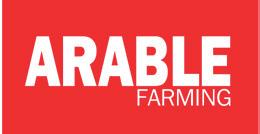
• An interest in agriculture
• Highly motivated & driven, with an ability to meet ambitious performance goals
• Be enthusiastic and motivated to continually explore new opportunities, whilst possessing a natural inquisitive nature
• Excellent communication written and interpersonal skills
We offer an excellent package including:
• A competitive basic salary
• 25 days holiday increasing to 27 after two years
• An extra day off on your birthday
• Free life assurance
• Contributory pension scheme
• Employee assistance programme
Arc has ambitious plans for growth, and this is an opportunity to be part of our continuing success story whilst enjoying a fabulous work/ life balance.
JJoel Williams was speaking at
10-year anniversary conference and annual AGM, held in Nottingham on February 7-8, and marking a decade of ‘growing confidence’ within its community of regenerative farmers.
We strive to create a culture that is open and respectful, where differences are valued and celebrated. We want everyone to be able to reach their full potential, so we are committed to cultivating a company that promotes inclusion and belonging.
To apply for this role, please email amber.tabiner@agriconnect.com
23 TECHNICAL APRIL 2023
the BASE-UK
Breaking a world record requires meticulous planning, endless scrutiny, and the support of a team of experts. Grower Tim Lamyman and his A-team have achieved all that for a ninth time. Alice Dyer found out how.
How to grow a world record-breaking crop
Last year, the UK trumped New Zealand yet again in the annual battle for the highestyielding cereal crops after Lincolnshire farmer Tim Lamyman smashed the charts with a 17.96 tonnes-per-hectare wheat crop – nearly twice the UK average wheat yield.
This eclipsed the previous world record set by New Zealand’s Canterbury-region farmer, Eric Watson, in 2020 with a 17.39t/ha crop.
During the same harvest, Mr Lamyman also smashed his own 2021 barley yield world record of 14.2t/ha, with a 16.2t/ ha crop of KWS Tardis on the farm in the village of Worlaby, north Lincolnshire.
As well as his extreme attention to detail, or what the Yield Enhancement Network might describe as the ‘farm factor’, Mr Lamyman puts his success down to a collaboration of experts including Frontier, BASF, GFP Seeds and BioNature.
It was Tim’s son, Rob, who set the ball rolling with the wheat world record, after presenting him with the DSV variety Champion. The Lamymans grew Champion on the farm’s grade 2 chalky wold soils in 2021.
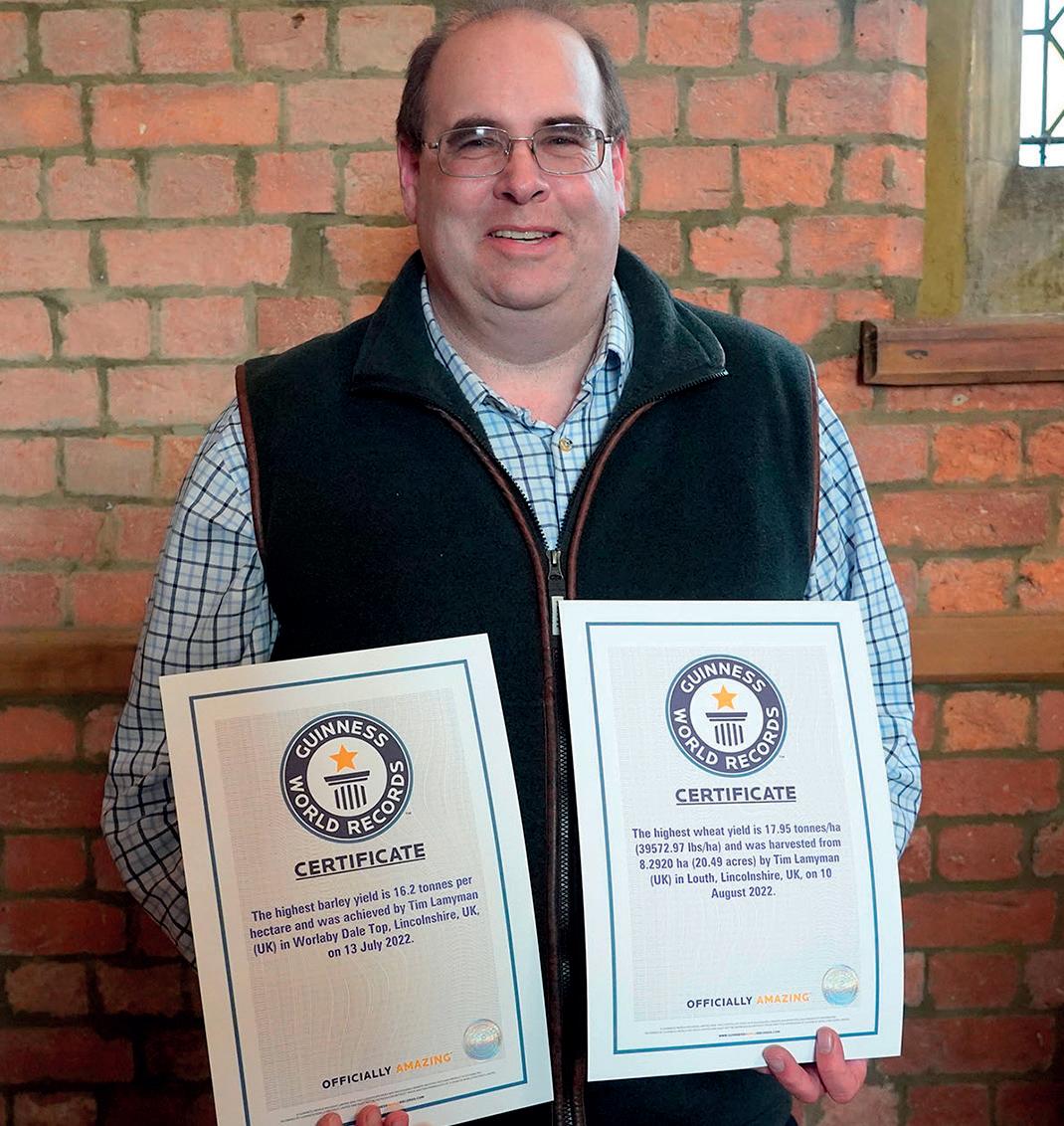
Mr Lamyman says: “From this variety landing on my desk, I had the idea to give the world record another go, which was a long way above the 16.5t/ha I achieved in 2015.
“It is the best variety of feed wheat I have ever seen on this farm, and all the package is there.”
Variety choice
When he chooses a variety, it is not just a case of looking at high gross output and disease ratings, he explains.
“I always head for at least a 6.5 septoria rating but prefer 7s and 8s. But then I look to traits that others might not think to consider, such as grain set, canopy height, leaf formation and the size of the flag leaf. I’m trying to find the right hectolitre weight, thousand grain weight (TGW), with light interception
from the leaf angle, and standing power is also a big factor.”
Mr Lamyman’s YEN report reveals the record breaking wheat crop achieved 37,500 grains per sq.m.
He says: “Champion, which is a bigger leaf variety, blew me away. It averaged 64 grains/head on 550 heads/sq.m - I’ve never seen anything like that - we would normally be 35-40 grains/head.
“The TGW was quite incredible for that number of grains/sq.m and more than I have ever seen before. Winter barley was 28,000 grains/sq.m with a 57 TGW. I still don’t know how we kept it standing.”
He drilled the crop of first wheat on September 24, 2021, at 150kg/ha with Vibrance Duo (fludioxonil + sedaxane) seed dressing, while barley drilling was brought forward three weeks earlier than normal.
“We think this was key to the barley’s success,” says Mr Lamyman. “Previously, we have drilled on October 18, which yielded 14.23t/ha, but we got another 2t/ha by putting it into the last week of September drilling date. If we hadn’t moved it into September I don’t think it’d be as high as it is.
“Interestingly, the barley world records were both from a fourth and fifth cereal situation – it wasn’t like it was a first cereal site.”
The crop establishment system the Lamymans use to get all their wheat, barley and OSR
24 TECHNICAL AGRONOMY APRIL 2023
Tim Lamyman holds world records for both his wheat and barley yields.
I look to traits that others might not think to consider, such as grain set, canopy height, leaf formation and the size of the flag leaf
TIM LAMYMAN
ALLY® MAX SX® Sends weeds packing





• Broad spectrum weed control



• Unique SX® formulation








• Faster, safer washout
• Broadest tank mix compatibilities supported with the widest range of approved ALS tank mixes and sequences
• Consistent quality, reliability and traceability

USE PLANT PROTECTION PRODUCTS SAFELY. ALWAYS READ THE LABEL AND PRODUCT INFORMATION BEFORE USE. UNLESS OTHERWISE INDICATED, TRADEMARKS WITH ® OR ™ ARE TRADEMARKS OF FMC. ALLY® MAX SX® CONTAINS - 143 G/KG METSULFURON-METHYL AND 143 G/KG TRIBENURON-METHYL
Herbicide
Ally® Max SX®
TECHNICAL AGRONOMY
in the ground has not changed much over the past 25 years. They use a FlatLift subsoiler and press, followed by a Carrier disc cultivator and Vaderstad drill, plus rolls if conditions are dry enough.
Once seed is in the ground, the foundation of the system is to build a good root structure, and to apply slow-release potassium fertiliser Delta K two to three times in the autumn to encourage cytokinin growth in the plant, which is what produces fibrous root mass, says Mr Lamyman.

“If you have a better root structure, everything you then do to the plant will create a better yield, and help to prolong greening, particularly if you haven’t got access to water.”
Fungicide programme
A robust fungicide programme was also adopted to prolong greening for as long as possible, and prevent any disease taking hold (see table)
Mr Lamyman says: “In the barley, versus the wheat, we are quite high users of fungicide. We start with a Serpent-type product, which gives excellent early season greening. At T1.5/T2, we then use Revystar specifically against ramularia. Now chlorothalonil has gone, it’s the best product on the market as far as I can see for ramularia control.
“The last thing I want in the second half of the season is to lose green leaf area. One of the bi-products of Revystar in both wheat and barley is the fact it is better on nitrogen use efficiency. If by using a really high-end fungicide we can get a higher yield for the same amount of nitrogen, it’s a good product to put in there.”
On the nutrition side, the focus is also on greening, and Mr Lamyman applies the NPK 20/20/20 product, Tip Top.
He says: “It was a really dry spring but putting this product in helped to maintain the green
leaf area, as well as Serpent taking the stress off.”
He also included the product XStress, a plant nutrient formula and calcium liquid fertiliser, and CalFlux in both the wheat and barley programmes.
He says: “XStress uses nutrition to control ethylene production in the plant so you’re not getting leaf roll. You will still get leaf roll in high temperatures, but the plants convey yield by capturing sunlight for longer in those periods when most plants will shut down.”
It also plays a role in countering the stress of the PGR
programme that was adopted.
Frontier agronomist Jeremy Nicholson explains: “Putting the crops in early created a growth regulation challenge – something we are not wholly familiar with. Tim’s approach has always been little and often, and we’ve learned a lot about this drip feed approach so as not to stop the crops dead and then restart their growth.”
Growth regulator
Four applications of growth regulator (see table) were applied to the wheat crop.
The final smart nutrition product, CalFlux, is applied to try and counter calcium degradation in the plant.
Mr Lamyman says: “When a plant comes under stress, the first thing it draws on is calcium, especially in the new growth area, where the plant goes brown. CalFlux is designed to stop this late season degradation, and we generally get more grain per floret from this product. In the Champion crop, we got a higher spec weight than
we would have ever imagined. Champion has a reputation for having a bit of a low spec weight but we got 83.2kg/hl so obviously there must have been some benefit in everything we’d done in the programme.”
The wheat fungicide programme is tailored with late season brown rust in mind, with the disease typically a problem in the area, and Champion having a slightly weaker rating.
Mr Nicholson says: “Revystar went on at T1 then was backed up by Myresa at T2. The T1 had no strobilurin so we could save them for later in the season. We decided to use a Myresa + Syrex combination at T2, in order to get the strobilurin into the crop later. Having that in combination with Xemium is a really good fit for that later timing.
“One of the biggest factors we see in the performance of Tim’s crops is they don’t die early. They stay green, they don’t run out of water, and it’s [down to] a combination of that green leaf area we create with this fungicide programme, water
26
APRIL 2023
Once crops are in the ground, the foundation of the system is to build a good root structure.
The last thing I want in the second half of the season is to lose green leaf area
TIM LAMYMAN
Input programmes for world record crops
uptake from good rooting, and the light interception we can achieve from green crops later on. That’s also why we feel we get that higher bushel weight.”
T3 was Proline and Amistar, followed by a T4 of tebuconazole for brown rust.
Crop nutrition strategies are adapted based on how much moisture is in the ground at the time of the first fertiliser application. With the last three springs dryer than average, three even splits of nitrogen were applied to both the wheat and the barley.
“This changes back to five even splits if we are experiencing a wetter than average spring,” says Mr Lamyman.
In total, winter barley received 210kg/ha of AN with 100kg of sulphur and 50kg of magnesium. Wheat received 300kg/ha of AN, plus 100kg/ha of sulphur and 50kg/ha of magnesium.
Greening
With many crops senescing early in last summer’s extremely dry conditions, Mr Lamyman says his crops stayed greener for three weeks to a month longer than
many in the area. The recordbreaking harvests took place on July 13 for barley and August 10 for wheat.
While the input programme might be heavily loaded, Mr Lamyman reiterates it was specifically tailored for a world record attempt, and his input approach is usually based more on field potential.
“We use each field as a classification. Some fields are so steep here with such shallow soils that they will never do 18t/ ha, so we focus on a 10t/ha yield and work all the inputs back to that. We would not be throwing 300kg/ha of nitrogen on, it would be more like 200-220kg/ha.”
However, focusing on harvest index is also key to input decisions.
“Harvest index in a standard crop is about 40%. If you can tip that in your favour, especially at the T3 timing, you’re looking at about 50%, which will give you another 2t/ha. If you get 60%, that’s 4t/ha. It’s looking at what money you can get back from that investment.”
For his two wheat YEN entries, Mr Lamyman’s harvest index was 56% and 61% in 2022, which he says crops have been achieving fairly consistently for the past three to four seasons.
“If you didn’t use that programme, it would be more like 40%,” he concludes.
27 AGRONOMY TECHNICAL APRIL 2023
Winter wheat Nitram 300 kg/ha Moddus (trinexapac) 0.05 l/ha Delta 2.5 l/ha YaraVita Bortrac 150 0.5 l/ha Kieserite 200 kg/ha T0 Toledo (tebuconazole) 0.15 l/ha Moddus 0.05 l/ha Chlormequat 0.5 l/ha Delta 2.5 l/ha TipTop 2 l/ha Nitram 300 kg/ha T1 Revystar XE (fluxapyroxad 1.2 l/ha + mefentrifluconazole) Toledo 0.15 l/ha Moddus 0.05 l/ha Chlormequat 0.5 l/ha Delta 2.5 l/ha XStress 1 l/ha YaraVita Magflo 300 0.5 l/ha Nitram 300 kg/ha T2 Myresa (mefentrifluconazole) 1.2 l/ha Syrex (fluxapyroxad 1.2 l/ha + pyraclostrobin) XStress 1 l/ha TipTop 2 l/ha CalFlux 0.25 l/ha T3 Proline (prothioconazole) 0.55 l/ha Azofin Plus (azoxystrobin) 0.25 l/ha XStress 1 l/ha TipTop 2 l/ha CalFlux 0.25 l/ha YaraVita Magflo 300 0.25 l/ha T4 Toledo 0.3 l/ha Winter barley Nitram 200 kg/ha Kieserite 200 kg/ha Moddus 0.05 l/ha Delta 2.5 l/ha YaraVita Bortrac 150 0.5 l/ha T0 Proline 0.4 l/ha Moddus 0.05 l/ha Chlormequat 0.5 l/ha Delta 2.5 l/ha YaraVita Bortrac 150 0.5 l/ha YaraVita Magflo 300 1 l/ha T1 Serpent (fluxapyroxad + 0.75 l/ha pyraclostrobin) Decoy 250EC (prothioconazole) 0.4 l/ha Moddus 0.05 l/ha Chlormequat 0.5 l/ha Delta 2.5 l/ha TipTop 2 l/ha YaraVita Magflo 300 0.5 l/ha Nitram 200 kg/ha T2 Revystar XE 1.2 l/ha XStress 1 l/ha YaraVita Magflo 300 0.5 l/ha Cerone (ethephon) 1 l/ha Nitram 200 kg/ha T3 Proline 0.25 l/ha Azofin Plus 0.25 l/ha XStress 1 l/ha TipTop 2 l/ha CalFlux 0.5 l/ha YaraVita Magflo 300 0.25 l/ha
AWARDS NOW OPEN FOR ENTRIES



The British Farming Awards returns for 2023 and is now open for entries and nominations as we aim to shine a light on the phenomenal work taking place across the industry and the driving forces behind it.

Supported by Morrisons, farming’s much respected event – the British Farming Awards – is back for its 11th year and will celebrate the diversity and resilience of UK farmers and their businesses.
Alongside our core farming sectors – arable, beef, dairy, sheep and beef – we also recognise the importance of sustainable farming practices and innovations within the digital and agritech arenas.
The awards also champion the role of family farms, new entrants and agricultural students – all of which are vital to the future of the industry.
Positive changes
The awards also welcome nominations of businesses which have introduced positive changes, streamlined production and efficiency, and adapted structures to tackle ongoing challenges presented by policy, legislation, the environment and volatile global commodity markets.


















Sophie Throup, head of agriculture, fisheries and sustainable sourcing at Morrisons, says: “As long-term supporters of British farming, we want to thank farmers across the country for the work they continue to do in these challenging times.
“We are pleased to once again be supporting the British Farming Awards, recognising the effort, care, innovation and skills British farmers put into making and providing the food we are all proud of.”
We know the UK is home to some of the best and brightest farming talent in the world.
From its rich history in technology and innovation, its place in feeding an ever-growing population and, of course, nurturing our natural world – there are infinite reasons to be proud of.
That is why we believe our British Farming Awards are so important; to celebrate the talent, the ingenuity and the often-unsung heroes in our sector.
Of course, the awards are much more than that – as well as helping
WORD FROM THE EDITOR
to communicate farming’s fantastic stories to the wider public, the event is a chance to enjoy an evening of celebration among farming peers and collectively mark each other’s achievements.
As with any busy job, it is difficult to appreciate how far you have come until you take a step back. But the awards are a chance to do just that.
Many of our previous entrants credited the application process as offering a chance to reflect and think objectively about their business or product and what opportunity
and success looks like for a happy future.
After another challenging year, it is more important than ever to take stock and come together to enjoy our world-class industry and the people behind it who make it tick and go that extra mile.
OLIVIA MIDGLEY Editor of Farmers Guardian

OUTSTANDING CONTRIBUTION TO BRITISH




XThis prestigious award is designed to recognise one individual’s dedication to the farming industry.
Innovation
The award is given to a member of the agricultural industry who has worked tirelessly for UK farming, either through delivering innovation, championing the needs for fellow farmers, spearheading change and/or
FLYING THE FLAG FOR BRITISH AGRICULTURE
X This award recognises an individual or group of people who are flying the flag for British agriculture by making a positive difference across the agricultural industry.
They may be campaigning about a specific cause or issue and/or raising positive awareness about the role of farming to the public.
You can nominate someone you feel is flying the flag for British agriculture. They will not be notified that they have been nominated unless they are chosen as the winner of the award.
Awards night
This award is chosen by the British Farming Awards team and announced during the awards night.
promoting the industry to the wider public.
You can nominate someone you feel is working tirelessly for UK farming. They will not be notified that they have been nominated unless they are chosen as the winner of the award.
This award is chosen by the British Farming Awards team and announced during the awards night.


britishfarmingawards.co.uk
Vox Conference Centre, Birmingham Thursday, October 19, 2023 AGRICULTURAL STUDENT OF THE YEAR AGRITECH INNOVATOR OF THE YEAR CONTRACTOR OF THE YEAR Sponsored by Kuhn DIGITAL INNOVATOR OF THE YEAR DIVERSIFICATION OF THE YEAR (small to medium) Sponsored by NFU Mutual ARABLE FARMER OF THE YEAR BEEF FARMER OF THE YEAR Sponsored by ABP DAIRY FARMER OF THE YEAR Sponsored by KW Alternative Feeds THIS YEAR’S CATEGORIES
Last year’s winner Tom Pemberton.
AGRICULTURE
28 APRIL 2023
Last year’s winner Phil Stocker.
PREVIOUS WINNERS HAVE THEIR SAY

We couldn’t quite believe someone had nominated us for the award, but it is nice to know other people see what we see for the business and its future



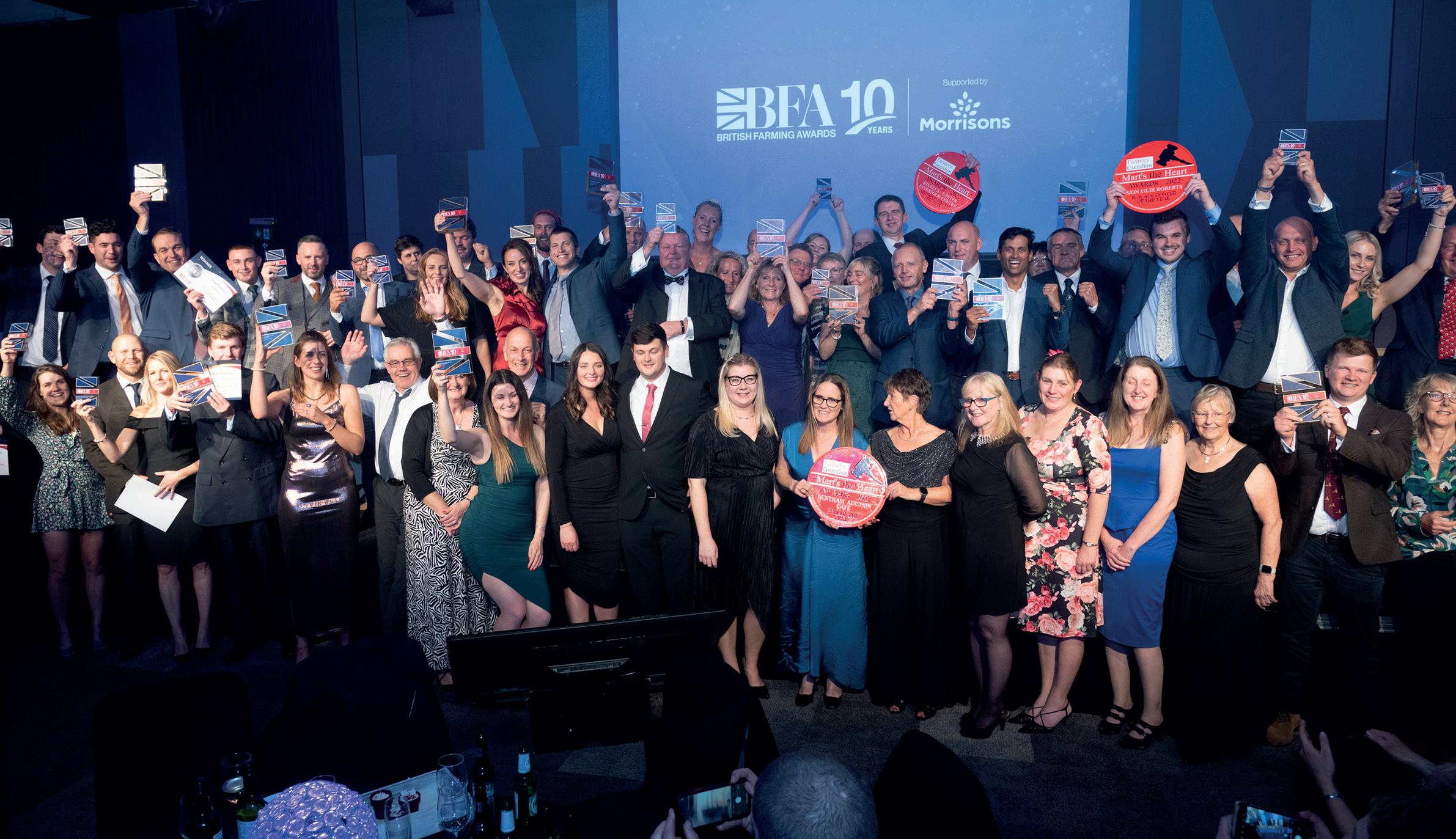
James and Emma Loder-Symonds

Nonnington Farms, Kent Winner of Arable Farmer of the Year at last year’s British Farming Awards

Social media helps us to sell our story to the public. These awards are shouting about what the industry is doing and telling good news stories
Ewan Irvine and Emma Gray
Sheepdog School, Argyll and Bute Winner of Digital Innovator of the Year and Diversification (small to medium) at last year’s British Farming Awards
It feels amazing [to have won] and I am very humbled. I am proud to be a part of an incredible industry which has only grown through adversity
Gordon Davis Rivermead Dairy, Devon Winner of Dairy Farmer of the Year at last year’s British Farming Awards
KEY DATES
MARCH
Entries and nominations open


JUNE 27



Entries close

AUGUST 11

Shortlist announced










AUGUST
Judging and interviews take place
OCTOBER 19 Awards night
Sponsored by
DIVERSIFICATION OF THE YEAR (large) GRASSLAND FARMER OF THE YEAR Sponsored by Germinal FAMILY FARMING BUSINESS OF THE YEAR Sponsored by Goodyear SHEEP FARMER OF THE YEAR Sponsored by SAI Global OUTSTANDING CONTRIBUTION TO BRITISH AGRICULTURE Sponsored by NSF FLYING THE FLAG FOR BRITISH AGRICULTURE Sponsored by Eternit SUSTAINABLE FARMER OF THE YEAR Sponsored by Lloyds Bank FARM WORKER OF THE YEAR Sponsored by Isuzu NEW ENTRANT: AGAINST THE ODDS Sponsored by Massey Ferguson For more information on the categories and how to enter and/or nominate, visit BRITISHFARMINGAWARDS.CO.UK
17
29 APRIL 2023
Last year’s winners celebrate together after winning their awards.
Understanding more about the impacts of management practices on the organic matter content of soils is an increasing priority for one of the UK’s largest mixed farming operations, with regular soil carbon content checks becoming routine. Arable Farming reports.


How monitoring soil carbon can help boost productivity on-farm
Monitoring soil carbon content on Grosvenor Farms’
2,350-hectare arable and dairy enterprise in Cheshire is helping boost productivity and fine-tune sustainable farming practices for the future.
That is according to farm manager Charlie Steer, who says while many growers think of soil carbon content simply as a number needed for completing Sustainable Farming Incentive (SFI) applications or to get a handle on a farm’s carbon trading potential, for Grosvenor Farms it is all about managing the business more efficiently.
Mr Steer says: “There’s so much evidence of a direct and linear relationship between soil organic matter and productivity that soil carbon content is rapidly becoming one of the most important management KPIs we use.
“It is an essential indicator of a farming business’ overall viability and production potential, but there are wider implications of developing management practices that build soil carbon content too.
“At the farm level, for example, improved soil carbon content is linked to a multitude of benefits such as better soil structure, improved key nutrient use, better nitrogen utilisation efficiency, improved moisture retention and healthier soil biology.
“It’s widely known that French Environment Minister Sebastian Le Fol’s ‘4 in 1,000’ initiative suggests if carbon levels in the top 30-40cm of soils globally were raised on average by 0.4% per year, this would have a major effect on countering annual CO2 increases.”
Building soil carbon content year on year is therefore a key business objective of Grosvenor Farms in line with its journey
towards being fully carbonneutral by 2030, Mr Steer says.
“I suppose we have always been carbon-aware producers but just haven’t fully recognised it as such until recently.
“But it’s like all things, it’s not until you start measuring different aspects of your management that you can really get a handle on what really matters.
Decisions
“With carbon content, for example, if you don’t know what’s in your soils to start with it’s impossible to know whether the decisions you make are improving it or depleting it.
“Carbon content and organic matter take time to build so you really need to know you’re minimising any potential setbacks and heading in the right direction year on year.”
Improvements on the arable side have largely been down to the use of manures to build organic matter, with tangible improvements being seen.
“We use separated solid and liquid manures from the dairy herd plus a bit of box muck, all of which are tested regularly by NRM when we are spreading, so we know exactly how much N we are applying and ensure our P and K remain on target.
“Reducing dependence on bought-in nitrogen is of increasing priority for us and in last year’s ADAS YEN Zero initiative for combinable crops we ended up in the top 10% of farms with the lowest kg of CO2 or equivalents per tonne of output – all without applying any manufactured nitrogen.

“At the moment, just 33% of our combinable crop’s nutrition comes from non-organic sources and I think this is a major reason behind the improvement in soil health and organic matter we have seen.
“A few years ago, we were at an average of 5% soil organic matter across the farm and we’re now at around 5.5%, so we’re steadily improving all the time.
“When you realise that typical values for cultivated land are around 3%, this is quite an achievement.”
Changes to the rotation have allowed fewer cultivation to be used, which has also played a significant role in building soil organic matter, Mr Steer adds.
“Very little land is now ploughed. We have a six-year arable rotation with three winter wheat crops interspersed with barley, a wholecrop cereal or oats, oilseed rape or forage rye. Cover crops and stubble turnips are also grown.
30 TECHNICAL SOIL HEALTH APRIL 2023
Materials are tested regularly when muck spreading is carried out.
“With land also going into rotational grass and clover it’s an approach that really is starting to improve the health and carbon content of our soils.”
Grosvenor’s latest soil carbon analysis has been carried out using NRM’s CarbonCheck service. NRM agronomy manager Allison Grundy says the results highlight where the farm can continue to make progress.

Ms Grundy says: “Soil carbon content is a very good starting point in itself, but there are numerous associated areas that give additional insight into what is really happening in the soil.
“Many people use CarbonCheck to evaluate the natural assets across their farm, to get a handle on their existing carbon stocks and to start their own carbon capture journey.
Analysis

“Those joining the SFI schemes also use the analysis to get the details they need to complete their payment applications.
“But those who benefit most are the ones who use the service beyond this and realise it’s an invaluable tool in helping them fine-tune their management, reduce input costs and improve crop production efficiency.
“Measuring a range of parameters associated with soil carbon content is a very effective way of monitoring soil health and production potential.

“Benchmarking on-farm results against national and regional best practice then allows producers to make the most informed decisions about adopting and integrating more long-term, sustainable farming practices.
“CarbonCheck measures organic and active carbon as part of a comprehensive suite, as well as total carbon, inorganic carbon, carbonate classification and bulk density.”
This gives details on traditional information such as organic matter as well as combining information from a number of different carbon measurements, total nitrogen and the C:N ratio, she explains.







“Active carbon, for example, is a management tool that looks at the readily available portion of soil carbon that provides an immediate food source for soil microbes and is easily digested and turned over by the soil microflora.




“Importantly, it’s also the precursor to building humus-type organic matter, which is the type that can








really lock away carbon in a more permanent state.”



A soil bulk density measurement is also an important consideration, Ms Grundy says.
“The denser and more compacted the soil, the less effectively the soil microflora are able to function and process organic inputs and residues.




“The better structured and more open the soil texture, the more efficiently the biology can work, and the better it can turn over and recycle key nutrients.”
While there is a lot producers can do to build carbon content from a management perspective, some areas are less flexible, she adds.
“One of the key drivers behind
how easily you can build soil organic content is the type of soil and in particular the clay content.

“Clay content does drive organic matter and, generally speaking, we know grass-based production systems on more medium to heavy soil types have the most carbon and organic matter in them.
“In arable soils in areas such as East Anglia, where much of the arable land has a lighter texture, organic matter can be as low as 1-2%. Drier soils tend to be lower in organic matter too.”
No quick fix
While improvements in soil carbon content are obviously being made in line with Grosvenor Farms’ stated objectives, it is an ongoing journey rather than a quick fix, she says.
“According to AHDB, using green composts as your organic fertiliser source can lead to a 25% improvement in soil carbon levels in nine years. The same can be achieved from farmyard manure in 20 years, and 20 years of using livestock slurry results in just a 7% change.
“In the shorter term of three years, applying livestock slurry gave no quantifiable improvements in carbon content, so the fact that Grosvenor is improving its soil carbon content is a real testament to the overall steps they are taking to lift this.”
31 TECHNICAL APRIL 2023 UREASE INHIBITOR NitroShield Protecting your nitrogen Improves Nitrogen Use Efficiency Reduces ammonia losses by 70%+ Contact us today 01526 396000 Visit www.omex.com Email agriculture@omex.com
Grosvenor Farms’ manager Charlie Steer and NRM CarbonCheck manager Allison Grundy.
Fungicide failures arising from resistance development in disease populations are costly to growers and manufacturers alike. In Europe, disease monitoring to keep abreast of resistance is coordinated by the Fungicide Resistance Action Committee (FRAC).

FRAC recently published results from monitoring conducted during 2022. Bayer head of resistance and FRAC member Dr Andreas Mehl shared some of the findings during a Bayer-hosted resistance workshop in Essex.
Monitoring of septoria (Zymoseptoria tritici) was conducted by BASF, Bayer, Corteva, FMC and Syngenta across mainland Europe, the United Kingdom and the Baltic and Nordic regions during 2022. Overall results for prothioconazole, the cornerstone of many wheat and barley fungicide programmes, show a small shift towards higher mean EC50 values - the concentration of the fungicide required to achieve 50% control - compared to 2021, with the most consistent and strongest shift seen in France.
In the UK and Ireland final data for 2022 for prothioconazole show a ‘slight but clearly visible’ sensitivity shift, mainly as a result of the identification of isolates with higher EC50 values originating from Yorkshire and the West Midlands, said Dr Mehl. This compares with 2021 data which showed generally unchanged sensitivity in Ireland and the UK compared to the previous season, albeit with a slight trend to higher sensitivity in the west of the UK, and slightly increased mean EC50 in the East.
Septoria -
Ongoing monitoring is helping keep track of resistance development in pathogens. Teresa Rush reports on some of the latest findings.
Are fungicides still working?
between SDHIs, said Dr Mehl. Some mutations are linked with low resistance factors - where resistance factor (RF) is the level of deviation away from reference or ‘baseline’ isolates – but represent the majority of detected mutations and show an increase in frequency. Moreover, some mutations are affected by fitness penalties, which means they are unlikely to become the dominant strain in the field.
Sensitivity shifts observed elsewhere in Europe can provide an early warning for the UK, although different approaches to fungicide use must be considered.
Shift
Monitoring results from 2022 show clear evidence of a sensitivity shift due to an increase in septoria isolates with higher EC50 values for prothioconazole in several regions across France, including Aquitaine, Britanny, Centre (which includes the Paris Basin), Champagne and Midi Pyrenees. This contrasts with 2021 data from France, which
revealed sensitivity remained stable overall.
In Germany, the 2022 data shows sensitivity to prothioconazole was broadly unchanged and within the range seen during the past seven years, although there was a slightly wider sensitivity spectrum compared to 2021. Sensitivity to prothioconazole in Nordic and Baltic states was found to be stable in 2022 monitoring.
In SDHI fungicides the situation is complex with sensitivity influenced by several mutations. Furthermore, the sensitivity impact of a mutation can differ
sensitivity in UK and Ireland 2022
Last season’s monitoring for bixafen sensitivity showed that in the UK, 13% of isolates were ‘bad’ mutants with an RF of >30, that is to say their EC50 value was 30 times that of the reference isolates in the test, and 44% were ‘soft’ mutants with low-to-moderate RFs of 10-30. Overall, mean RF widened in Europe with strong outliers seen in northern Germany, UK, Ireland, Belgium, the Netherlands and Poland.
This shift in sensitivity highlights the need for use of sufficient rates of an appropriate mixture partner with SDHIs, said Dr Mehl.
“This for me is really crucial,” he said.
Monitoring of yellow rust (Puccinia striformis) isolates during 2022 revealed a still quite homogeneous sensitivity distribution in Europe to prothioconazole. In addition, there was still full sensitivity in Europe to the SDHI isoflucypram (Iblon) and full sensitivity to the QoI fluoxastrobin, added Dr Mehl.
For more on 2022 monitoring results, go to frac.info
ONLINE
32 TECHNICAL CEREAL DISEASE APRIL 2023
Fungicide resistance monitoring conducted during the 2022 season revealed declines in the sensitivity of septoria to some key actives, highlighting the need to follow FRAC guidelines.
rRegional mEC50 range (mg/l) rLeinster 3.2-6.4 rMunster 4.9-8.0 rWest Midlands 4.4-9.0 rEast Midlands 4.6-5.5 rEast Anglia 3.4-7.5 rSouth West 4.4-5.2 rSouth East 4.6-7.8 rYorkshire 5.6-9.5 rNorth East 6.0-7.4 rScotland 5.1-6.3 r(EC50 range reference isolates 0.6-2.0mg/l) Source: FRAC
prothioconazole
MORE
The new packaging range brought to you by the innovative team at Syngenta. New ergonomic design developed in collaboration with growers. Compatible with the easyconnect Closed Transfer System.





VERSATILITY IMPROVED GRIP & HANDLING CLARITY ACCURACY
Syngenta UK Ltd. Registered in England No. 849037. CPC4, Capital Park, Fulbourn, Cambridge CB21 5XE Tel: 01223 883400 Fax: 01223 882195 Email: product.technical_enquiries@syngenta.com Web: www.syngenta.co.uk. REVUS® is a Registered Trademark of a Syngenta Group Company. REVUS (MAPP 17443) contains mandipropamid. Use plant production products safely. Always read the label and product information before use. For further product information including warning phrases and symbols refer to www.syngenta.co.uk © 2023 Syngenta®. All rights reserved. The information contained in this publication is proprietary. It may not be photocopied or reproduced in any form. EVOPAC™, the Alliance frame, the Purpose icon and the Syngenta® logo are trademarks of a Syngenta® Group Company. March 2023. 12595
PRODUCT AVAILABLE IN EVOPAC
FIRST
Crop management platfor efficiencies in the potato
With ongoing pressure on margins, Arable Farming takes a looks at how a potato crop management platform is helping support agronomic decision-making on-farm.


Potato growers and agronomists are managing ever-larger areas, and the production process is growing in complexity too, creating a need for decisionmaking tools able to handle the multitude of factors at play.
Crop4Sight was launched in 2019 to offer this kind of assistance, and has been gaining users ever since.
One example on the platform is the seed module, which user John Weir says has been particularly useful across his 70 hectares of pre-pack potatoes around Gateside, Fife, during pre-season planning. It provides users with dynamic recommendations based on a host of variables rather than the broad-brush traditional seed rate tables based on just two dimensions: seed size and planting window (early, mid or late).
With Crop4Sight, he enters variety, planting date, seed size (tuber count per 50kg seed) and chronological age (the time between 50% emergence of the
seed crop and planting of the ware crop). These four factors influence the number of stems and tubers produced per plant, with implications for crop development and final marketable yield.
Crop4Sight benchmarks the data against independent variety trials and commercial crop data to provide a precise seed rate recommendation for a target stem and tuber population from a given seed lot. As the system is live, the user simply changes the planting date in the system to get an updated recommendation if there is a delay due to weather or a mechanical breakdown.
Data set
Mr Weir has found the seed module particularly beneficial when growing varieties for the first time, where information on seed rate calculations is limited and based on a small data set.
He says: “Before Crop4Sight, you might have an indication from the seed house, but you never really knew if you’d got things right until the end of the season. We can now manage those crops better from the start.
“Then, once you get going with plant, stem and tuber counts, and collect data from monitoring crops throughout the season, you build a valuable picture which will help fine-tune management of those varieties in the future.”
The system has also given Mr Weir and his agronomist the confidence to cut seed rates back
further than they would have previously dared in some instances.
Further south, near Newport, Shropshire, John Bubb also uses the seed module, calculating rates for the 200ha of processing crops he grows for McCain. He finds one of the most interesting parts of the seed module’s output is its plant and stem count predictions, which are ground truthed once crops are up and away.
When actual plant and stem count data are entered, Crop4Sight forecasts the final tuber population and biological yield for each crop, giving an early indication of which crops should be ready to harvest first.
Mid-season yield digs – about 50 days after emergence – add further data for the module to refine its forecast of crop development and add tuber size distribution and final marketable
yield. This intelligence helps schedule desiccation and harvest, along with inputs like maleic hydrazide (MH), which is now a key part of sprout suppression programmes (see panel)
It is also useful for customer McCain to get a good idea of when Mr Bubb’s early crops of Morene and Shepody will be ready to be delivered.
“It helps us plan harvest accurately so we get all 200ha out the ground by October 20, which is always our target,” he says.
Early frosts
Not far away in Newport is Richard Maddocks, who grows 140ha of pre-pack and processing potatoes, and says his customers have also benefited from his adoption of Crop4Sight. No more so than when his crops were hit by early frosts
34 TECHNICAL POTATOES APRIL 2023
Crop4Sight’s irrigation scheduling module has helped to improve water management across the potato area, says Shropshire grower Richard Maddocks.
John Weir
platform delivering supply chain
been able to prove it with any degree of confidence.
“They were then able to speak to other growers to find out the scale of the problem and adjusted its maximum size specification to 90mm instead of 85mm, ensuring they had continuity of supply and growers could maximise marketable yield.”

Water management
Mr Maddocks has added Crop4Sight’s irrigation scheduling module to his package for the past two seasons and says it has helped to improve water management across his potato area. He previously relied on soil moisture probes, which record soil moisture deficit (SMD) in real time down to 50cm, then transfer the data to a remote server.
The probes are typically placed in select fields where pre-pack crops are being grown, as scab control is critical to good skin finish. However, the readings from those locations aren’t necessarily representative of the areas in between and so Mr Maddocks decided to try the Crop4Sight irrigation module alongside the sensors.
irrigating for scab control or yield, and draws on hourly meteorological data for the field location, including evapotranspiration, relative humidity, and rainfall to calculate a water balance.
The farm’s irrigation is overseen by farm manager Matthew Dudley, who backs up the rainfall data with his own rain gauge readings from which the module produces a field-by-field irrigation schedule for the week ahead. This is refreshed and recalculated with every rainfall event, and Mr Dudley says one of his favourite features of the irrigation module is its accounting for irrigation capability. This is one of the farm’s main water challenges, with pumping capacity relatively low for the area of crop, so not all its irrigators can run at once when demand is high.
“You can enter how long it will take to get back to a field and it adjusts water applied to ensure it has enough to cover demand until you get back. It also helps plan movement of irrigators around the farm.”
in 2021, which meant that stem numbers in packing variety Jelly were lower than expected. Having entered this into the module as early as June, it showed Mr Maddocks that forecast tuber numbers were
down and the sample would be bold, way ahead of his scheduled delivery period between September and November.
“We had the conversation with Greenvale – without Crop4Sight, we wouldn’t have
Users enter soil type, variety information, the farm’s irrigation capabilities (how quickly irrigators can get back to a field) and the quantity and timing of water already applied. The module then asks users to choose between
The irrigation model gets an update for 2023, allowing users to input and access data through a smartphone app, which Mr Dudley says will save time.
“I can update the system as I’m moving around the farm and see any tweaks to the schedule without having to return to the office.”
Crop development insights helping growers get the most out of MH
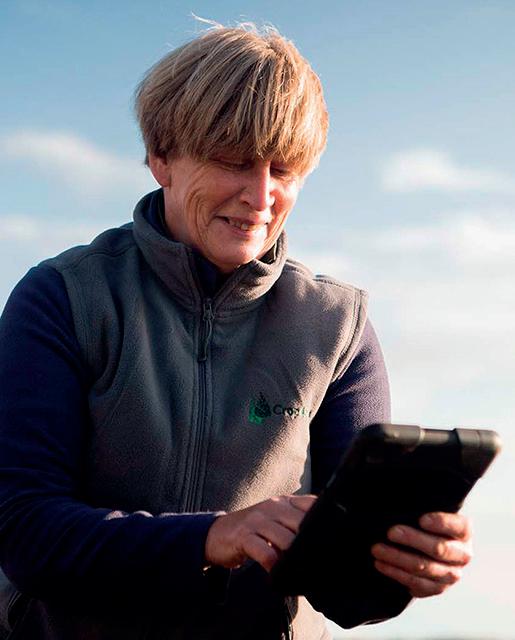
JWell-timed application is the key to getting the best out of maleic hydrazide (MH), and Produce Solutions agronomist
Fiona Law-Eadie says Crop4Sight reliably forecasts the optimum spray window.
As soon as the emergence date of a crop is known, a ground cover development curve is produced and displayed, showing when the crop should reach 100% ground cover and when it
should start to senesce. This is ground truthed by mobile phone or satellite imagery uploaded through the season, along with earlier plant and stem counts, plus a mid-
season yield dig. With all this data entered, the system predicts when tubers will reach the optimum marketable size.
Optimum
Mrs Law-Eadie says by knowing when the crop will start to senesce and stop gaining further marketable yield, an optimum haulm destruction date can be pencilled in.
“Counting back five weeks gives an earliest application
date for MH. Sprayer operators then need to wait for the right conditions before applying during the three to five weeks prior to desiccation window that manufacturers recommend.
“Crop4Sight is a useful tool for forecasting canopy duration and yield, which in turn gives you confidence in hitting the optimum spray timing for MH. That should give you good early sprout suppression in store.”
35 POTATOES TECHNICAL APRIL 2023
Fiona Law-Eadie
FULLY LOADED HYBRIDS HYBRIDS


Results from the Yield Enhancement Network growers achieving high yields by focusing on from livestock on-farm. Ash Burbidge reports.
How the 2022 oilseed rape achieved their
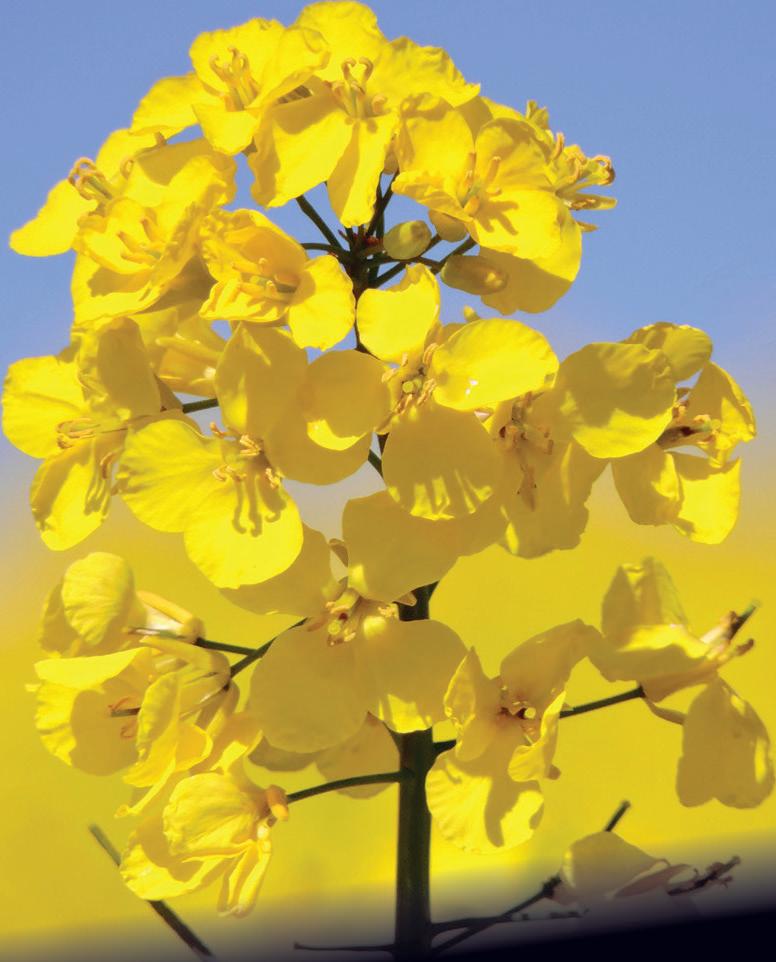
Last harvest, on a mixed farm in Ewelme, Oxfordshire, grower David Passmore harvested close to seven tonnes per hectare of oilseed rape (OSR).
He had planted a total OSR area of 30ha for harvest 2022, on shallow soils which are mostly over chalk. His crop of conventional variety KWS Campus earned him a Yield Enhancement Network (YEN) gold award, achieving 96% of the predicted 7t/ha potential yield.
He says: “This [was] our ninth year of growing [KWS Campus]. We grow it for seed, but it’s done us very well. We have had even better yields than this.
“It’s a speedy variety that gets out of the ground quickly – we drill it late to reduce cabbage stem flea beetle (CSFB) pressure in the autumn.

ATTICA
Highest yielding TuYV and pod shatter resistant variety on the recommended list

“It’s a variety that’s done us well, so I am reluctant to change when we are achieving those yields.”
Mr Passmore maintains a very wide rotation of 10-15 years between OSR crops, with last season only the second time the winning field had grown OSR. In the past, he has prepared his soils by applying farmyard manure (FYM), ploughing and
pressing, which achieved good results; however, he found that the risk of crop failure due to CSFB was increasing because of dry seedbed conditions.
“The last few years, we have gone into strip tillage, with this crop planted with a Claydon drill straight into stubble. We try and leave the stubble quite long.
“We have done this for several years and have had very good results.















“I don’t quite understand why long stubble makes such a difference to the CSFB pressures, but it definitely looks like it’s a factor,” he says.
Drilling
He applies digestate onto the stubble prior to drilling and has a set ‘not before’ drilling date that he adheres to.
“The earliest we will plant is September 1, and we drill before the rain.
“The last two years we have [drilled] around [September] 8 or 9 and we have seen relatively low flea beetle pressures in the autumn.
“We will not drill early,” he says.
He believes oilseed rape benefits from the presence of livestock on the farm, enabling him to grow strong crops that root well. With a high soil organic matter content achieved with the inclusion of FYM and


36 TECHNICAL OILSEED RAPE APRIL 2023
lgseeds.co.uk/attica
(YEN) 2022 competition saw oilseed rape rotation and variety choice, and benefiting





2022 YEN rape winners their success

grass leys, crops can source nutrients and water more easily than they would in a more conventional and less livestock-focused rotation.

“It probably is a bit excessive but when we have a lot of livestock on the farm we aren’t looking for break crops, we put a certain percentage of grass in [to the rotation] every year and then three years later it’s going into an arable crop,” he says.

He describes his input strategy as ‘nothing unusual’. The long rotation means the land’s weed burden is low and OSR disease is controlled with a standard three-spray programme.






“For fungicides, we go through a standard ‘NIAB’ program to include one application in the autumn and two in the spring. We also apply 180-200kg/ha of urea.





“A key learning of the YEN








TECHNICAL
OILSEED RAPE
lgseeds.co.uk/aurelia
David Passmore from Oxfordshire won gold at the YEN awards achieving 96% of the predicted 7t/ha potential OSR yield.
The UK’s Number 1 Oilseed Rape Variety
Robert, Scottish Borders
“ THE VIGOUR TERRIFIC” SIDE OF AURELIA IS JUST
AURELIA FULLY LOADED HYBRID
TECHNICAL OILSEED RAPE

project is that chucking money and inputs at [the crop] doesn’t necessarily buy you yield. The higher-yielding crops aren’t really getting anymore inputs than the lower-yielding crops,” he adds.
A key focus of YEN 2022 was the concept of ‘farm factor’ variance, where each grower analysed their farming practice and individual fields to identify limiting factors personal to their system, helping inform where improvements could be made. Mr Passmore described his ‘farm factor’ as the rotation he adopts.
Impact
The long-term impact of traditional practices such as livestock, regular grass leys and stubble turnips have accumulated to promote good soil, says Mr Passmore.
“They’re not really measurable but you can see the effect after a long time,” he says.
The YEN 2022 oilseed rape silver award went to Dumfries and Galloway grower Mark Lawson, who achieved 84% of a potential yield of 7.39t/ha with a crop of LG Acacia.
Mr Lawson originally bought the farm for livestock but converted to arable farming as a result of increased feed costs. The soil type is shallow and stony, and he bases the rotation on wheat, barley and OSR.
“Our farm’s average oilseed rape yields can be around 3.7t/ ha but if we can push this to 4.2 - 4.4t/ha we are happy.
“We had a field of Acacia oilseed rape that looked good and showed promise, so after discussion with our [seed adviser] we were persuaded to enter part of that field.
“Autumn 2021 had been really kind with all crops drilled in good time. With the high levels of rainfall here, our biggest challenge is getting the crops in the ground in good time.”
Following winter barley, the oilseed rape was drilled into a favourable seedbed using a Simba Xpress, which created a good tilth. The seed rate was 3.55kg/ha, with the aim of achieving an established plant count of 24 plants per square metre.
Why did OSR yield so well in 2022?
JA decade of YEN research shows that while light and water availability remain critical limiting factors to yield potential, successful crops are those with optimal biological growth to convert the energy available into grain.
Maximising biomass puts crops in prime position to
convert sunlight into yield, even if yield potential is limited by factors beyond growers’ control.
Analysis of historic weather patterns and OSR yields has revealed that high-yielding seasons are associated with a warm October, dry December, warm minimum March
Mr Lawson’s agronomist, Richard Bray, of Agrovista, says: “The crop came out of the winter well, so we included growth regulation at stem extension as we wanted to avoid a lodged or leaning crop that would not mature evenly or maximise pod fill. In with this, we also applied a broad-spectrum foliar feed.
Mix
“Tissue analysis highlighted the crop was still short of boron, so we addressed this at the early flowering stage with a four-way mix containing boron, a carboxamide and triazolinthione fungicide, a biostimulant and an adjuvant.”
Mr Bray points out that because the OSR flowering
period can last many weeks further north, a second mix was applied at mid-flowering but with the addition of a crop enhancer to increase chlorophyll production and maximise green leaf area.
“As far as weeds and diseases go, we can have issues with sterile brome, but the oilseed rape does allow us to clean that up. Light leaf spot can be an issue, but again, we were able to keep on top of that,” he says.
Harvest started on August 5 in a neighbouring field where yields were good, raising hopes for the YEN crop.
“We struggled to get it all into the trailer, so we knew we were onto some high yields,” says Mr Lawson.
temperatures, dry/sunny April and a wet/cool May.
The dry spring in 2022 helped to restrict canopy growth, which in turn helped to optimise canopy size at flowering for good seed set and a reduced lodging risk.
Sunny conditions in April helped crops to set pods. Rainfall
in May was particularly beneficial for crops suffering from the earlier dry spring conditions, but the dull conditions might have restricted the number of seeds set per pod. Overall, conditions were conducive to setting high seed numbers and higher potential yields.
Source: Limagrain
38
APRIL 2023
David Passmore has grown KWS Campus for nine years, but his wide rotation means it is only the second time OSR has been grown in the winning field.
BE AT THE FOREFRONT OF A NEW EVENT








Future Farming Expo will make its debut on 10th & 11th October at P&J Live, Aberdeen. The show will support Scotland and its farmers in order to make Scotland a global leader in innovative, profitable, and sustainable agriculture.









WHY EXHIBIT OR SPONSOR?
Forward-thinking farmers, advisors, and rural business owners will attend the Future Farming Expo to learn the very latest techniques, network, and do business.









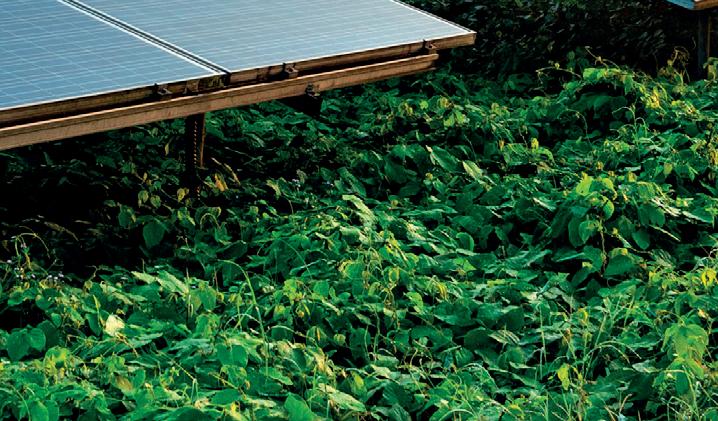



Our attendees need your knowledge, services, and products at their fingertips to future-proof their business. Book your stand, or sponsor a content hub, and showcase your latest research, products and thought leadership. Find out more at www.futurefarmingexpo.com






Topics Include:









2023
CONTACT OUR SALES TEAM TODAY TO DISCUSS YOUR OPTIONS. Joanna Wignall | Business Development Manager 07881 386 250 | joanna.wignall@agriconnect.com
Brought to you by: Livestock Diversification Horticulture and Vertical Farming Robotics Renewables and Energy Carbon and Soils Business and Personal Resilience Arable
Finding sustainability in
How do you rethink a farming system?
Teresa Rush finds out how one unlikely disruptor is tackling the challenge.
Depending on where you get your news from, it might not be obvious that there is a problem with agriculture. The man behind that assertion is Grammy-nominated musician turned farmer and innovator Andy Cato, and he is on a crusade to find a more restorative and sustainable way of producing food.

Possibly a familiar name to some as one half of electronic music duo Groove Armada, he is now an award-winning mixed arable and livestock farmer, and co-founder of Wildfarmed, a community offering a route to market for crops grown in systems that prioritise soil health. His own route into agriculture has been a somewhat unconventional and
certainly intriguing one via a vegetable patch, farming in France and most recently a move back to the UK to take on the tenancy of a 295-hectare National Trust farm in Oxfordshire and set up the Wildfarmed project.
Picking up a magazine while travelling home from a gig marked the start of his farming journey.
He says: “In January 1990, the UK Government began giving grants to farmers to convert to organic methods. At that time, I was 18, I was a musician who had just discovered house music, and farming organic or otherwise was the last thing on my mind.
“Twenty years later, I’d had a musical life. I got to play all over the world. Food-wise, I visited an industrial meat facility once
and became vegetarian. Plus, I’d read enough articles in the newspapers about pesticides to buy organic food, and that was it.
“That’s all I knew about where my food came from, until I read a fantastic article which talked about chemical and oil-based food production, and had the line ‘if you don’t like the system, don’t depend on it’, which led to me trying to grow my own food and spending long hours reading John Seymour’s guide to self-sufficiency.”
Passion
A hobby veg patch grew into a passion. The vegetable patch expanded into a market garden, but it was by no means a smooth ride, and Mr Cato recalls many hours of fruitless effort.
“The long and short of it was that, thanks in no small measure to Charles Dowding’s (No Dig) books, it started to go much better. I ended up selling through the local market, the
little market garden grew, and I decided I wanted to join the ranks of people doing restorative farming on a bigger scale.
“So, I asked my wife, Jo, if she would mind if I sold my publishing rights to buy a farm. She was rightly sceptical about my predictions about how smooth this farming venture was going to go, but she could see I was passionate about it. And so, we ended up with this 110-hectare farm in south west France. The first few years were a
40 APRIL 2023
We’ve created a system that only makes sense because it doesn’t pay its bills
ANDY CATO
disaster. And what became apparent from day one was that the breadth of skills and resourcefulness required to be a farmer is extraordinary and totally underappreciated.”
Mr Cato admits he lost sight of everything he had learned on his vegetable patch. He found himself trying to farm degraded soils that had grown maize for 80 years, and his ambition to farm organically did not go to plan – because, he admits, there was no plan. Three years in, overwhelmed and with everything going wrong, it seemed the farming dream, like the soil he was working, had turned to dust. But an encounter with a classic of farming literature kept the dream alive.
“I came across Albert Howard. He had a very simple message about nature working through a combination of plants and animals, and diversity of plants and animals in the same place at the same time. His message was about this

complexity of nature and, when we split that up into its component parts, we take a beautiful solution and create lots of problems.
“From Albert Howard I was convinced of the need to integrate livestock and that led to a last throw of the dice, to becoming a rookie owner of a herd of Red Sussex and putting half the farm down to herbal leys. And that was a revelatory moment. All the fields had chronic weed problems, including thistles. In the herbal ley I saw the thistles disappear in really quite a short space of time. I’d read that weeds will disappear when soil conditions are no longer favourable [for them], but it sounds hopelessly utopian until you see it with your own eyes.”
Further inspiration came from Australia in the form of drilling cereals straight into pasture. This looked pretty good in the autumn and always looked terrible in the spring, says Mr
Cato. There were semi-successful harvests, but also the realisation that grain markets place no value on how grain is grown and what its nutritional value might be. His next move was, perhaps inevitably, to start making flour, and a farm shop followed. Meanwhile, the pasture cropping idea developed and became mechanised.
“This involved making a sort of strip-till system, with a very primitive and semi-lethal mower, the idea being to mow the grass so you can control what’s going on between your crop rows. This system started to work quite well, which warranted turning the mower into something a little bit more serious and safe.”
Pasture cropping

But the geology in Gascony was unkind, as was the weather. With serious soil erosion further adding to the difficulties of farming in the region, Mr Cato embarked upon pasture cropping trials in the UK and the seeds of Wildfarmed were sown.
Around this time, he came across Dr Christine Jones, an internationally renowned soil
ecologist. Her message that plant diversity is the real driver of soil recovery and soil health reframed the whole project, he says.
“The Romans were growing olives, figs, grapes, cereals, legumes and pomegranates all together 2,000 years ago, and I saw that Thomas Jefferson sowed buckwheat, vetch and turnips together to, as he put it, ‘cure tired soils’. There was lots of great experience in the UK from people like Andy Howard, and Josiah (Meldrum) at Hodmedods, who had been working in this area of bi-cropping before. So, we started to try to pursue that with a widening community of growers.”

But to get back to that problem with agriculture.
“Sometimes I think when you’re caught up in something, you can assume that the problems you’re trying to solve are universally accepted and acknowledged, and from our experience this is far from being the case,” says Mr Cato.
“Because if you look at the headlines: yields have doubled since 1961; the amount of household income spent on food
41 PEOPLE ARABLE APRIL 2023 in
complexity
Musician, farmer, sustainable farming advocate: Andy Cato is working to restore ‘complexity in abundance’ in farming systems.
Convinced of the need to integrate cattle and cropping, Andy Cato introduced a herd of Red Sussex to his farm.
has gone down by two-thirds in the same period; we produce enough calories for 10 billion people, and it requires less than 1% of the UK population to do all the work in agriculture.
“But there’s an untold story underneath those headline numbers, which is that since 1940 we’ve gone from one calorie of energy to produce three calories of food to the opposite – three calories of energy to produce one calorie of food. There’s been an explosion in dietary diseases and obesity; soils have been degraded, and in the 50 years I’ve been alive, we’ve lost half our wildlife. And we’ve created a system that only makes sense because it doesn’t pay its bills.”
Henry Dimbleby’s National Food Strategy provides an exhaustive analysis of the externalised costs of food, but despite externalising these costs, things have not been great for farmers, Mr Cato maintains, pointing to the persistent weed and pest problems they have encountered.
“And yet, I’d say there’s no reason to feel depressed or hopeless, as a growing number of growers around the world are proving that we can combine restored, flourishing ecosystems with producing the food we need.”
Optimism
This optimism is grounded to some extent in the belief that the originators of modern intensive farming, such as Norman Borlaug, had good intentions.
“I think maybe the problem is that the agriculture that resulted was very suited to our economic models. It was simple, it was repeatable, and it was based on control. And the paradox in farming is that simplicity is disruptive, and it has proved ruinously expensive to society as a whole. It’s complexity that we need to get back in abundance.”
Wildfarmed is Mr Cato’s response to this problem. Its ethos is about getting soils from the point where they are suited to growing weeds to a point where they are suited to growing
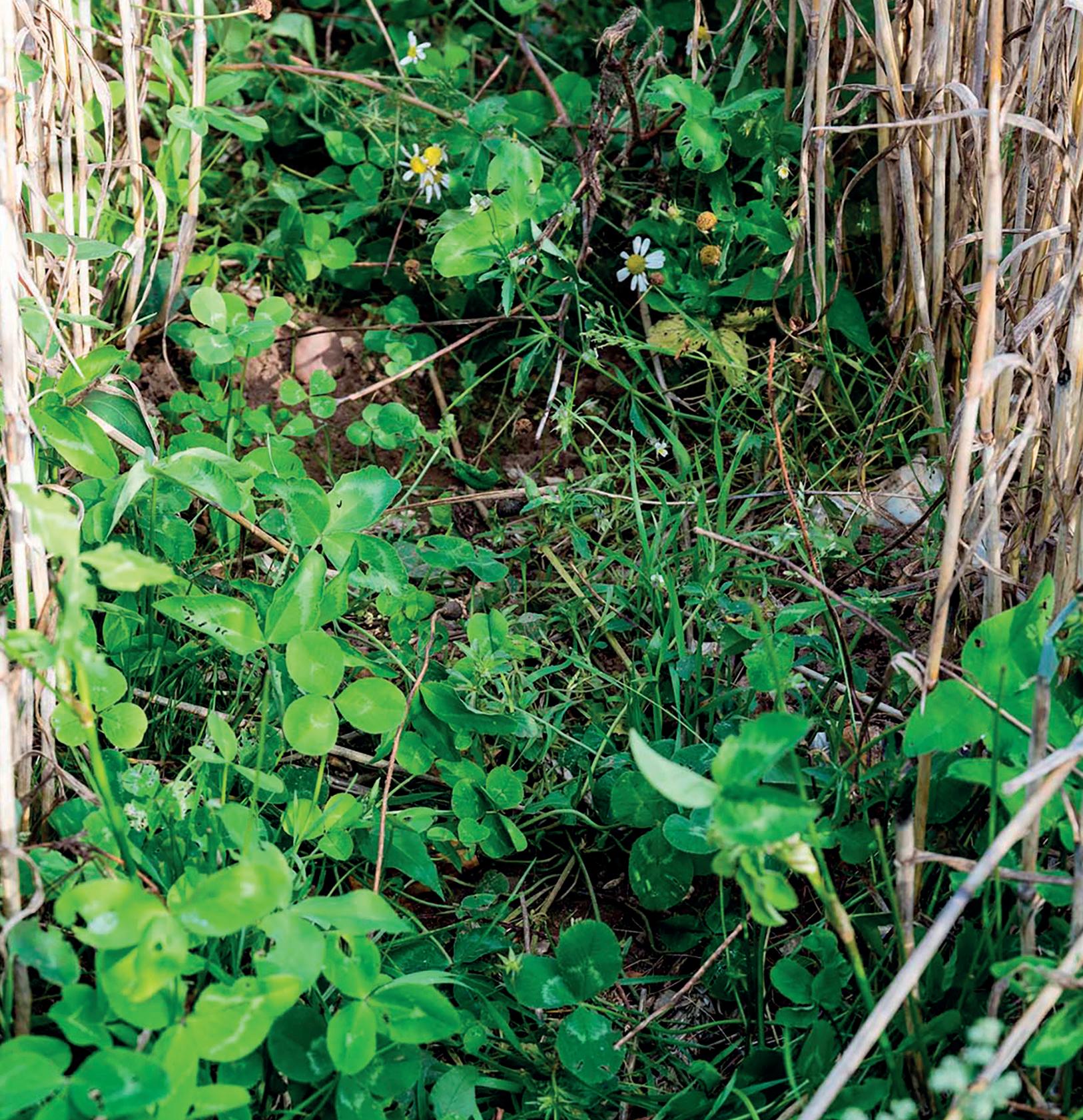
crops, and plant diversity has a massive role to play in this, he says.
“Our experience so far in a couple of years of trying to build this Wildfarmed community has been that community is as important as price in terms of changing farming practices. The pressure to do something different to our peers or rather the stress of doing something different to our peers is huge.”
He describes Wildfarmed as a community of 50 diverse,
inspirational farmers, trying to find flexible ways to move part of their farm from food production based on chemistry to food production based on biology, focused around a particular set of diversity-based cropping systems.
“It is a very similar model to the Soil Association’s Innovative Farmers network and it’s a community that’s always in touch, always exchanging information.”
Inclusive
Wildfarmed is currently updating many of its protocols based on learnings from the past couple of years, but its approach to setting ‘rules’ is inclusive.
“A very, very short version of the rules that our growers follow is: no herbicides, pesticides, fungicides, and plant diversity at all times. But just to give an example, one of the things that we’ve discussed as a group is nitrogen, and as an organic grower, throughout my farming career, I’ve never used artificial nitrogen.
“But being surrounded by such a cross-section of brilliant farmers, it challenges your beliefs. And the conclusion that we’re coming to at the moment is that small amounts of targeted nitrogen may actually be really helpful in recovering systems, increasing photosynthesis and the energy going into the soil.
“But too often these debates are held in black and white terms, and things are rarely black and white, they’re more often grey. And the third aspect of this is that if we’re going to transform an arable system at scale, we have to address the food security issue. If we back a transition to a biology-based farming system, we’ve got to do that without importing more grain.”
Upcoming plans include research projects involving members of the Wildfarmed community, Rothamsted Research and the Soil Associa-
42 APRIL 2023
We can combine restored, flourishing ecosystems with producing the food we need
ANDY CATO
Growing pulses or clovers in wheat fields means they will be full of flowers for pollinators, says Andy Cato.
tion’s Innovative Farmers; working with the Soil Association Exchange platform, and connecting with urban populations on food.






“We did some very unscientific vox pops in a couple of London streets recently where we asked 100 people for their views on regenerative agriculture. No one had heard of it. But it’s absolutely critical that our predominantly urban population hears the story of soil. Then again, there is only any point in telling that story if they can go and buy food at a price they can afford.
“It’s complicated, but fundamentally, we have to open the door to people just thinking about food at all. And some people seem to confuse democratising this message with greenwashing. We live in a noisy world, and this is a complex issue. Boiling it down into slogans to get people interested is something we spend a lot of time doing, and I stand by the need to do that.”
A role for new digital technologies is not ruled out, with Mr Cato seeing ‘huge opportunities’ around blockchain-style relationships and ‘digital localism’.



“We’ve spent hours and hours with procurement teams, and our key message [is] rather than investing in offshore environmental schemes to meet whatever targets they’ve set, just pay more for ingredients.”


In terms of practical actions, there is a need for farmers to be able to more easily develop and share varieties that are suited to low-input systems, he maintains. Furthermore, subsidies need to be aligned with desired outcomes.



“For example, farmers get paid to establish pollinator flower strips. And yet, what we’re doing by growing pulses or clovers in wheat fields means that they’re full of flowers for pollinators. And so, we’ve already said that the Government gives a value to flowers as pollinators, so let’s just include that in practices in the field, not just around the edges.”


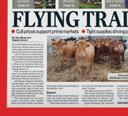























Innovation


There is also a need to support innovation and technologies that are answering the right questions.
“The inter-row mower is a piece of technology that I think is answering the right question, but all that R&D was self-funded, and it is now being built by an engineer in Devon who’s had a load of ideas to make it better, but he can’t afford to take on an apprentice, so let’s get behind these people.”
Mr Cato reflects that “we’re probably closer to landing on Mars than we are to understanding how soil ecosystems work.”
But there is knowledge around the conditions in which those ecosystems can thrive, he says. And so, his call is for all those trying to develop food and farming systems that create thriving soil ecosystems to support one another, because, as he puts it, ‘history is littered with defeated rebel alliances riven by infighting’.
‘Rebellion’ and ‘UK farming’ rarely appear in the same sentence, but Mr Cato is a man who made a musical career taking people on a journey of discovery. Could he just possibly do the same in agriculture?




43 PEOPLE ARABLE APRIL 2023 *Terms and conditions apply. New subscribers only, o�er expires May 12, 2023. Call 0330 333 0056 Visit online at: FGInsight.com /spring23 Two easy ways to subscribe VIP+ membership with our Subscribe in spring & save
on
For more information on Wildfarmed, go to wildfarmed. co.uk
lecture
J Andy Cato gave the Soil Association’s 2023 Peter Melchett Memorial Lecture, available
youtube.com/ watch?v=kVkNdouVnz4 r
Memorial
Half the farm in France was put down to herbal leys.
Innovation could lead to even cheaper food and more waste
JDriving innovation and productivity to produce more food in a bid to tackle food security issues could lead to even cheaper food, more food waste and overconsumption, an emerging risks expert has warned.
Prof Tim Benton, who leads the environment and society programme at Chatham House, told NFU Conference: “We hear all the time we need to grow more to be food secure.
“But history shows that, in the longer term, the more we innovate to produce more food, the more prices come down and the more it becomes economically rational to waste food.
Unsustainable “We repurpose food and put it to biofuels or cattle feed and we overconsume.
“In the long run, just driving up productivity all the time makes the food system more unsustainable rather than more sustainable.”
Instead, a key focus should be how to ‘grow the right things in the right way,’ he said.
“No-one in Government
is asking these sorts of questions.”
The world only produces a third of the fruit and veg required if everyone was to eat five-a-day, but double the amount of grain is grown, Prof Benton said.
“UK food security rests as much on securing fruit and veg as it does grain, meat and dairy. Locally or globally we don’t incentivise production or supply that could sustain healthier, more sustainable products.
“Efficiency is a great thing to have, but efficiency in and of itself does not make a food system fit for purpose.”
His talk came after NFU president Minette Batters earlier told the conference that UK egg production had fallen to its lowest level in nine years, and production of salad ingredients such as tomatoes and cucumber was expected to fall to the lowest levels since 1985.
An NFU survey found 40% of beef and 36% of sheep farmers were planning to reduce livestock numbers in the next 12 months, with soaring input costs the main reason.
Political impertinence may have made headline news at this year’s NFU Conference, but there were plenty of technical takeaways too.

Alice
Dyer
and Ash Burbidge went along.
The drive for gene editing in UK beet B
ritish Sugar is working on ‘three fronts’ to exploit the potential for gene edited (GE) sugar beet in the UK, in a bid to tackle virus yellows disease, which has decimated national crops.
Speaking during the sugar beet breakout session, Daniel
Green, director of agriculture at British Sugar, said the company had been working closely with Government to put the case for the technology, spoken to its customers and had initiated a collaboration with Norwich-based gene editing company, Tropic Biosciences, to explore the potential
The virus yellows challenge
JWHILE conventional plant breeding has delivered many benefits to sugar beet pest and disease resistance, from rhizomania to beet cyst nematode and powdery mildew, not every trait is as straightforward to harness.
British Beet Research Organisation’s Prof Mark Stevens told the conference that virus yellows is made up of multiple different viruses, but one in particular – beet yellows – is very difficult to target.
Impact
“And it is the virus strain which can impact yields the
most, by up to 50%. The conventional germplasm that is out there really does not seem to have the answer,” he said.
Hybrid
However, a ‘hybrid’ plant breeding approach may provide a way of tackling the disease.
“There is potentially the conventional methodology that already came up in the market with [beet yellow virus tolerant variety] Marushka KWS, but you may ultimately need that gene edited approach to target beet yellows.”
44 TECHNICAL NFU CONFERENCE REPORT APRIL 2023
Prof Tim Benton said driving up productivity could increase waste.
for GE in UK beet crops.
He said: “Our project with Tropic is looking to harness the natural viral defence mechanisms that sugar beet has.


“[Tropic is] going to try and redirect those to attack the viruses that cause virus yellows.
“The first step is to evaluate the genome for any potential targets and then validate that suitability. And then we will
work to design specific GE solutions using that resistance.”
He added that it was important that customers and consumers understood the difference between GE and genetic modification (GM), and the potential environmental benefits the technology offered.
“Ultimately, we will be led by our customers and consumers, but we need to build confidence
through helping [them] understand our position, the challenges that we face and the reasons why you would want to do this to have a lower environmental footprint and produce the sugar we produce to the standards that we produce in this country.”
The Genetic Technologies Precision Breeding Bill, which is nearing completion in its move
Hemp offers farmers chance to cut carbon footprint

JNovel crops including hemp and flax have the potential to help growers reduce their carbon footprint, but more work is needed in their marketing.
The National Institute of Agricultural Botany’s Dr Lydia Smith told the NFU Conference cereals break-out session that these crops have very high carbon capture and can easily be inserted into arable rotations.
“Hemp and flax have increasing market availability including in the insulation market which has been growing gradually.
“We have got the carbon credit value, which is a potential income for farmers as we have
got arable acres on the up.
“So, obviously, we need farmers to grow the hemp to
make the markets to take the hemp. I think it is something that is definitely one
through Parliament, aims to update regulation of precision-bred plants and animals.
However, changes to legislation made in April last year have allowed researchers to carry out field trials without requiring a GM licence.
Stefan Meldau, research and development lead in biotic stress at seeds specialist KWS, told the meeting that the company was ‘ready to enter the market’ once a legislative framework was in place, but he was concerned about some of the wider commercial implications relating to export.
Europe
“If England decides this is now a non-regulated approach, it is not a closed market system. So if the sugar that is produced from this GE beet is used in a candy bar, and the candy is exported to Europe, then this falls under [the EU’s] local regulation that GE is GM.
“If Europe doesn’t change and you want to export products made out of GE sugar into Europe, you would need the food and feed deregulation. This will take up to six years and see costs of €10 to €15 million.”
to keep an eye on,” she said.
Dr Smith is investigating the effects of cropping on greenhouse gas emissions and encouraged farmers to explore ‘carbon capture cropping’.
Applications
Assessing the global warming potential of the bread supply chain, Dr Smith said fertiliser, cultivations and other field applications contribute to 57% of the total global warming potential from bread.
“This is the result of lack of diversity within the cropped environment and overdependence [on inputs],” she said.
45 NFU CONFERENCE REPORT TECHNICAL APRIL 2023
Hemp is growing in market popularity and offers carbon credit potential.
British Sugar is pressing the case for gene-edited sugar beet to combat virus yellows.
AHDB has long supported a project monitoring samples sent to Fera Science by four trade partners. Andrew Blake reports.
Long-term monitoring highlights safety of UK grain
In six years of grain monitoring there have been only a handful of results that have exceeded current regulatory maximum levels (ML) for contaminants or pesticides residues.
That is the message from Susan MacDonald, Fera’s science lead, natural toxins.
Ms MacDonald says: “In six years of the project there have been three ML exceedances for mycotoxins, two for ochratoxin A and one for zearalenone.
“For pesticides there have been
10 exceedances in total.
“These represent just a tiny proportion of the overall data set.”
The project analyses UK-grown grain and a small number of imported grain samples, mainly for mycotoxins and pesticide residues, to provide up to date high quality analytical data, says Ms MacDonald. A group of core mycotoxins and pesticides are tested every year. Other potential chemical contaminants — heavy metals, environmental contaminants, and other mycotoxins or pesticides — have

Project data help inform achievable policies
JJoe Brennan, UK Flour Millers (UKFM) technical manager says: “From the milling industry perspective, this is an enormously valuable project because it generates an independent source of monitoring data.
“This data allows an understanding of seasonal levels of naturally occurring grain contaminants as well as agrochemical residues.
“On the milling wheat side, the project has shown that UK grain has an excellent rate of compliance with the strict legal limits in place.”
Policymaking
As well as reassuring customers, the data gathered has been useful from a policymaking perspective, he adds.
“Mycotoxin legal limits, for


example, are set using the ‘as low as reasonably achievable’ (ALARA) principle, which aims to protect consumers without being undeliverable by farmers and food processors.
“The data collected over the years has given a good impression of what ‘achievable’ levels of mycotoxins look like, ensuring the policymaking process reflects the practical
been added to the sampling plan at different times over the lifetime of the project.
“That is to gain information on possible emerging issues, or to simply allow an understanding of whether there is likely to be a risk from those compounds,” Ms MacDonald adds.
“For example, after some discussion about the possible presence of aflatoxins due to climate change, some samples were tested for aflatoxins last year. They’ve not been included before because they
reality of cereal farming and processing.
“Those data are increasingly important now, after Brexit, because responsibility for setting maximum limits is a GB competency. It is crucial that the Food Standards Agency and Food Standards Scotland have access to data on contaminants in UK grain, so that GB limits are informed by what is actually found.”
46 RESEARCH IN ACTION APRIL 2023
Monitoring of fresh harvest 2022 grain samples revealed the lowest DON levels since the project began, but mixed ergot alkaloid levels.
Susan MacDonald
weren’t deemed a problem in UK grown cereals. The analyses found no aflatoxin residues providing data to support that view.”
Other questions have occasionally been raised about the presence of chlorate and perchlorate, polycyclic aromatic hydrocarbons, or dioxins, so these have been included in the tests.
“This year acrylamide and metals
Work aids due diligence scheme
JThe project’s results show that the UK malting barley crop meets exacting quality standards with regard to the presence of any unwanted chemical contaminants, says Dr Julian South, executive director of the Maltsters’ Association of Great Britain (MAGB).

“This should reassure our customers, brewers, and distillers, that the malt they receive is checked thoroughly for any residual contaminants.
“The samples from the AHDB project are used as a basis for the malting industry to run a parallel due diligence scheme alongside it, the
have been included in the sampling plan to provide information on their possible occurrence in selected samples,” says Ms MacDonald.
As many as 16 analytical techniques are employed for the tests, she adds.
For example, a liquid chromatography tandem mass spectrometry method was developed, validated, and accredited at the project’s outset.
combination of the two giving a comprehensive survey of potential contaminants in UK malting barley crop,” adds Dr South.
Trend
“The scale of the projects and numbers of samples enables maltsters to direct the sampling, so that regional differences can be compared and annual trends identified.
“Working with a partner such as Fera enables us to be confident that laboratory methods meet tight standards of integrity and that emerging issues can be further investigated where necessary.”
A multi-mycotoxin analytical method was developed and validated to measure 17 fusarium mycotoxins, including masked or modified forms not typically included in most methods.

Partners
Two other methods allow residues of around 400 pesticides to be detected.
“The project gives added value as the combined data of the four partners allows a complete snapshot of UK cereal suppliers.
“Analysis of the 2022 fresh harvest samples was completed just before Christmas. Deoxyniva-
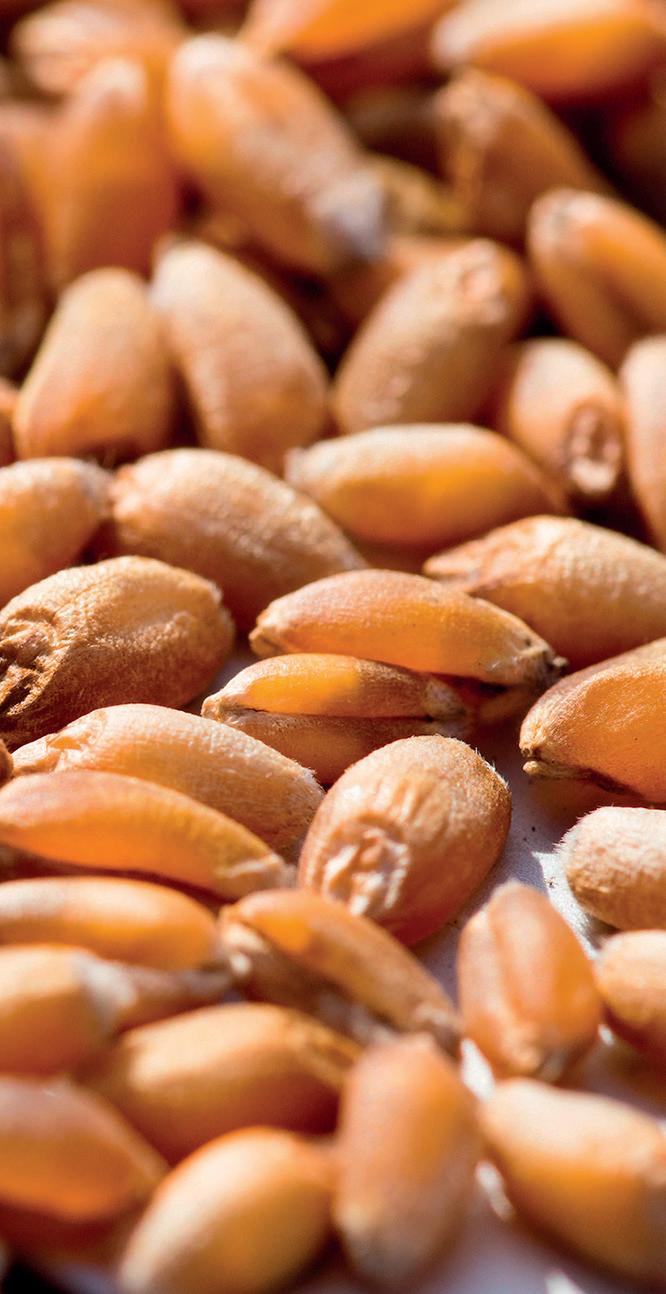
Sampling scope
JThe scale of the project and the amount of data generated are impressive, according to Ms MacDonald.
After seven years of the project, and by the end of the 2022 sampling period, 2,408 samples (archived for five years) were received, weighing 6,728kg in total.
“The total number of tests carried out for specified analytes was 8,100, producing 116,081 individual analytical results. Because multiresidue methods are used for pesticides, there were a further 816,000 pesticide residues screened for. There were 22,576 results for fusarium mycotoxins, 14,376 for ergot alkaloids and 2,105 for other mycotoxins.”
lenol (DON) levels were the lowest of the project’s lifetime.
“T-2 and HT-2 toxins were similar or lower than average, while ergot alkaloid levels were mixed — higher for some crops and lower for others.
“Stored samples for the 2022-23 period have started arriving at the laboratory, so the second phase of this year’s sampling is in progress.”
Fera collates the results into the standard form needed and sends the data to the European Food Standards Authority ensuring that UK results are included in the EFSA data set.
AHDB project 21130040
rMonitoring of contaminants in UK cereals used for processing food and animal feed
rAugust 2016-July 2023 (incl. two one-year extensions)
rFunding: AHDB £999,187 (partners participate in kind by organising and supplying samples)
rIndustry partners: Agricultural Industries Confederation (AIC); British Oat and Barley Millers’ Association (BOBMA); Maltsters’ Association of Great Britain (MAGB); and UK Flour Millers (UKFM) - formerly National Association of British and Irish Millers (nabim)
47 RESEARCH IN ACTION APRIL 2023
Monitoring provides an insight into seasonal levels of naturally occurring grain contaminants.
Root crop growers could benefit from the latest technology for harvest and post-harvest operations, reports Jane Carley.
New vision for root crops W
ith potato prices taking a hit, getting more value out of the crop has never been more important, and the latest developments from root crop machinery specialists are targeting this.
Streamlining root crop harvesting operations to cope with labour shortages and make best use of resources — both soils and fuel — has been targeted by Grimme UK in a joint project with Haith, and by Tong Engineering.
Optical sorting is becoming established as a way to improve efficiencies in the packhouse, using cameras to grade produce more quickly and accurately than the human eye, and make best use of a dwindling labour force.
Grimme and Haith entered into a strategic working agreement in 2020 to deliver complete solutions for both vegetable handling equipment and in-field root crop and vegetable machinery, as product manager Ed Hodson explains.
“Haith has established a reputation as a specialist in the manufacture of bespoke and tailored grading lines for the packhouse sector.
“Our expertise is with the growers and this collaboration has given us the opportunity to offer Haith’s technology for on-farm handling, and fill gaps in our range,” he says.
This includes taking the technology into the field with an innovative mobile optical sorter.

At the heart of the PRO Sort is a Tomra 3A optical sorter which is capable of handling up to 100 tonnes per hour.
By working in partnership on the development of the PRO Sort, Haith and Grimme have ensured that the new unit can be used in conjunction with the Grimme RH receiving hopper, for transfer of potatoes into store, and the CleanLoader.
Accept or reject
Based on the RH, the CleanLoader takes potatoes unloaded from field trailers and transfers them via a spiral roller section, which removes soil and stones, and an inspection belt — where the PRO sort is located — to the unloading elevator. A trash elevator can be specified to carry debris away to unload into a trailer.
Mr Hodson says: “The PRO Sort unit makes an ‘accept or reject’ decision based on imaging a ‘potato or not potato’ to remove debris, and can also
detect green potatoes. The CleanLoader is fully road towable, and with a 2.4m wide floor in the receiving hopper, can easily unload trailers.
“All moving elements are 2.4m wide until the sorted crop goes onto the 1.2m wide elevator, minimising the risk of damage.”
As a modular unit, the PRO Sort can also be set up in the yard to remove stones and clods or at the grading line to load directly into a box filler and can be used for carrots and onions as well as potatoes.

He adds that trials have seen the requirement for six to eight people on the grading line reduced to two.
Other benefits include cutting wastage; case studies on the
CleanLoader reveal that 2,000 tonnes of soil and debris — the equivalent of 73 trucks — were removed during a season of its use.
As well as helping to keep soil in the field, this saves fuel and time in transport.
48 MACHINERY POTATOES APRIL 2023 52 On test: Horsch Focus 3TD strip-till drill 55 Robots take to French fields at FIRA 60 Grain maize finds favour as a spring break 62 Established manufacturers cultivate new ground Also in this section
The PRO Sort unit makes an ‘accept or reject’ decision based on imaging a ‘potato or not potato’ to remove stones and clods and can also detect green potatoes.
More on potatoes over the page.






49 POTATOES MACHINERY APRIL 2023 From combines to culitivators and everything in between, you’re sure to find what you need on FGBuyandSell.com. Start listing your items FREE today! Browse. Sell. Buy at FGBuyandSell.com
Grimme has joined forces with Haith to integrate optical sorting into its crop handling equipment, with the PRO Sort module compatible with a range of equipment including the CleanLoader, shown here at a recent evaluation event.
Tong extends optical sorting

JTong Engineering has added optical sorting capability to its FieldLoad PRO field loader machine, allowing growers to streamline their post-harvest operations while reducing labour requirements.
The FieldLoad PRO has proved popular with growers wishing to load lorries at the side of the field to go straight to the customer, rather than hauling back to the farm for cleaning and sorting.

Charlie Rich, sales director at
Tong Engineering, says: “With rising costs and an increasing need for growers to streamline their post-harvest operations to get tractors and trailers off the roads, carting less soil and generally minimising crop mileage and associated expenses, the demand for our FieldLoad PRO machine has continued to increase.”
The Fieldload PRO was updated in 2020 to make it easier to transport.
While not offering the grading
function of the company’s Caretaker fixed sorting machine, it can size out small crop to meet the requirements of the major processors.
FieldLoad PRO is suitable for use on a wide range of root crops including potatoes, carrots, and onions.
Crop is loaded into a high capacity reception hopper feeding a choice of crop cleaning units including Tong’s EasyClean separator, the company’s PU coil
cleaning system and star cleaning units before passing over an inspection unit.
“Labour has become such an issue that we decided to automate the inspection element of the operation and replace it with an optical sensor from our existing supplier Tomra,” says Mr Rich.
“We remove the sorting cabin and fit the Tomra 3A, which is proven on dirty crop and can remove debris.
“Like all of our developments it is customer-focused and we’ve worked closely with growers who have had success with optical sorting on the Caretaker.”
The FieldLoad PRO allows the operation to be overseen by a single operator who also controls loading, rather than requiring two
50 MACHINERY POTATOES APRIL 2023
FieldLoad PRO can now be fitted with a Tomra 3A optical sorter as an integrated system, already proven in the company’s Caretaker store graders.
The Tong FieldLoad PRO has proved popular for growers wishing to load lorries straight from the field without having to haul crop to the store for sorting.
We decided to automate the inspection element of the operation
CHARLIE RICH
scope

Crop insights from harvest
JUpdates to the HarvestEye root crop insight tool are said to have led to faster processing and improved performance in challenging conditions.
First developed at the fresh produce tech hub, B-hive innovations, the tool is now available as a commercial product, engineered, installed and serviced from an independent base in Lincoln.
Fitting to harvesting and grading equipment of all brands, HarvestEye is designed to count and size crop at the point of harvest using a 3D camera and machine learning algorithms. It recognises potatoes amongst any debris and differentiates them from the picker’s hands on a picking-off table.

or three people for loading and picking off.
Once the crop is cleaned, it is transferred via a folding cart elevator into bulker trailers, store or box filling equipment.
An onboard generator is used for in-field operation and can be bypassed for mains power when on-farm.

Event
“It’s one complete, transportable solution, so the customer is investing in a single machine,” says Mr Rich.
“We held our Optical Sorting LIVE event in 2022 which gave customers the opportunity to run their own crop through the sorter.
“The results have been very impressive both in terms of the amount of labour that can be saved at this stage of the post-harvest handling process, as well as the potential reduction in storage costs as only good crop is being stored.
“We were also able to consider ongoing developments to suit customers’ individual requirements such as modifications to feed with boxes.”
Sales account manager Ed Strawson says: “The field is divided into 5x5m squares so the software can offer relative yield performance data on size and count and also map the variability of root crops.

Efficient
“This enables the grower to make better agronomic decisions and define issues with soil type or other limiting factors, as well as studying variability in the field.
“It’s much more efficient than manual sampling and covers the whole field rather than a limited number of sampling points.”
Seed producers can also analyse the result of trials such as seed spacing and which varieties perform better in which soil types.
The general size profile of the harvested crop can allow the produce from a particular field to be put into different parts of the store to work to a customer size specification.
On the harvester, the HarvestEye camera is placed wherever the best visibility can be afforded, normally either on
the picking-off table or elevator.
A processing unit is mounted on the machine frame and a tablet in the tractor or harvester cab displays the data which is relayed via the Cloud to a web-based portal.
Software developments have increased processing power, so that rather than visualising the potato in a ‘square box’ as the original version did, it can now work at pixel level to measure its shape and size, comparing it to machine learning models to differentiate it from a stone or clod, and recording its statistics.
The processor can work at the standard speed of the harvest, even in poorer light conditions, although a light over the picking off table is useful at night.
HarvestEye is currently compatible for use with potatoes and onions, and further developments will include
machine learning to recognise other crops. There are some 70 units in use worldwide, mainly in the UK, with increased exports on the agenda.
It costs £10,950 for the hardware, with a new lease option. There are a range of subscriptions, from £1,500/year which gives a daily PDF report of the data, up to £5,000/year for grower groups wanting to add further data.
Plans also include integration into third party software.
“Growers have found HarvestEye useful to offer them a wide range of information,” says Mr Strawson.“For example, it is possible to compare different varieties and how their performance is affected from field to field. It can deliver the hard data rather than having to rely on gut feelings about the crop, and therefore increase overall performance.”
51 POTATOES MACHINERY APRIL 2023
HarvestEye is designed to count and size crop at the point of harvest using a 3D camera and machine learning algorithms.
The software can offer relative yield performance data on size and count and also map the variability of root crops.
MACHINERY DRILLS
The German-built Focus TD could be a strong competitor in the strip-till drill sector, says Arable Farming machinery editor Toby Whatley, who put a three-metre model through its paces.
On test: Horsch Focus 3TD
Strip tillage can offer a single pass crop establishment process which provides numerous benefits, including fuel and time savings, reduced capital expense and increased agility to work around unpredictable weather. It can, in addition, generate improvements in soil health.
Horsch’s Focus TD strip tillage drill, available in working widths of three, four and six metres, is a relative newcomer to this market.
The range is the lesser known of the manufacturer’s product portfolio, with the Sprinter tine and Avatar no-till disc drills taking the limelight.
Our test machine was a 3m unit and was chosen as the most recent addition to the range,
being introduced in early 2021. Its size and power requirement of 180-250hp suits medium-sized farms looking to change their crop establishment system, or larger units looking for establishment flexibility
For many farmers, the move to a strip-tillage system is a replacement for a more intensive plough or cultivation regime, which includes multiple seedbed preparation passes before drilling.
To understand how well the Horsch system worked, we tested the machine with a contract farming business which already runs a strip tillage machine alongside a plough and power-harrow combination.

Key areas of interest were: ease of use, establishment consistency and seedbed finish for pre-emergence applications.
Horsch Focus 3TD specification
rWorking width: Three metres
rLength: 9m
rHopper capacity: 3,500 litres
rTyre size: 210/95-24
rOpening tines: Two rows of five at 300mm
rCoulters: 20 x 380mm double-disc at 150mm
rFrame clearance: 750mm
rWorking speed: 6-12kph
rPower requirement: 180-250hp
rWeight: From 5,800kg
rHydraulic requirement: 2 x DA 1 x FF return
rPrice (as tested): £88,582 (September 2022)
Cultivation and levelling
JThe Focus uses two rows of opening legs spaced at 600mm centres, with 10 on the complete machine, giving an overall leg spacing of 300mm.
Overload protection and breakaway is offered by compressive springs behind each unit.
A claimed breakaway force of 630kg is offered to a maximum height of 260mm. During our test, we had no issue with the design or resistance of the legs, despite not being adjustable. Other manufacturers use a hydraulic breakaway allowing variable load, which in some conditions would be preferable.
Horsch offers a range of points for the legs, with some offering reversible wearing metal.
Our test machine was fitted with ultra-low disturbance points, which are claimed to work at depth without bringing
large clods to the surface. During the test, field conditions were ideal, with some ground previously subsoiled and the legs performed well.
To fully understand the low disturbance claims, operating the machine in heavier, spring drilling would be a more suitable test.
Depth control
Depth control and adjustment of the legs are achieved using aluminium spacers on the main lifting cylinders. Access to these within the middle of the chassis was not very easy, however colour-co-ordinated spacers and a guide demonstrating the depth based on the different spacer combinations fitted was a helpful addition.
Fertiliser distribution is supplied to each leg, with an option unique to Horsch which
52
APRIL 2023
TWO-PART FEATURE Don’t miss part two in AF May, which includes machine control and seed metering, plus test verdict.
allows the quantity of fertiliser to be varied between the full rate delivered at depth; 50/50 surface and leg applied, and full rate placed on the surface, by adjusting a folding plate on the heel of each leg.
In general, the option to surface apply fertiliser before drilling does not carry huge value for UK growers. However, the ability to apply a companion crop or micronutrients ahead of the consolidation wheels may offer application flexibility.
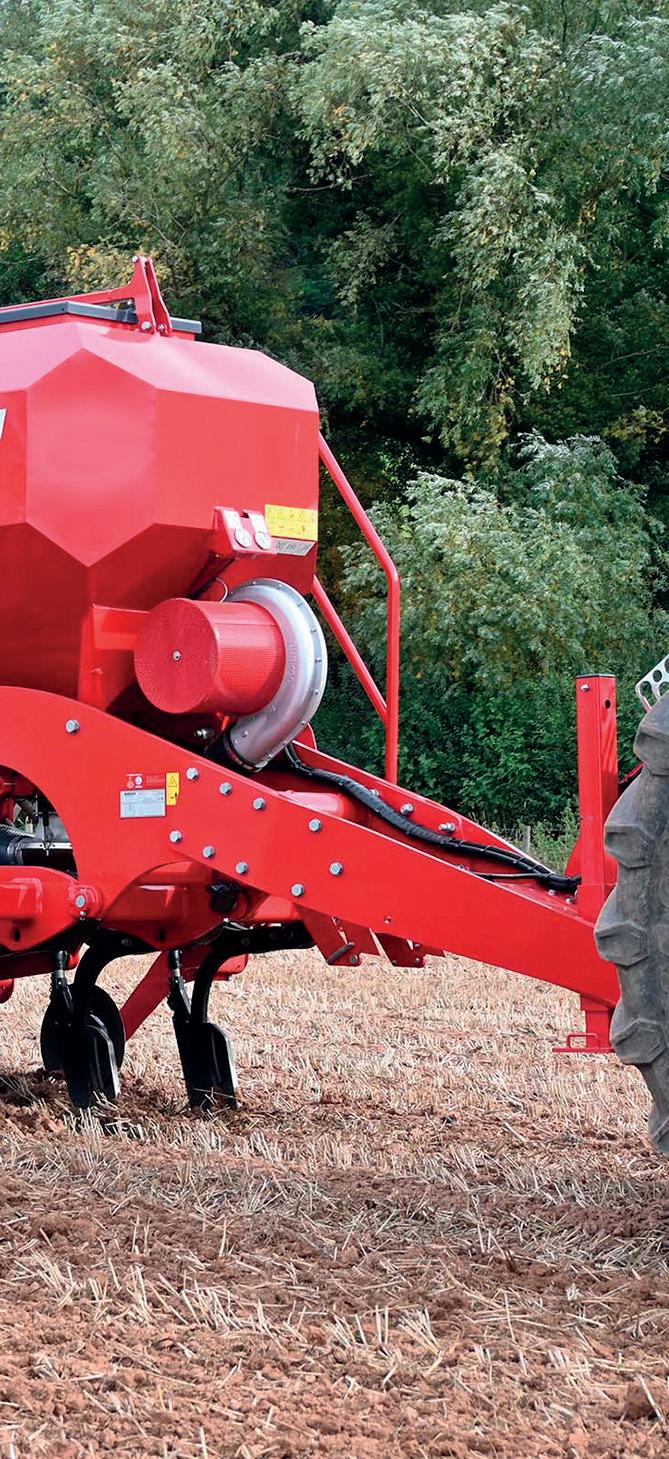
For growers with varied soil
types and conditions, the entire leg deck can be removed and replaced with two gangs of hydraulically adjustable 460mm-diameter discs. Although an added cost, the option could allow increased drilling flexibility without the investment in an additional drill.
Following the legs, a single rows of manually adjusted basket crumbling wheels provided surface levelling and finer tilth generation. A popular option in the French market, this design is less well
known in the UK.
In practice, when working on barley stubbles, the design performed well and produced a level surface ahead of the consolidation wheels. But when working land following beans, haulm quickly wrapped around the baskets and started to warm the bearing.
Horsch advises that the baskets can be replaced with a single row of hydraulically adjusted levelling discs – an option we would definitely choose.

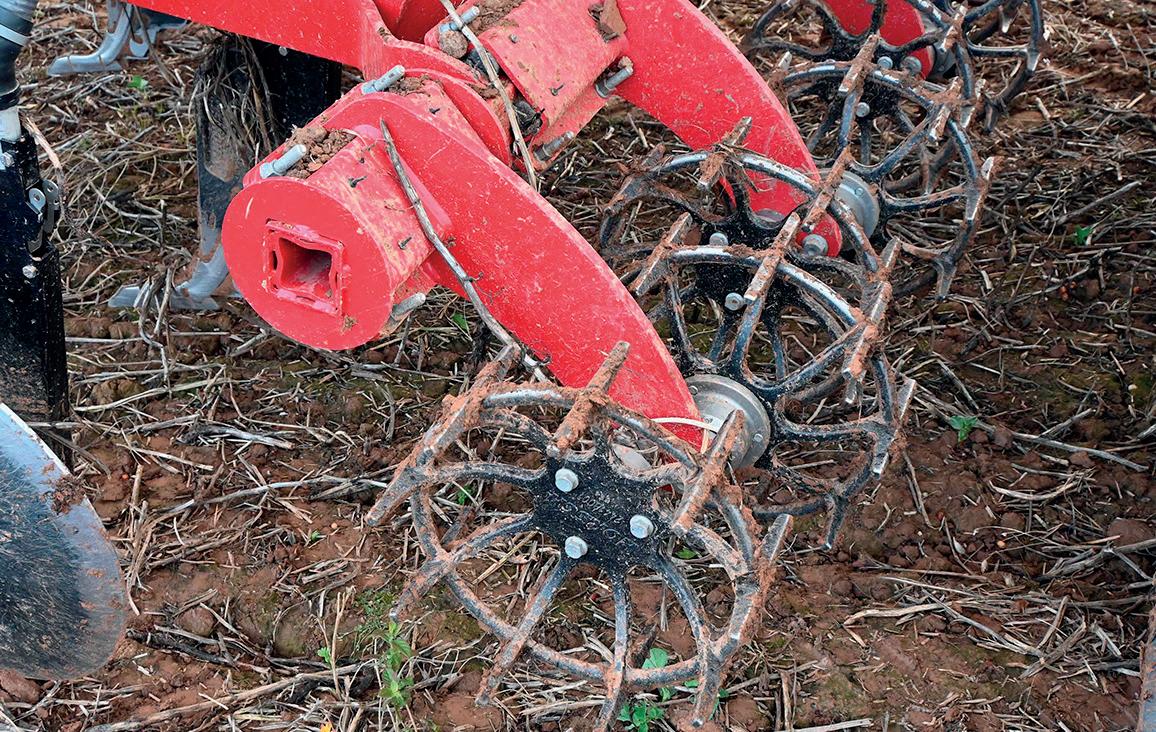
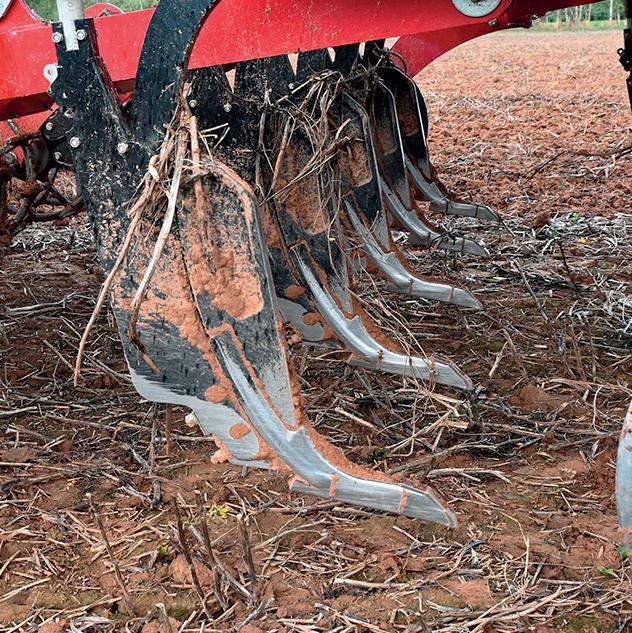

A single row of reconsolidation wheels, located in the centre of the machine, worked to produce a firm seedbed for the following coulters, consisting of 10 x BTK 210/95-24 pneumatic tyres without any staggering.
Individual scrapers are mounted between the two axles,
each carrying five wheels. In the event of a puncture, Horsch says the axles can be unfastened and rolled out of the chassis.
Once separated, individual tyres can be unbolted and removed from the shaft.

Compared to some drills which use a pneumatic tyre consolidation gang, this puncture fix solution is workable, although not easily completed quickly or away from the workshop.
The manufacturer advises that foam-filling the tyres prevents punctures. However, this would also remove any deflection offered by the tyre and significantly increases the machine weight.
In transport, the whole machine is carried on the 10 wheels, with pneumatic brakes available as an option.

53 APRIL 2023
The Focus 3TD uses two rows of opening legs spaced at 300mm. Inset: Our test machine was supplied with low-disturbance ULD+ points.
Moving a flap on the heel of each leg changed the fertiliser distribution.
Depth control was achieved using cylinder spacers. A visual guide helped identify the correct combination.
over the page.
Basket crumbling wheels fitted following the legs quickly blocked in high trash conditions.
Continues
MACHINERY DRILLS
Seed coulters
JThe coulter assembly, which is positioned on a secondary toolbar, uses a similar design of coloured spacers to control depth, although access to these was much easier and used a twin-rod, double-acting cylinder at either side of the coulter deck.
Assembled at 150mm centres, the 20 TurboDisc coulters employ a vertical double 340mm opening disc followed by a rubber reconsolidation wheel.
Seed is delivered to the front of the coulter and placed underneath a plastic trailing press-boot, which is claimed to offer consistent seed-to-soil contact.
At the rear of the machine, pairs of straight levelling harrows are used to pull the row edges together to create a level finish.
In use, the coulters performed well, producing a consistent seed depth and good surface finish.

Compared to other designs of mounted or trailed striptillage machines, the Focus produces a consistently level seedbed, visually similar to that produced by a powerharrow combination – an
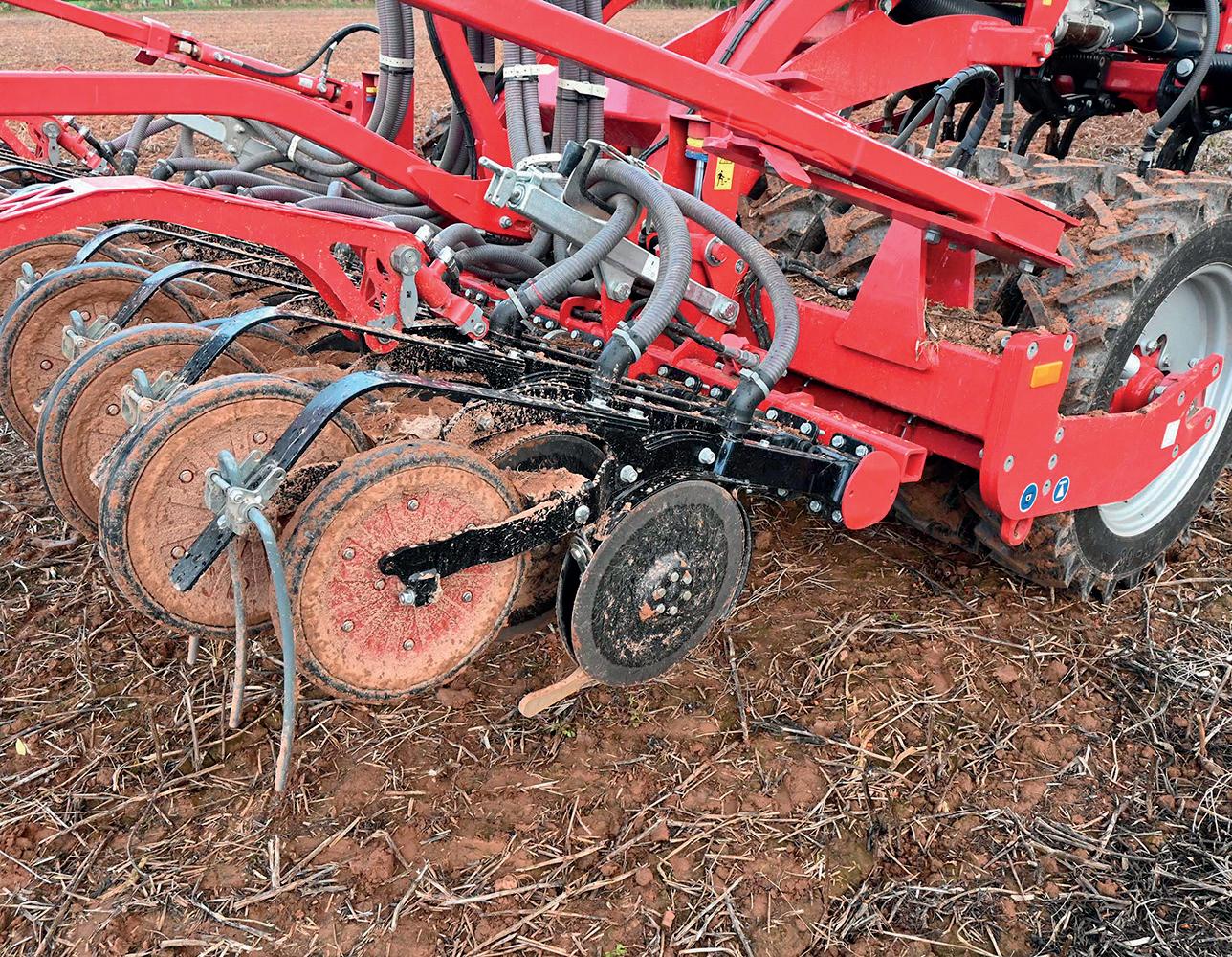
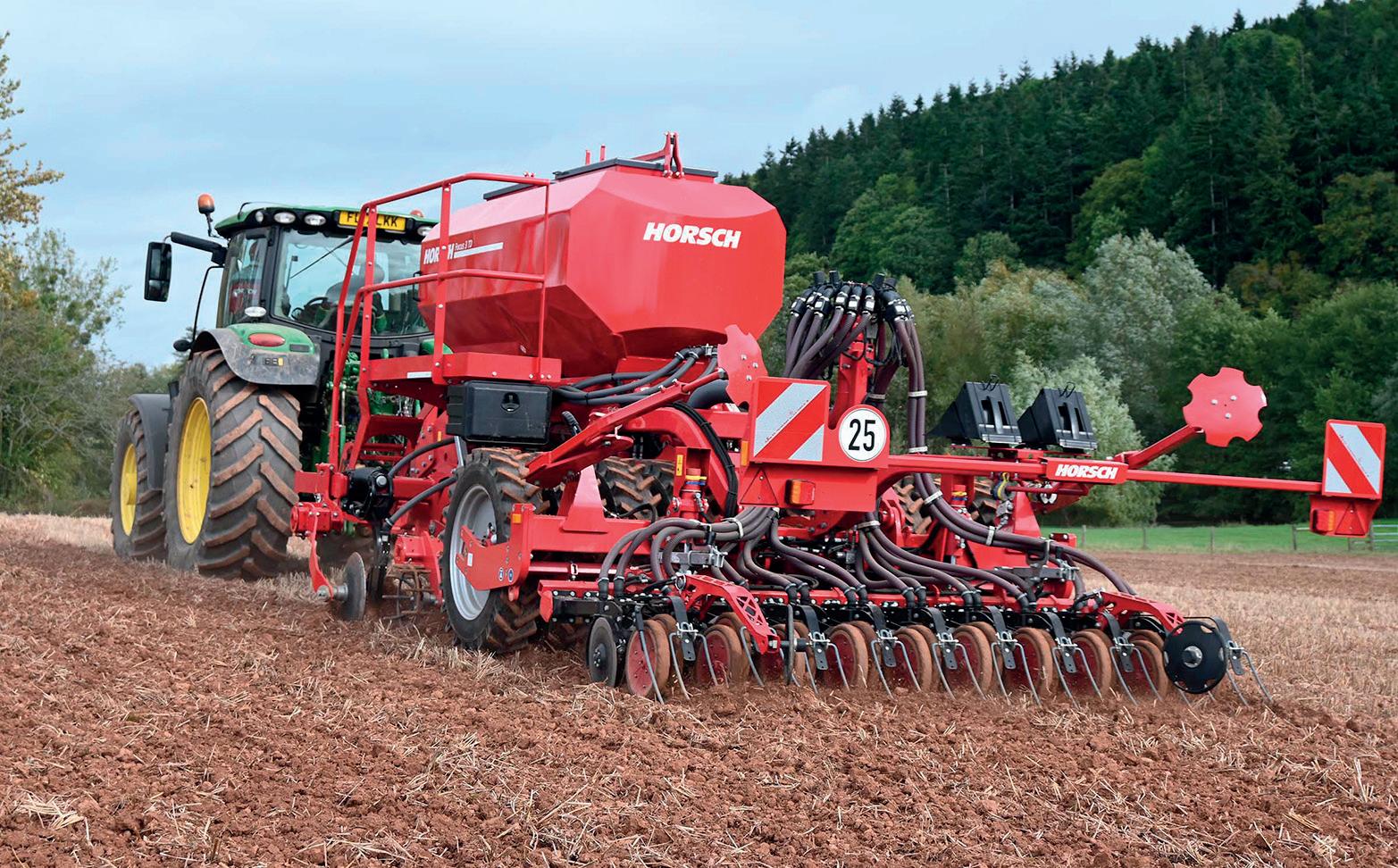
Twenty disc coulters were fitted at 150 mm. The compete coulter bar can be replaced for different spacing or coulter designs.
area of importance for preemergence applications.
An area where the disc coulter struggled, and a tine would deliver better results, was during work on heavier, wetter ground.
The trailing nature of the disc compared to an engaging leg caused the unit to rise up, resulting in poor seed placement.
Coulter pressure could be adjusted from a claimed 5-120kg per unit, using a pair

of manual rotary adjusters at the rear of the unit.
The marked scale of the extending section is simple to read and the increase of coulter pressure is shown on a pressure gauge at the front of the machine.
Wider spacing
Unique to the Focus and aligning with the flexibility offered with the opening leg and disc combination, the entire coulter bar is designed
to be released and replaced with a secondary assembly for wider spacing.
This can be either a wider spaced version of the TurboDisc design or the manufacturer’s TurboEdge tine coulter, spaced up to 286mm and 500mm for oilseed rape establishment. Again, this option adds additional cost to an already costly machine, but it does allow further flexibility in crop establishment without the need for a completely different drill.

54
APRIL 2023
TWO-PART FEATURE Don’t miss part two in AF May, which includes machine control and seed metering, plus test verdict.
Coulter pressure is adjusted manually up to a claimed 120kg.
Coulter depth was easily adjusted.
The first large-scale demonstration dedicated to agricultural robotics took place in Toulouse, France recently. Jane Carley reports on discussions and developments.

Robots take to the fields at FIRA
In its seventh year, the World FIRA agricultural robotics exhibition headed outside.
More than 2,000 visitors were able to inspect the 30 robots presented, 20 of which were demonstrated in-field, while there were also numerous systems and components for would-be developers to peruse.
The forum for discussion remains an important element of the event, with a scientific programme featuring industry figures and leading researchers looking at developments as the technology transitions from drawing board to farmer’s field.
One particularly topical roundtable discussion looked at the prospects for robotising regenerative agriculture. Chaired by Pierre Compere, of agricultural development consortium Agri Sud Ouest Innovation, it brought together James Taylor, of French research organisation INRAE, Sebastian Roumegous, of agroecological consultant Biospheres, and robot entrepreneur Gaetan Severac, founder of Naio Technologies.
Mr Roumegous began by highlighting the complex nature of regenerative agriculture and questioned whether robots could cope with this complexity or whether a different robot would be needed for each crop.
He added that practices such as the establishment of cover crops might cause some technical issues for robot adoption. Growing sorghum with triticale can produce 8cm of mulch, for example.
“When planning cover, growers will need to consider whether the mulch will make mechanical weeding more difficult. We also need to think about how robots will manage regimes such as bi-cropping,” he said.
Challenging conditions

James Taylor countered that there was little difference between manually operated and robotic equipment in the ability to handle challenging conditions.
“As long as targets can be identified properly, the action can be carried out. An additional benefit is the easy collection of data which is key for regenerative agriculture. Robots can also offer 24/7 management of the crop.”
Mr Severac suggested that a robot can replicate what a human does but at a lower cost, while enabling better deployment of staff at busy times and compensat-
ing for gaps in the labour market.
“Added value for regenerative agriculture will come from which tools can be onboarded to a robot such as direct seeding and laser weeding. We will be able to offer more solutions while offering the opportunity to collect big data. The starting point is ‘how can we add value?’,” he said.
Mr Taylor pointed to the potential use of sensors to assess biodiversity, although the technology is currently aimed at crop threats.
“There has been a lot of work done on weed management to determine which weeds we want to kill, but we now need to be able to study plants that are advantageous, for example in encouraging beneficials.”
He added that affordability is an issue, but that adaptable,
flexible robots can work.
“We need to consider farmers’ perception of robots and how they will engage with them – especially in the organic sector which can be sceptical of technology. The poor adoption of precision farming in the first 20 years of its development was due to a failure to address market needs.”
According to Mr Severac, upcoming CE certification for robots to be used autonomously without supervision will overcome one important barrier.
“We know we can offer technological solutions for farmers, we now need to get to work.”
The way forward is to show examples of machines working not on research farms, but on commercial farms, said Mr Taylor. Continues over the page.
55 ROBOTICS MACHINERY APRIL 2023
The World FIRA agricultural robotics exhibition is now in its seventh year.
MACHINERY ROBOTICS
Demonstrations and technology
Naio Technologies
JEstablished in 2011, Naio Technologies has 350 robots farming 60,000ha globally. Based in Toulouse, the company opened a subsidiary in Salinas, California in 2019 to focus on the US market and last year raised €32 million (£28m) investment for further developments.
All Naio robots are fully autonomous using RTK for 2cm accuracy and electrically powered, with software and hardware developed in-house. Implements are sourced from specialist manufacturers such as Kult.
Exxact Robotics
JPart of the Exel group, a market leader in sprayers, Exxact Robotics was established in 2019 to focus on autonomous solutions. However, it also feeds back technology to its sister companies and this is one goal of developing a hydrogen-
Following on from products aimed at the vineyard and fresh product markets, in 2022 Naio introduced Orio, targeting field scale vegetables and sugar beet and designed for cultivations, seeding and collecting data. Adjustable track width from 1.5-2.2m allows configuration for a variety of crops.


Camera system
Using an electrically driven weeder from Kult, the RTK guidance can be supplemented with a Tillett and Hague camera system for
increased accuracy in the row. UK importer Burdens Group is to demo Orio this spring, and Naio is looking to work
with manufacturer Stanhay to develop specialist seeding equipment for crops including sugar beet.
Pixel Farming Robotics
fuelled version of its Traxx straddle robot, said general manager Colin Cheballier.
With 35kW batteries powered by a fuel cell from two 9kg hydrogen tanks, the robot can work for 12 hours before refuelling; it is designed to be more lightweight than batterypowered alternatives.
Traxx Concept H2’s 56hp diesel powered predecessor completed a season in the vineyards of Bordeaux and Champagne in 2022, working with cultivators, but can also be fitted with a tunnel sprayer.
Digital Workbench
JThe autonomous Tipard 350 has been developed with plant breeding, agrochemical and specialised applications in mind. Built around a selflevelling chassis, it can operate in four-wheel and crab steer with 360-degree turning wheels, and
JKeeping batteries charged up on electrically-powered robots is a major talking point. With working widths of up to 3.3m and outputs of 1ha/hour, Pixel Farming Robotics’ Robot One is positioned as a challenger to tractor-drawn, non-chemical weeding using camera vision to work on a per plant basis.

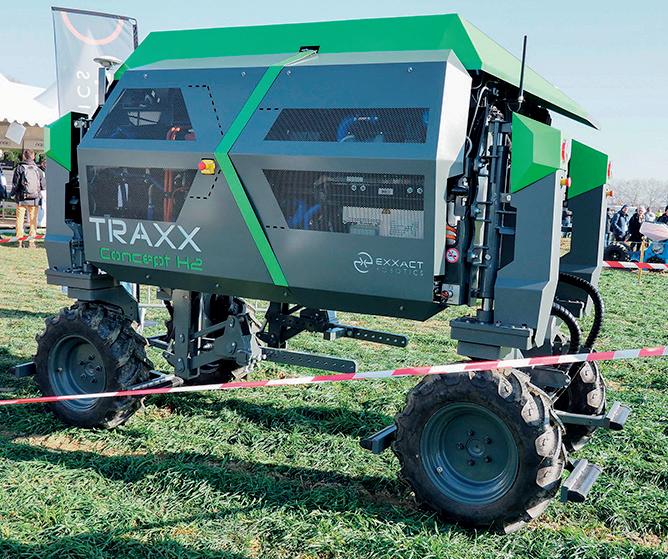
Large solar panels on its roof top up the batteries for six to eight hours run time in sunny weather and its design is intended to conserve power – it consumes just 800w when travelling. Each weeding head uses 3kW and by fitting
Scouting and research
weighs in at just 350kg, with an optional load of 150kg.
It can be fitted with a rear linkage, but early uses have included collection of soil samples, while ground clearance up to 80cm allows work in growing crops. Open source
software and hardware makes for easy integration of the customer’s IT infrastructure or apps. Battery-powered, it uses 3D camera-controlled steering and RTK navigation.
rotary blades, weeding can be effective without high forward speeds, suggests the company’s Arend Koekkoek.
Other tools include seeding modules and a laser weeder, and with five units working in the Netherlands, crops include sugar beet, cabbage, onions and flower bulbs.
56
APRIL 2023
Continues over the page.
15-16 NOV 2023

THE PREMIER UK EVENT FOR FARMERS + LANDOWNERS TO DIVERSIFY AND INNOVATE THEIR BUSINESS









11,539 attendees
74 % of attendees have the purchasing authority or influence



of exhibitors rated the overall quality of leads good/excellent
70 % of exhibitors would highly recommend the show to others


62 %


EVENT RUNNING ALONGSIDE THE FOLLOWING SHOWS:
#FBI23
DO NOT MISS OUT AND BOOK YOUR STAND TODAY farmbusinessshow.co.uk

NEC BIRMINGHAM
marketingre@agriconnect.com
MACHINERY ROBOTICS
Meropy
JThe SentIV scouting robot is being trialled by co-operatives, evaluating the prototype’s twin RGB cameras – one above the crop on the body and a second on the ‘tail’ below the crop – for data collection capability.

The spoked wheels and 15kg weight prevent crop and soil damage as it travels in a random path within boundaries set on an app and can be easily removed to allow transport in the boot of a car.

Designed to work in all weather conditions without the need for an operator’s licence, run time is six to 10 hours. Meropy offers SentIV on an annual rental contract including analysis, mapping and maintenance.
INRAE
Scouting and research
JThe French National Institute for Agricultural Research (INRAE), which has a base at the event’s Agribiopole site, presented several examples of its research.
The Phenomobile has a 12m telescopic arm fitted with four synchronised RGB cameras and three LIDAR scanning lasers, designed for operations including phenotyping, counting seedlings or emerging plants, and identifying disease. It can

Reflet du Monde
JThe drone has become an established tool for scouting and moves are being made towards application systems although restrictions on aerial spraying are still a barrier. Based near Bordeaux, Reflet du Monde offers drone services, leasing and training, and has developed the Agrodrone, designed as a multi-use carrier.

Applications explored so far
Softivert
JThe SoftiRover from Softivert has been designed as a selfdriving electric tractor, simple in operation and using LIDAR for obstacle avoidance and GPS for navigation. It can be used with existing implements adapted for electric drive by the company, such as the Monosem precision seeder demonstrated. Setting of seed spacing, rate
measure 150-200 microparcels per hour, producing 200mb of data each.
Aimed at research organisations such as INRAE
and plant breeders, Phenomobile is being used on sunflowers to improve data analysis strategies before moving onto a wheat trial that will involve 1,000 plots.
include spreading cover crop seedlings and application of pheromone rings to fruit trees or of biocontrol products. The
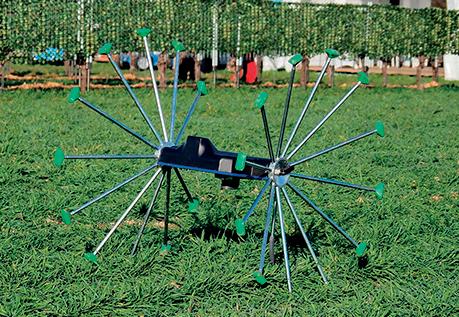
Challenging the tractor
and planting depth is controlled via an app and the SoftiRover is autonomous once up and running. It is due to be trialled on the developer’s farm in Pau, south west France for soy and maize before a limited release in 2024. Productivity is said to be 0.7ha/hr and the company has set a price of around €100,000 (£88,000).
SITIA
JSITIA’s Trektor platform is aimed at multiple markets and is designed for autonomous use. Three models with variable clearance/height and track width mean that it can be adapted from vineyard to open field applications; implements are attached between the wheels or via a three-point linkage and can be hydraulically or electrically driven.
Hybrid drive uses a 60hp diesel generator to charge its batteries, said to give up to 24 hours run time, and
quadcopter has a payload of 15kg and can accommodate 10kg of seeds, 15 litres of liquids or 2,000 capsules.
with working speed up to 9kph, outputs of 1ha/hr are possible. Some 35 units have been sold, and Trektor is distributed in France by dealer network Promodis.
58
APRIL 2023
Components and systems
Tracto-Lock
JFrench manufacturer
Tracto-Lock has developed a coupling system designed to allow mounted implements to be attached from the safety of the cab.

A ‘male’ interface is fitted to the three point linkage of the tractor along with a transmission block and the ‘female’ interface on the chosen implement. Using a remote control in the cab the operator connects the implement, hydraulic connections (three valves) and pto.
The current model is suitable for tractors up to 250hp, but there are plans to develop versions for larger machines and a simpler device for lighter tractors, as well as for autonomous machines, allowing them to hitch attachments without operator intervention.
BBLeap
JWorking at plant level is one of the objectives for robot developers. LeapBox from Dutch manufacturer BBLeap regulates spray application rate based on a fixed pressure to maintain the optimal droplet size. The rate is compensated for turns and movement of the boom relative to the machine.
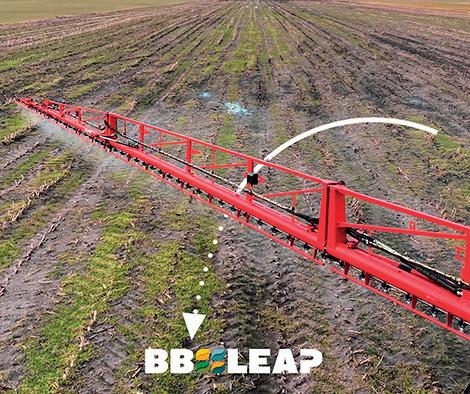
The electronically-controlled PWM system is capable of working at 100Hz which minimises the interval between which the valve is completely open and
Teyme
JSpanish sprayer specialist Teyme is working with an international consortium to develop crop protection robots. The WETA robot is a modular design for steep slope vineyards, which incorporates a high level of spraying tech – air assist, variable rate using PWM nozzles for independent nozzle to a prescription map, or in development, based on data collected by LIDAR.
Ag Robot of the Year award
JFIRA saw the presentation of the Ag Robot of the Year award, judged by a panel from online publication Future Farming Technology. Entrants are required to be commercially available for 2023 and to provide an indication of purchase/rental price.
The five finalists included weeding and harvesting machines, but the winner was more niche – the InsightTRAC Rover, an autonomous

SICK
completely closed. This allows the system to maintain a wide application rate range, even at high spraying speeds.
As the system is modular, it can be applied to many different nozzle sizes and boom folding positions, and could easily be deployed on an autonomous sprayer, says the company.

JSafety is arguably the most significant barrier to the adoption of autonomous machines and with legislation varying around the world, is likely to remain a priority for developers. SICK specialises in sensors for guidance, navigation and anti-collision applications, and presented some of its solutions at FIRA.
For driving assistance and anti-collision, the Visionary-B 3D sensor provides 2D images and 3D data. It works as a driver assistance system with a display and live image, plus acoustic and optical warning signals for collision avoidance.
treatment solution for ‘mummy’ nuts in almond trees.
The California-based company’s design uses image recognition to target nuts remaining on the trees after harvest susceptible to infection by pests such as orange navelworm. Pneumatic airguns mounted on swivel turrets fire biodegradable pellets to knock them off the branches.
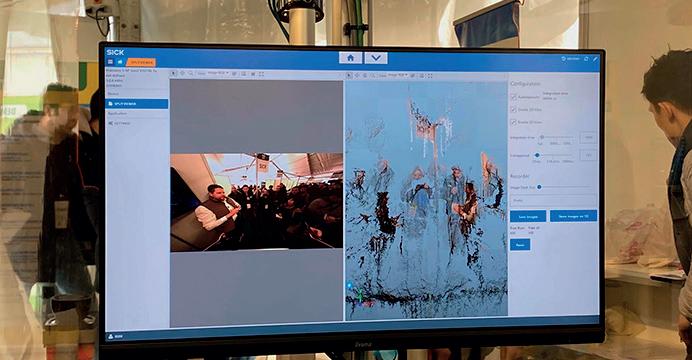
This is the alternative to
The spraying boom can also be swapped for eight section UV light treatment lamp apparatus. The electrically powered Scorpion robot is designed to negotiate obstacles such as rocks up to 15cm high, and operation is via a TIM (tractor implement
management) control system. Initial development was funded by the EU’s Horizon 2020 programme.
59 ROBOTICS MACHINERY APRIL 2023
mechanically shaking trees or manually removing the ‘mummies. Increased profits
from the healthier orchards are put at $100-$300/acre (£205£617/hectare).
Grain maize as a spring break has become a valuable addition to the arable rotation for one Midlands farm business, which sees potential in the crop to deliver a margin equal to milling wheat. Geoff Ashcroft reports.
Grain maize finds favour as a spring break
Leicestershire grower
Will Oliver’s route into growing grain maize was not planned and, by his own admission, was somewhat opportunist.
“We’d missed a spring cropping opportunity on some recently acquired land, so we decided to try 20 hectares of grain maize,” says Mr Oliver, who farms at Swepstone Fields Farm, Newton Burgoland.
“It yielded nine tonnes/ha and delivered a gross margin that was better than milling wheat, so we bit the bullet and we’ve since used the crop to replace 200ha of oilseed rape. We had been suffering with cabbage stem flea beetle and black-grass, so this crop is proving to
be an effective way of putting some distance between those problems across our soils.”
He says that six years ago, the farm would have been faced with spraying off around 30ha of black-grass infestation - today, the weed can be hand-rogued.
A.H. Oliver and Son farms around 800ha, of which, half is down to first wheats. Maize now accounts for 200ha, with winter beans comprising a further 160ha, leaving the remainder for margins, stewardship schemes and a small area of land rented out to a nearby potato grower.

Now heading into a fourth season growing and harvesting a significant area of grain maize, Mr
Oliver says the crop has brought numerous benefits to the arable rotation, though growing it is not without its challenges.
“There are plenty of contractors running maize drills, but very few with a grain maize header,” he says. “Almost all are set up for forage maize.”
Convinced of the merits of the crop, he says the answer was to invest in a header to use with the farm’s combine - a rubber-tracked New Holland CR9.90.
Investment

“An eight-row Capello header represented an investment of around £50,000, but it means our conventional 12.2m cereal header is now doing much less work each season.

“This shares the wear and could ultimately see us change the combine less frequently.”

With the area farmed extending over 20 miles from one end of the farm to the other, and land spread across blocks of between 40-80ha, logistics have to be carefully planned.
Fortunately, the eight-row grain maize header folds on top of itself for transport, simplifying combine movements between fields and outlying blocks of land.
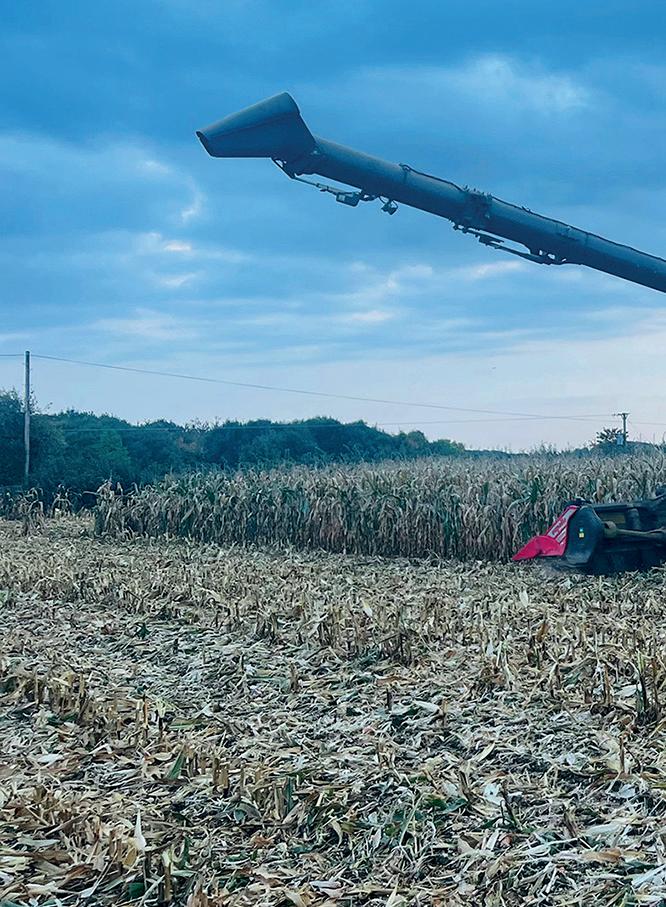
The other key consideration is drying the crop once it leaves the combine.
“Grain maize has a moisture content of around 30%, and it needs to be reduced to around 15% for storage and handling,” says Mr Oliver.
“But to get there requires fierce heat. The downside is that it costs around £40/t in diesel, although the store does then smell like popcorn.”
When it comes to harvesting, the farm cuts only enough crop that can be dried in a 24-hour period, ensuring it does not create any bottlenecks.
“Once the grain maize is ripe, and the cob sits on the plant wrapped in its protective coating, we can then structure our harvesting plans to suit weather conditions,” says Mr Oliver.
Wheat currently follows grain maize and the intention is to be drilling around the end of October
60 MACHINERY GRAIN MAIZE APRIL 2023
A Horsch Sprinter will be joined by a Horizon DSX for direct drilling wheat after maize.
An eight-row Capello header replaces a 12.2m
PICTURES: GEOFF ASHCROFT
Wheat after maize is currently cultivated to disperse trash and stubbles.
– a similar date to when the aim was to beat black-grass.
Mr Oliver says that grain maize has spread the farm’s workload, easing the early summer rush by eliminating oilseed rape.
“We can get most of our autumn work completed before we start combining the maize,” he says.
Drying and storage facilities at the farm are well placed to deal with grain maize.
“We have the capacity to dry 190t in a 24-hour period, which dictates our combine productivity.
“When it comes to in-field logistics, we don’t let tractors and trailers in the field. Instead, the combine runs to the gate to unload.
“It takes a while to fill the grain tank. So there is much less pressure on trailers compared to harvesting wheat.”
The Capello header is equipped

with rotary knives that sit beneath the header. These mulch the stalks and all the remaining crop residue, leaving a carpet of trash for the combine to move across.
“Stripping only the cobs from each plant reduces the workload on the combine,” Mr Oliver says.

“It is only clean grain wrapped in a few leaves, so the volume of material passing through the CR990 is minimal once the grain is stripped from the cob.”
Trash
It does, however, mean there is a lot of surface trash to deal with, and the farm has recently invested in a Horizon DSX to direct drill wheat this autumn, with the intention of cutting straight through this.
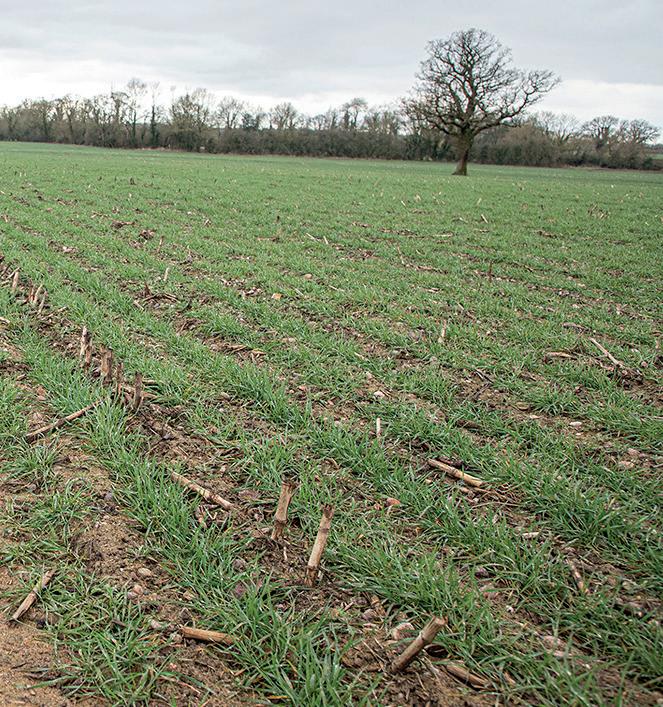
“Our soil after maize is very friable, which I can only put down to the value of a break crop which has different sprays and fertiliser requirements to the remainder of our rotation,” says Mr Oliver.
Cultivations have been min-till for many years, and the plough is used only when absolutely necessary.
“We’ve been making up to two passes through the maize trash with a 4m Vaderstad TopDown to incorporate residues. This lets us drill using a 12m Horsch Sprinter.
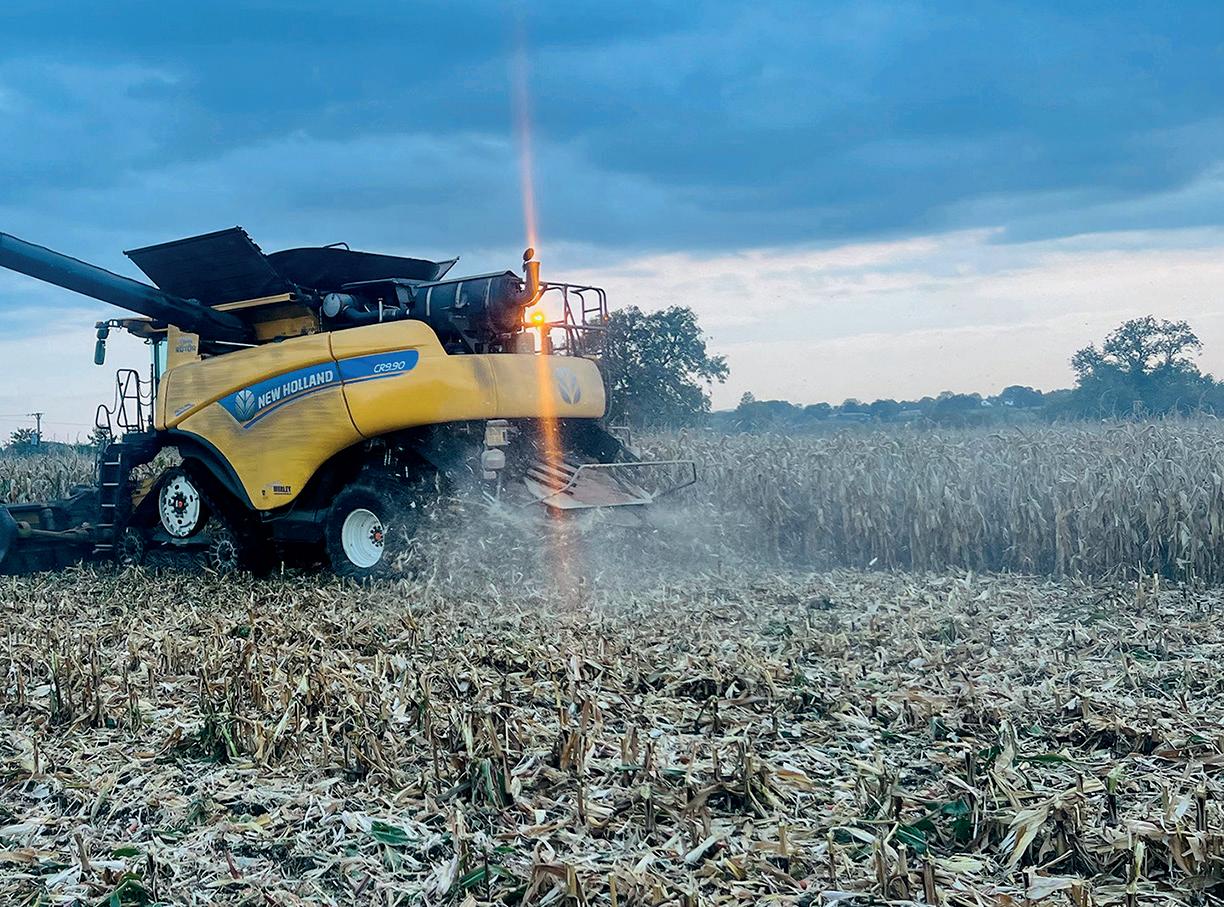
“But the focus will be to go straight in with the Horizon. And
with the addition of a front tank for starter fertiliser, we should be able to get the crop up and away.”
He adds that soil organic matter continues to rise, which should make drilling wheat after maize a relatively straightforward process with the new drill.
“We have noticed a small yield deficit with wheat after maize, so the starter fertiliser should help to claw that back.
“But importantly, our fuel burn will be slashed, as the Magnum Rowtrac 380 should burn just four litres/ha pulling a 6m Horizon.”
In 2019, the business added a 200,000-bird poultry unit, which generates a supply of muck that is applied to wheat, while digestate is incorporated into maize seedbeds. He says: “The cost of bagged fertiliser means we need to be more resourceful and efficient with inputs. Higher input prices
have simply driven us to look more carefully at the utilisation of all our resources.”
His winter beans are direct drilled using the 12m Sprinter, as is wheat after beans.
“With low disturbance points, we can move the minimum amount of soil and establish a good crop in the autumn,” he says.
“With maize being spring-sown, we’ve started to introduce a cover crop mix into all land earmarked for grain maize. This also provides a source of winter keep for local shepherds, and also contributes to soil biology.”
Digestate
Ahead of planting, he says the cover crop is sprayed off, covered in digestate, then hit with the TopDown, followed by a pass with an 8m Carrier before a local contractor drills the maize at 80,000 seeds/hectare.
“All the crop needs is a pre-emergence [herbicide], a post emergence [herbicide] and probably a fungicide. And by that time, our John Deere self-propelled sprayer is just about tall enough to get through for the last application.”
Last year’s dry conditions saw the grain maize yield 7.5t/ha when dried, without any bagged fertiliser being applied.
“It’s encouraging to know that our gross margin for a break crop can be as good as our first wheats,” concludes Mr Oliver.
Grain maize has been delivering a gross margin that’s as good as first wheats for grower Will Oliver.
61 GRAIN MAIZE MACHINERY APRIL 2023
There is much less pressure on trailers compared to harvesting wheat
WILL OLIVER
12.2m cereal header on the farm’s CR9.90.
Recent acquisitions see both Kverneland Group and Vaderstad follow a wider manufacturer trend into mechanical weed control solutions.
 James Huyton reports.
James Huyton reports.
Established manufacturers cultivate new ground
The concept of mechanical weed control is certainly not a new one, but with a continual reduction in chemical options on the market and, in some cases, reducing efficacy against certain
Vaderstad has purchased the interrow cultivator intellectual property rights from Thyregod.
weeds, mainstream manufacturers are now investing and developing products in this previously specialist field.
Sustainability
Coinciding with policy changes demanding more sustainable
farming systems, a race has begun to become the next manufacturer to supply interrow cultivation kit.

Kverneland Group and Vaderstad now join Horsch, Pottinger, Lemken and Amazone on the list of
mainstream cultivation manufacturers now supplying a range of interrow cultivation products.
Closer to home, Yorkshire-based

62 MACHINERY WEED CONTROL APRIL 2023
Sumo launched an in-house developed cultivator at LAMMA 2023.
Kverneland Group has acquired the complete business of French firm Phenix Agrosystem, which operates entirely as a cultivator manufacturer.
Meanwhile, Vaderstad has acquired part of Danish company Thyregod, including all intellectual property rights to its interrow cultivator product range.
Heritage
Thyregod has heritage and form in the sector, having developed and manufactured interrow cultivators over the last 25 years, together with independent row-guided systems.
Potentially a better-known business in the UK, Thyregod also manufactures trailed sugar beet harvesters, beet cleaner-loaders and stone pickers.
However, these products are not included in the Vaderstad deal and will continue to be manufactured under the brand’s existing name and colours.
Vaderstad sees the acquisition as an important addition to its business, claiming that adding an interrow cultivator to its product range also optimises its future Proceed seed drill concept - a silver medal winner in the LAMMA Innovation Awards 2023 - in cereals.
Vaderstad says that many of its customers are already using mechanical cultivation in crops such as beet, sunflowers and maize.
Initially, the interrow cultivation products will continue to be manufactured in Thyregod’s production facilities, carrying its brand and colours until June 2024, after which the Vaderstad transition will occur.
Presence
Kubota-owned Kverneland Group aims to continue the Phenix brand in markets where it currently holds a strong presence, with products also being delivered in Kverneland’s livery through its existing dealer network.
The Phenix brand will provide Kverneland with the
Helios star-wheel rotary hoe, alongside the Onyx interrow tine hoe, which comes in working widths of three to 12 metres.
In addition to the two cultivation models, Phenix also manufactures camera-guided headstocks for operation between the tractor and an existing mounted hoe.
Described as multi-brand compatible, the two systems include the Lynx and X-Guide models, allowing the retrofit system to guide cultivators with working widths of between 6-12m.
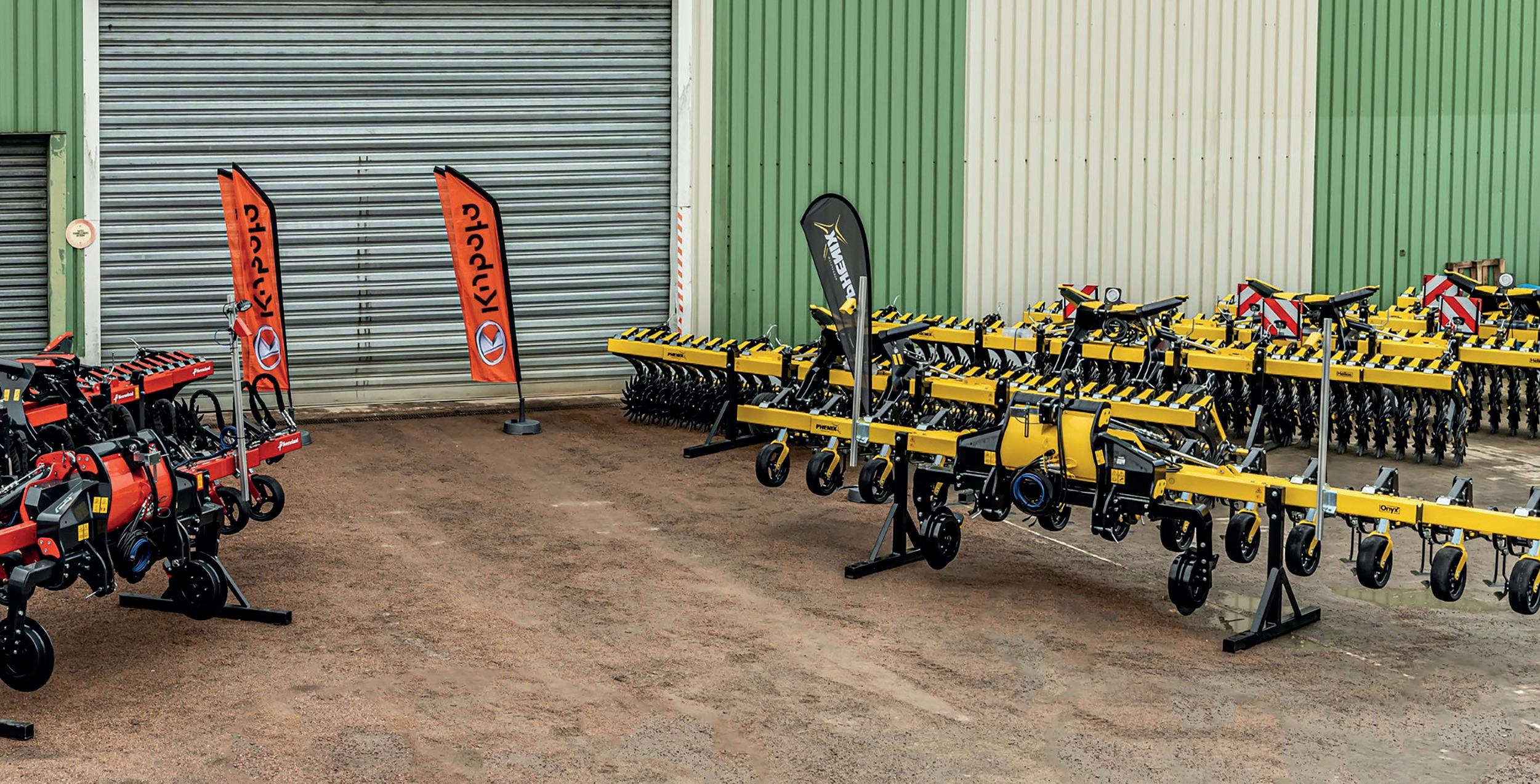
Grant possibilities
JWith growing pressure on the industry to create solutions around farm sustainability and integrated pest management (IPM) practices, Defra announced a second round of grants under the Farming Equipment and Technology Fund earlier this year.
Aimed to improve agricultural efficiency, the first stage of

This system allows the use of a colour self-scanning steering system on new and existing machines.
Precision
Claiming greater precision, the high-tech X-Green guidance headstock provides an interface capable of operating two colour selfscanning camera systems. Product specifications and pricing details of the new Kverneland range are still to be announced, with the first models expected to arrive during spring 2023.
applications close on April 4. It offers competitive grant funding for specific items, spilt across two key grant areas of productivity and slurry management.
Equipment eligible under this funding includes three- and sixmetre precision camera-guided inter-row hoeing systems under categories FETF6 and FETF7.
63
APRIL 2023
WEED CONTROL MACHINERY
Phenix inter-row cultivators, rotary hoes, guidance interfaces and tine harrows will now be available as Kverneland-branded equipment.
MATTCulley
Oilseed rape prices may now be below the cost of production
How things have changed in the last couple of weeks. After starting to worry about how dry it was here in Hampshire during February, early March has seen snow, storms, and quite a bit of rain.
While much of the drilling was completed before things turned, there’s plenty still to do as growers who have cover crops or planned to apply much-needed manures to their soils are having to be a little more patient.
Over the past few weeks, a group from across the cereals supply chain has been working on the Digital Grain Passport (DGP).
It’s a topic I’ve written about before, and which many growers ask about as I go around the country and to regional meetings.
After the presentations and meetings about
About the author
r
rThe family also runs a pick-your-own soft fruit and summer vegetables business
the DGP at the end of last year, several industry bodies raised questions about the proposals and sought changes to how the proposed DGP could work. This prompted a rethink, and since then there has been a renewed effort to see if these can be addressed.
AHDB has sought greater involvement from representative bodies and established a leadership group to provide this, along with other groups being created to shape the development and communication of a renewed business plan, and digital grain passport.
There’s a long way to go, but NFU has long supported the principle of a DGP if it offers a genuine benefit to growers.
For some, that will be the fast two-way flow of data, but for others, it might just be that a single ‘industry owned’ DGP will be much more straightforward in the long-term than fragmented merchant or supply chain-specific systems which growers have no say in.
But to work, the DGP will have to be simple, resilient, and focused on creating a digital version of the paper passport.
There’s much work still to be done, but everyone in the leadership group is committed to creating a practical and effective DGP and have already committed considerable hours of time to doing so.
One thing I’m sure most of us are watching is the state of commodity and fertiliser markets, especially as they don’t seem to be keeping pace with each other.
While it is good news that fertiliser prices have fallen, this has prompted many to lament
having bought just before the latest offers and feel caught out by some very large price movements.
I’m also continuing to hear complaints about price offers being issued, then withdrawn a short while later.
While we all accept the energy market is far from easy for any manufacturer or importer, we really do need more transparency in what is likely to be available, so growers can plan without the pressure to rush to purchase in case it’s not available a short while later.
However, it’s not just inputs that have fallen. As I write in mid-March, commodity prices are falling for a whole range of global and domestic reasons.
Oilseed rape in particular has been under considerable pressure. It’s always dangerous writing about prices given the near certainty they will have moved by the time this lands through your letterbox, but for OSR, these may well now be below the cost of production.
This only complicates the decisions farmers have to make about how much fertiliser to apply or, worst of all, whether to continue with a flea beetle-damaged crop or take the plunge and re-drill while they can.
This is one situation where I’d be very happy to have people tell me my column is out of date.
I’m truly hopeful that, by the time you read this, our OSR crops are in good condition and growers have confidence in our much-needed break crop, and that we are maintaining UK production while benefiting pollinators and our important domestic crush capacity.

64 APRIL 2023 TALKING POLICY
rNFU crops board chairman Matt Culley is a fourth-generation farmer from Hampshire working in partnership with his parents and brother
The 720-hectare enterprise produces wheat, barley, oilseed rape, forage maize and rye for anaerobic digestion across varying soil types, from chalk and chalk loam to clay cap. This includes 170ha of owned and rented land and 540ha of contract farming agreements
What is the future for agricultural water use?
should and are taking seriously.
In this episode of Crop it Like it’s Hot, the Arable Farming team delves into the world of water policy, application and economics to find out: how can we make UK agriculture more water-secure?
ith the UK seeing long periods of no rainfall almost annually, and changes to abstraction licensing and planning restrictions on water storage threatening to compound the issue, water security in agriculture is a concern many growers

More information

JThe Crop it Like it’s Hot podcast is produced by Arable Farming and CropTec Show. Released monthly, the show sees the Arable

Tune in to hear three industry experts share their views on effective water-saving models, whether the Government really wants to safeguard water supply in agriculture, and how irrigation prospects are looking for the season ahead.
WSpeakers:
rKelly Hewson-Fisher – NFU national water resources specialist

rProf Jerry Knox – Professor of agricultural water management, Cranfield University

rDaniel Johns – managing director, Water Resources East
Farming team talk to a range of arable experts to provide an alternative way of keeping up with agronomy and the latest arable developments.
Get CPD points
JMembers of the BASIS register can receive one CPD point for tuning into the podcast. Listen in to the podcast to find out how.
Find Jobs Faster
Receive
JThe show can be downloaded via croptecshow.com/crop-it-likeits-hot-podcast, or you can listen through Apple Podcasts or Google Podcasts. For more about our podcasts, email podcasts@agriconnect.com



65 PODCAST APRIL 2023
Kelly Hewson-Fisher
Daniel Johns
Prof Jerry Knox
Listen in BROUGHT TO YOU BY... JobsInAgriculture Jobs in your field Let us keep you updated by email and never miss another great job JobsInAgriculture.com
the latest jobs in your inbox with our free email alert service
BASIS news Spotlight on farm safety
The latest news for BASIS and FACTS-qualified farmers and advisers.

Anew BASIS Classroom module dealing with the vital issue of farm safety was launched in February to provide a wide-ranging overview of the topic that will appeal not just to farmers, but also to agronomists and others in the supply chain.
Sadly, the issue remains topical. While agriculture accounts for just 1.5% of the UK workforce, it accounts for 20% of the total fatalities reported to the Health and Safety Executive (HSE). Similarly, while the average of all workers for reported injuries is 1.6%, for people in the farming industry the figure is 4%.
Information
As with all BASIS Classroom topics, the health and safety module provides information in readily assimilated packages with multiple choice questions interspersed to assess learning. Hyperlinks give access to further information including relevant information from HSE and the Farm Safety Foundation (Yellow Wellies).
“This is a high-level awareness course,” says BASIS head of digital learning Tanya Kesterton. “The aim is to reinforce the need to take health and safety issues seriously all the time.

“User feedback in the first two weeks has been encouraging with






some 80% of participants rating it as good or excellent.”
The topics covered include mental health and well-being – an important issue given so many farmers and farm workers are lone working for much of their time. Also the reluctance to talk about issues of concern.
The need to identify risks is dealt with, stressing the importance of always being alert to potential risks. This is not so much about form filling, but applying common sense and asking ‘what if?’ in everyday operations.
Other topics include biological hazards and the potential harm from exposure to sunlight. It is estimated that avoiding exposure between the peak hours of 11am to 3pm or and use of sun blocking creams could prevent nine out of 10 instances of skin cancer.
Safe driving and taking care with moving machinery is another area where many accidents and injuries could be avoided by paying more attention to the potential risks both in the field and the yard.

For agronomists, another profession where lone working is the norm, there is a section of advice for how to deal with apparent risks and hazards that they see as they visit farms. This ranges from making diplomatic comments to being more forceful when issues are not resolved on subsequent visits.
This BASIS Classroom module is sponsored by agronomy company Agrii, a business that takes these matters seriously.
Commits
Petra Martin, group head of health and safety at Agrii, says: “Our company health and safety policy not only addresses the needs of our employees, but also commits to care for the well-being and safety of our customers and the agricultural industry generally.

“This is why we have supported this initiative as well as the earlier module dealing with mental health which BASIS developed in conjunction with the Farming Community Network.”
BASIS Classroom can be accessed by BASIS members via the BASIS website – basis-reg.co.uk. Those who complete the module successfully are entitled to claim CPD points to achieve their annual requirements to remain on the professional register.
MORE ONLINE
66 APRIL 2023
The aim is to reinforce the need to take health and safety issues seriously all the time
TANYA KESTERTON
BASIS head of digital learning Tanya Kesterton.
Farming industry-reported injuries are 2.4% above the 1.6% UK average.
Vox Conference Centre, Birmingham
October 19, 2023




SHOWCASING THE BEST AND BRIGHTEST FARMING TALENT
ENTRIES AND NOMINATIONS ARE NOW OPEN









ENTER TODAY
To enter for yourself or to nominate someone, scan the QR code below or visit:
enter.britishfarmingawards.co.uk
Entries close June 23, 2023

There are infinite reasons to support our farmers, who all provide an invaluable service for the ever-growing population and the British Farming Awards are back for 2023 to celebrate the people at the heart of agriculture.


You can enter for yourself, or you can nominate someone you believe deserves recognition for their outstanding contribution to UK agriculture.
Sponsored by

Find out more
britishfarmingawards.com





November 29-30, 2023
NAEC Stoneleigh, Warwickshire
2023 new venue announced!
The CropTec Show will be relocating to NAEC Stoneleigh, Warwickshire, for November 2023.






The East of England Showground, Peterborough, announced its closure early this year, but the success of The CropTec Show will be brought to the NAEC Stoneleigh, continuing to serve exhibitors and visitors and provide even more opportunities following the success of the 10th anniversary show in November 2022.
Key factors of the new location

Set in a countryside venue in the heart of England
Easily accessible via road and rail

Free car parking for more than 30,000 cars
A showcase for the future of farming
Chosen by exhibitors as the new home of The CropTec Show

Visit croptecshow.com for more information




















































































































































































































































































































































































































































































































 James Huyton reports.
James Huyton reports.














































